Michael Lin exhibition view
GU DEXIN 顾德新
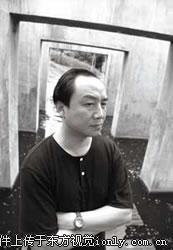
Gu Dexin (1962 Beijing) is perhaps the most avant-garde and radical of China’s leading contemporary artists. Although he did not formally study art, Gu Dexin quickly made a name for himself in the late 1980s with his strange, colorful portraits of alien beings and provocative experiments altering and reshaping plastics and other materials. In 1989, his work was already being shown in the Pompidou Centre in Paris. And since then this eminently uncollectible artist has broken every conceivable convention by using blow torches and other tools to reshape plastics, raw meat and fruits and vegetables. Decay is a central feature of many of his works. And some critics say he is showing the ugliness behind lofty ideals. His installations also sometimes feature sex objects carved out of meat and what appear to be piles of debris or reshaped plastics filled with dye. Experts say Gu Dexin’s art is a provocative statement about vulgarity and decay in the modern world; and that his works are a rejection of standard ideas of art. He is one of the few Chinese artists who avoids Chinese symbols. And he probably does the least to explain or market his works.
Gu Dexin Biography
1962 Born in Beijing, China
1987 Formed "Tactile Sensation Group"
1988 Stoped the activities of "Tactile Sensation Group" and formed "New Analysts Group" with Chen Shaoping and Wang Luyan
1995 Dissolved "New Analysts Group"
Lives and works in Beijing
Selected Exhibitions
2006 "March 4, 2006", Galerie Urs Meile, Lucerne, Switzerland (solo)
2005 Majong - Chinesische Gegenwartskunst aus der Sammlung Sigg" Kunstmuseum Bern, Switzerland
2005 "Between Past and Future: New Photography and Video from China", Seattle Art Museum, Seattle
2005 "Between Past and Future: New Photography and Video from China", Museum of Conremporary Art Chicago, Chicago, USA
2005 "Between Past and Future: New Photography and Video from China", The David and Alfred Smart Museum of Art, Chicago, USA
2004 "All under heaven" MuHKA , Museum of Contemporary Art of Antwerp, Belgium
2004 "Black Show" Noanoa Center, Xian, China
2004 "Between Past and Future: New Photography and Video from China", ICP International Center of Photography, New York, USA
2003 Chinse maximalism, Millennium Art Museum, Beijing
2003 Dreams and conflicts, La Biennale di Venezia, Venice
2002 Making China, Ethan Cohen Fine Arts, New York, U.S.A
2002 PAUSE, Gwangju Biennale2002, Gwangju, Korea
2002 Too Much Flavour, 3Hart center, Shanghai, China
2002 New Stage for Chinese Contemporary Art, International Exhibition Centre for science and Technology Beijing
2002 Food, Sex&Human Nature, Gallery Artside Seoul, Korea
2002 The First Guangzhou Triennial, Reinterpretation:a Decade of Experimental Chinese Art (1990-2000) Guandong Museum of Art
2001 "Multimedia Art Festival", Loft, Beijing, China
2001 "Living in Time", Hamburger Bahnhof, Berlin, Germany
2001 Dialogue Avec Dali, Shanghai Mart Shanghai
2001 Chengdu Biennale, Chengdu Contemporary Art Museum, Chengdu,China
2001 Transplantatatation in situ, The Fourth Shenzhen Contemporary Sculpture Exhibition, Shenzhen, China
2000 "Food as Arts", Club Vogue, Beijing, China
2000 "Documentation of Chinese Avant-Garde Art in 90s", Fukuoka Asian Art Museum, Fukuoka, Japan
2000 "Post-material: Interpretations of Everyday Life by Contemporary Chinese Artists", Red Gate Gallery, Beijing, China
2000 "**** Off", Eastlink Gallery, Shanghai, China
2000 "About Me - Chinese Conceptual Photography Exhibition", New Vision Gallery, Shanghai,
2000 The Art Museum of Yunnan Art Institute, Kunming, China
2000 "Gu Dexin 1.8.2000", Loft, Beijing, China (solo)
2000 "Unsual & Usual - Contemporary Art Exhibition", Yuangong Modern Art Museum, Shanghai, China
2000 "Lights are on but nobody is home", DDM Warehouse, Shanghai, China
2000 "Installations-Performnce-Video Versus Painting Exhibition", Lang Tao Gallery, Beijing, China
2000 "Passe-Murailles: Nouvelles scenes de L'art contemporain chinois", Musee de Picardie, Amiens, France
1999 "Video Circle", Hong Kong University of Science and Technology Exhibition Hall, Hong Kong
1999 "Innovations Part II", China Art Archives and Warehouse (CAAW), Beijing, China
1999 "Poly Phenolrene", The Bow Gallery, Beijing, China
1999 "Bird Beast Fruit Flower", Galerie Martini, Hong Kong
1999 "Installations – Asian Artists in Residence", Mattress Factory, Pittsburgh, U.S.A
1999 "Collection from Modern Chinese Art Foundation", Provinciaal Centrum voor Kunsten
1999 Cultuur te Gent, Belgium
1998 "Trace of Existence - A Private Showing of China Contemporary Art ’98 Art", Now Studio, Beijing, China
1998 "The Bridge Construction in Process VI", Melbourne, Australia
1998 "Beelden Buiten '98 - I Nerer Promised You a Rose Garden", Tielt, Belgium
1998 "Site of Desire 1998", Taipei Biennial, Taipei Fine Arts Museum, Taiwan
1998 "Inside Out: New Chinese Art", Asian Society and P.S.1 Art Center, New York, San Francisco Museum of Modern Art, San Francisco, U.S.A
1998 "Corruptionists in Beijing", Beijing, China
1997 "Another Long March - Chinese Conceptual Art 1997", Fundament Foundation, Chasse Kazerne, Breda, The Netherlands
1997 "Aus Der Vr China Zeitgenossische Fotokunst", New Berlin Art Society (NBK), Berlin, Germany
1996 "Shelter", Fundament Foundation, Wolfslaar, Breda, The Netherlands
1996 "4 Points de Recontre Chine", Galerie de France, Paris, France
1996 " '96 International COM – Art", Suwon, Korea
1995 "Asiana-Contemporary Art from the Far East", Casino, Venice, Italy
1995 "Analysts III" exhibited in "Uecker Sends a Letter to Beijing", New Berlin Art Society (NBK), Berlin, Germany
1995 "Analysts IV" exhibited in "Configura 2 Dialog der Kulturen", Galerk am Fischmarkt, Erfurt, Germany
1995 "Analysts V" exhibited in "Out of the Middle Kindom Chinese Avant-garde Art", Santa Monica Art Center, Barcelona, Spain
1995 "Triennale Kleinplastik", Ostasien, Germany
1994 "94 Beijing International COM-Art Show China Korea Japan", the Gallery of Capital Normal 94 Beijing International COM-Art Show China Korea Japan", the Gallery of Capital Normal University, Beijing, China
1994 "Chinese Contemporary Artists' Agenda 1994", a printed media exhibition, China
1993 "China Avant-garde", Haus der Kulturen, Berlin, Germany; Kunsthal, Rotterdam, Holland; Museum Of Modem Art, Oxford, U. K.; Kunsthallen Brandts Klaedefabrik, Odense, Denmark
1993 "China's New Art Post 1989", Hong Kong Arts Centre, Hong Kong
1993 "Tomorrow's Art" - "Viewpoints", former San Matteo Hospital, Spoleto, Italy
1993 "Gu Dexin 10.6.1993", Galerie Arnaud Lefebvre, Paris, France (solo)
1992 "Gu Dexin/Huang Yongping/Zhang Peili", Galerie Arnaud Lefebvre, Paris, France
1991 "Analysts II" exhibited in "Exceptional Passage - China Avant-garde Artists Exhibition" Fukuoka, Japan
1990 "Next Phase", London Docks, London, U.K.
1990 "Analysts I", New Analysts Group's Workshop, Beijing, China
1989 "China Modem Art Exhibition", China Art Gallery, Beijing, China
1989 "Les Magiciens de la Terre", Center Georges Pompidou, Paris, France
1988 "Beijing - New York", Newhouse Center for Contemporary Art, Snug Harbor Cultural Center, Staten Island, New York, Nielsen Gallery, Boston, U.S.A.
1986 "Gu Dexin’s Works", International House, Beijing, China (solo)
1985 "Scrawls", Chaoyang Theater, Beijing, China
Literature
2007 China Art Book. Uta Grosenick / Caspar Schübbe (Ed.), 680 pages, approx. 850 images, trilingual: Engl./Ger./Chin., Dumont Buchverlag, Cologne 2007. www.chinaartbook.de

Gu Dexin (1962 Beijing) is perhaps the most avant-garde and radical of China’s leading contemporary artists. Although he did not formally study art, Gu Dexin quickly made a name for himself in the late 1980s with his strange, colorful portraits of alien beings and provocative experiments altering and reshaping plastics and other materials. In 1989, his work was already being shown in the Pompidou Centre in Paris. And since then this eminently uncollectible artist has broken every conceivable convention by using blow torches and other tools to reshape plastics, raw meat and fruits and vegetables. Decay is a central feature of many of his works. And some critics say he is showing the ugliness behind lofty ideals. His installations also sometimes feature sex objects carved out of meat and what appear to be piles of debris or reshaped plastics filled with dye. Experts say Gu Dexin’s art is a provocative statement about vulgarity and decay in the modern world; and that his works are a rejection of standard ideas of art. He is one of the few Chinese artists who avoids Chinese symbols. And he probably does the least to explain or market his works.
Gu Dexin Biography
1962 Born in Beijing, China
1987 Formed "Tactile Sensation Group"
1988 Stoped the activities of "Tactile Sensation Group" and formed "New Analysts Group" with Chen Shaoping and Wang Luyan
1995 Dissolved "New Analysts Group"
Lives and works in Beijing
Selected Exhibitions
2006 "March 4, 2006", Galerie Urs Meile, Lucerne, Switzerland (solo)
2005 Majong - Chinesische Gegenwartskunst aus der Sammlung Sigg" Kunstmuseum Bern, Switzerland
2005 "Between Past and Future: New Photography and Video from China", Seattle Art Museum, Seattle
2005 "Between Past and Future: New Photography and Video from China", Museum of Conremporary Art Chicago, Chicago, USA
2005 "Between Past and Future: New Photography and Video from China", The David and Alfred Smart Museum of Art, Chicago, USA
2004 "All under heaven" MuHKA , Museum of Contemporary Art of Antwerp, Belgium
2004 "Black Show" Noanoa Center, Xian, China
2004 "Between Past and Future: New Photography and Video from China", ICP International Center of Photography, New York, USA
2003 Chinse maximalism, Millennium Art Museum, Beijing
2003 Dreams and conflicts, La Biennale di Venezia, Venice
2002 Making China, Ethan Cohen Fine Arts, New York, U.S.A
2002 PAUSE, Gwangju Biennale2002, Gwangju, Korea
2002 Too Much Flavour, 3Hart center, Shanghai, China
2002 New Stage for Chinese Contemporary Art, International Exhibition Centre for science and Technology Beijing
2002 Food, Sex&Human Nature, Gallery Artside Seoul, Korea
2002 The First Guangzhou Triennial, Reinterpretation:a Decade of Experimental Chinese Art (1990-2000) Guandong Museum of Art
2001 "Multimedia Art Festival", Loft, Beijing, China
2001 "Living in Time", Hamburger Bahnhof, Berlin, Germany
2001 Dialogue Avec Dali, Shanghai Mart Shanghai
2001 Chengdu Biennale, Chengdu Contemporary Art Museum, Chengdu,China
2001 Transplantatatation in situ, The Fourth Shenzhen Contemporary Sculpture Exhibition, Shenzhen, China
2000 "Food as Arts", Club Vogue, Beijing, China
2000 "Documentation of Chinese Avant-Garde Art in 90s", Fukuoka Asian Art Museum, Fukuoka, Japan
2000 "Post-material: Interpretations of Everyday Life by Contemporary Chinese Artists", Red Gate Gallery, Beijing, China
2000 "**** Off", Eastlink Gallery, Shanghai, China
2000 "About Me - Chinese Conceptual Photography Exhibition", New Vision Gallery, Shanghai,
2000 The Art Museum of Yunnan Art Institute, Kunming, China
2000 "Gu Dexin 1.8.2000", Loft, Beijing, China (solo)
2000 "Unsual & Usual - Contemporary Art Exhibition", Yuangong Modern Art Museum, Shanghai, China
2000 "Lights are on but nobody is home", DDM Warehouse, Shanghai, China
2000 "Installations-Performnce-Video Versus Painting Exhibition", Lang Tao Gallery, Beijing, China
2000 "Passe-Murailles: Nouvelles scenes de L'art contemporain chinois", Musee de Picardie, Amiens, France
1999 "Video Circle", Hong Kong University of Science and Technology Exhibition Hall, Hong Kong
1999 "Innovations Part II", China Art Archives and Warehouse (CAAW), Beijing, China
1999 "Poly Phenolrene", The Bow Gallery, Beijing, China
1999 "Bird Beast Fruit Flower", Galerie Martini, Hong Kong
1999 "Installations – Asian Artists in Residence", Mattress Factory, Pittsburgh, U.S.A
1999 "Collection from Modern Chinese Art Foundation", Provinciaal Centrum voor Kunsten
1999 Cultuur te Gent, Belgium
1998 "Trace of Existence - A Private Showing of China Contemporary Art ’98 Art", Now Studio, Beijing, China
1998 "The Bridge Construction in Process VI", Melbourne, Australia
1998 "Beelden Buiten '98 - I Nerer Promised You a Rose Garden", Tielt, Belgium
1998 "Site of Desire 1998", Taipei Biennial, Taipei Fine Arts Museum, Taiwan
1998 "Inside Out: New Chinese Art", Asian Society and P.S.1 Art Center, New York, San Francisco Museum of Modern Art, San Francisco, U.S.A
1998 "Corruptionists in Beijing", Beijing, China
1997 "Another Long March - Chinese Conceptual Art 1997", Fundament Foundation, Chasse Kazerne, Breda, The Netherlands
1997 "Aus Der Vr China Zeitgenossische Fotokunst", New Berlin Art Society (NBK), Berlin, Germany
1996 "Shelter", Fundament Foundation, Wolfslaar, Breda, The Netherlands
1996 "4 Points de Recontre Chine", Galerie de France, Paris, France
1996 " '96 International COM – Art", Suwon, Korea
1995 "Asiana-Contemporary Art from the Far East", Casino, Venice, Italy
1995 "Analysts III" exhibited in "Uecker Sends a Letter to Beijing", New Berlin Art Society (NBK), Berlin, Germany
1995 "Analysts IV" exhibited in "Configura 2 Dialog der Kulturen", Galerk am Fischmarkt, Erfurt, Germany
1995 "Analysts V" exhibited in "Out of the Middle Kindom Chinese Avant-garde Art", Santa Monica Art Center, Barcelona, Spain
1995 "Triennale Kleinplastik", Ostasien, Germany
1994 "94 Beijing International COM-Art Show China Korea Japan", the Gallery of Capital Normal 94 Beijing International COM-Art Show China Korea Japan", the Gallery of Capital Normal University, Beijing, China
1994 "Chinese Contemporary Artists' Agenda 1994", a printed media exhibition, China
1993 "China Avant-garde", Haus der Kulturen, Berlin, Germany; Kunsthal, Rotterdam, Holland; Museum Of Modem Art, Oxford, U. K.; Kunsthallen Brandts Klaedefabrik, Odense, Denmark
1993 "China's New Art Post 1989", Hong Kong Arts Centre, Hong Kong
1993 "Tomorrow's Art" - "Viewpoints", former San Matteo Hospital, Spoleto, Italy
1993 "Gu Dexin 10.6.1993", Galerie Arnaud Lefebvre, Paris, France (solo)
1992 "Gu Dexin/Huang Yongping/Zhang Peili", Galerie Arnaud Lefebvre, Paris, France
1991 "Analysts II" exhibited in "Exceptional Passage - China Avant-garde Artists Exhibition" Fukuoka, Japan
1990 "Next Phase", London Docks, London, U.K.
1990 "Analysts I", New Analysts Group's Workshop, Beijing, China
1989 "China Modem Art Exhibition", China Art Gallery, Beijing, China
1989 "Les Magiciens de la Terre", Center Georges Pompidou, Paris, France
1988 "Beijing - New York", Newhouse Center for Contemporary Art, Snug Harbor Cultural Center, Staten Island, New York, Nielsen Gallery, Boston, U.S.A.
1986 "Gu Dexin’s Works", International House, Beijing, China (solo)
1985 "Scrawls", Chaoyang Theater, Beijing, China
Literature
2007 China Art Book. Uta Grosenick / Caspar Schübbe (Ed.), 680 pages, approx. 850 images, trilingual: Engl./Ger./Chin., Dumont Buchverlag, Cologne 2007. www.chinaartbook.de
Feeling, 1988
Concept art

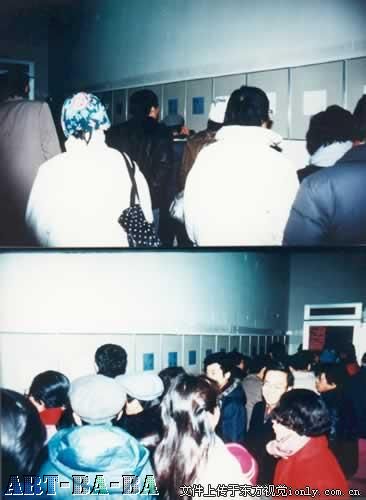

Concept art



1989
Installations made of melted pieces of plastic
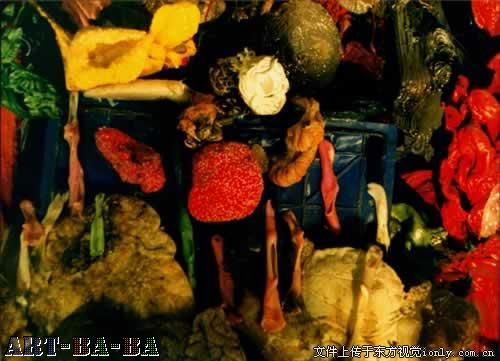
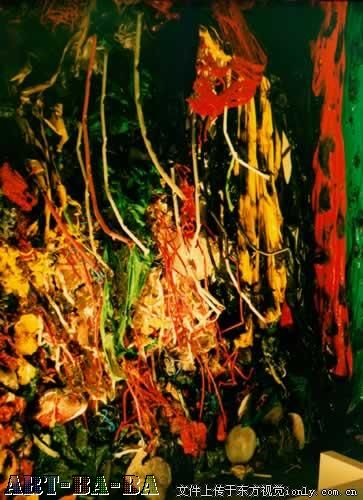
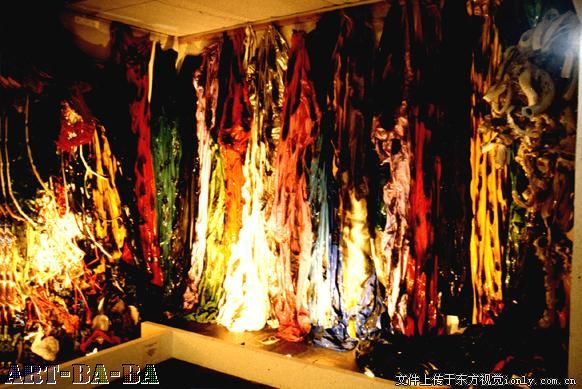

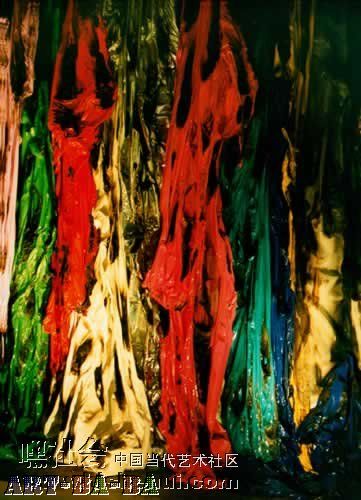
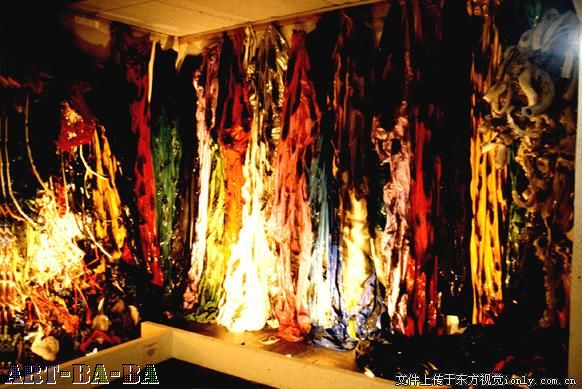
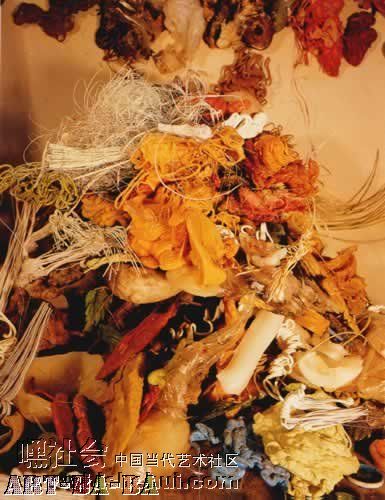
Installations made of melted pieces of plastic







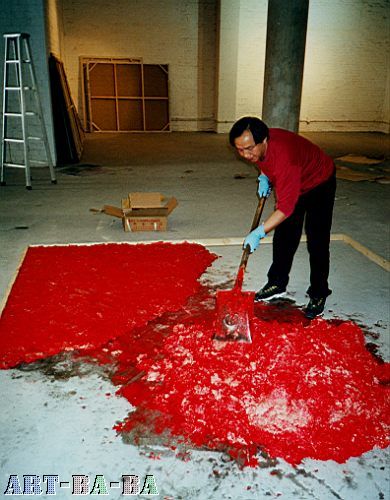
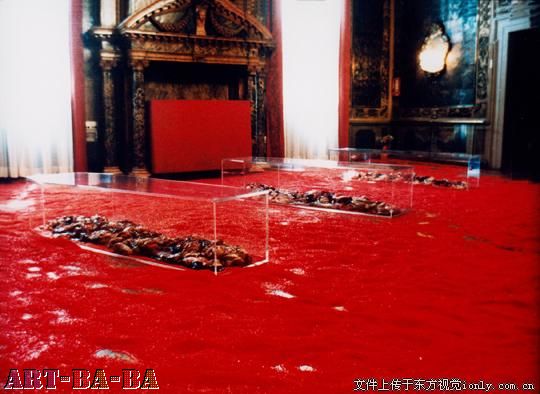
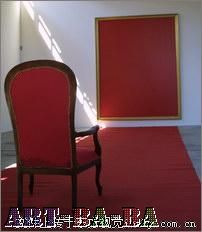
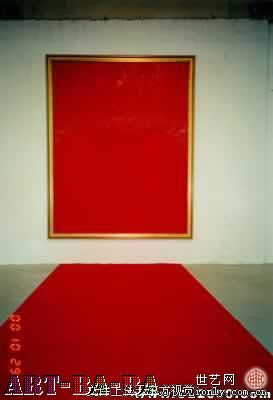
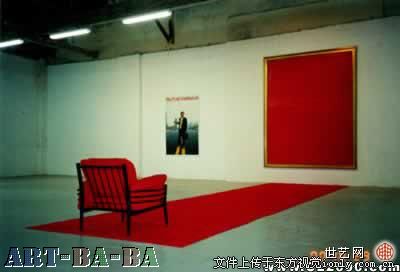
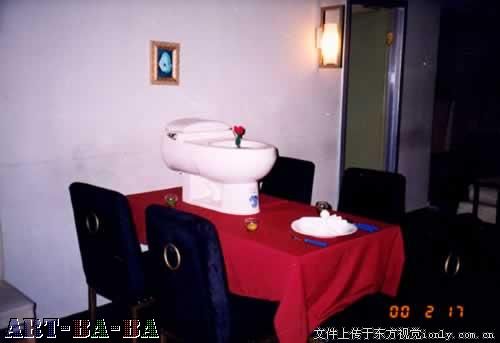
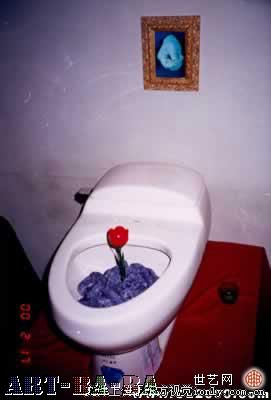
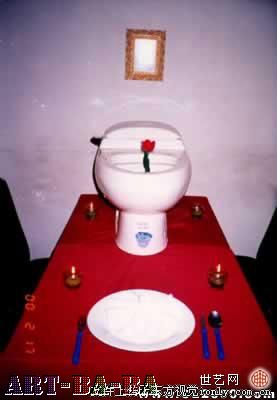

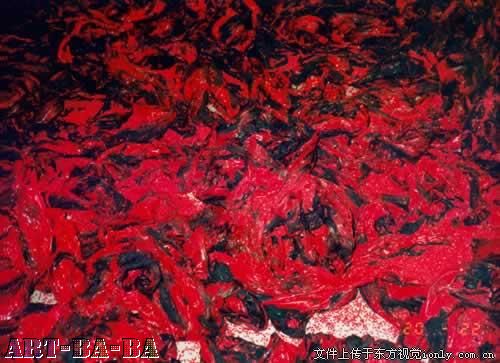
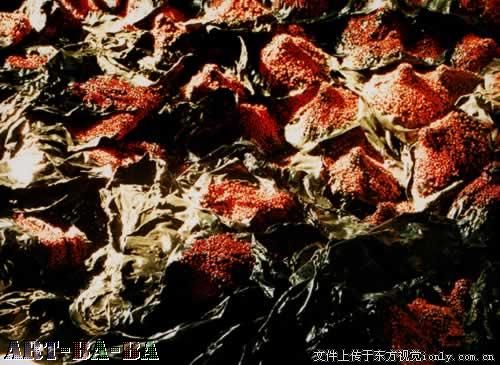

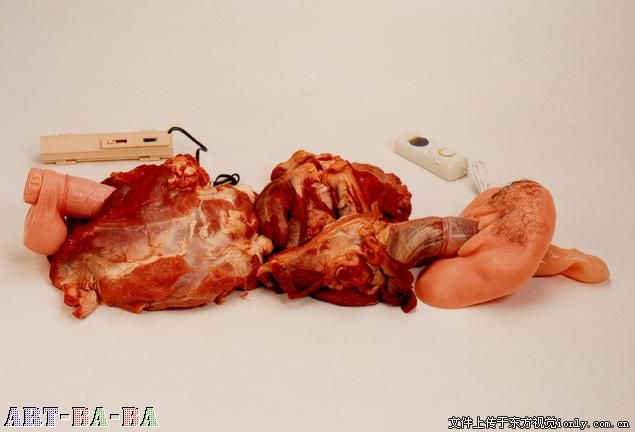
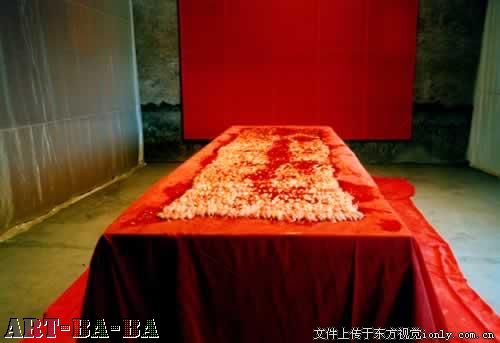
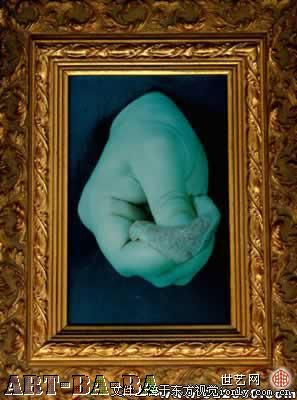

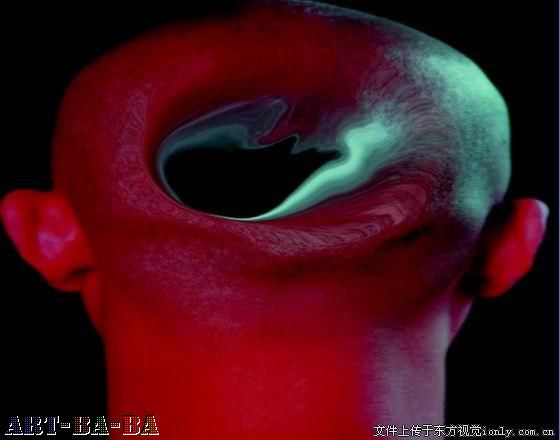


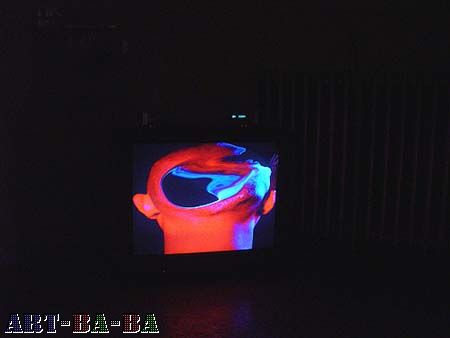
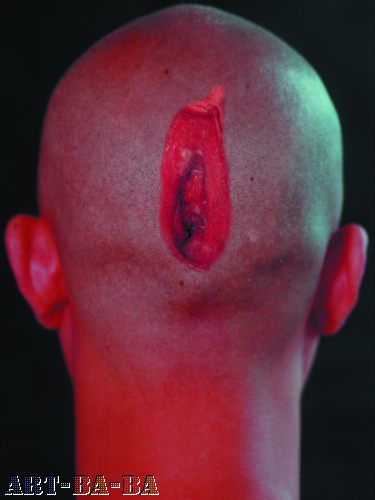
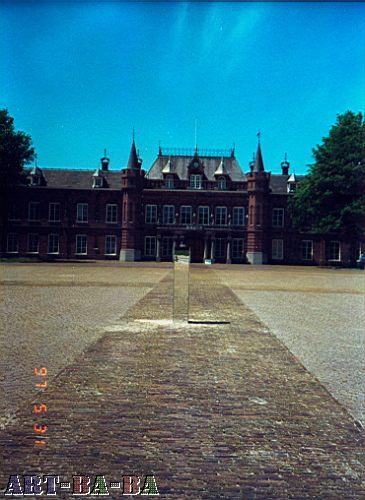
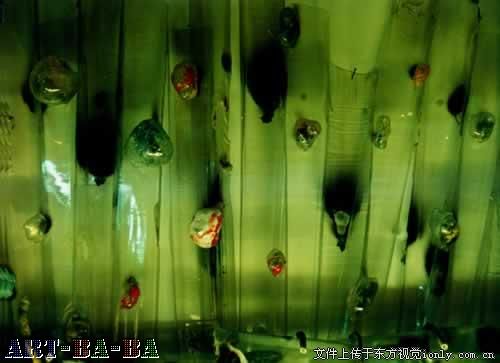
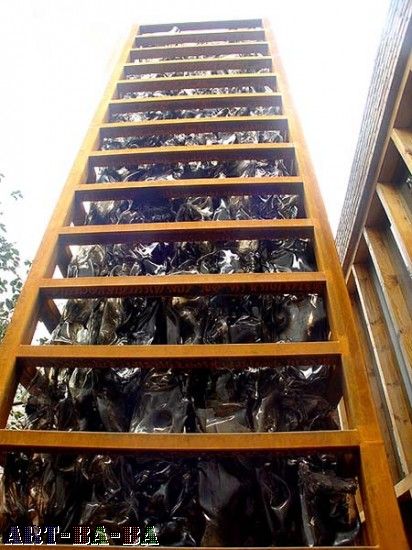
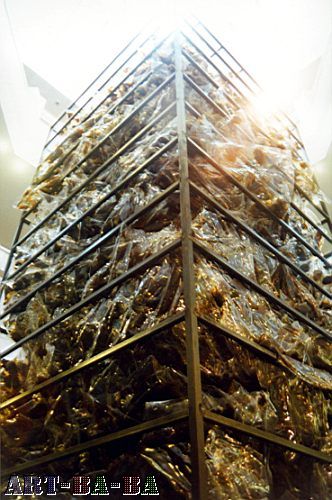
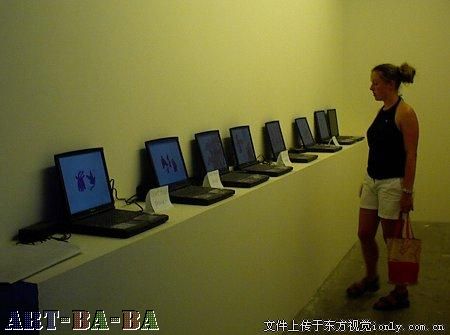
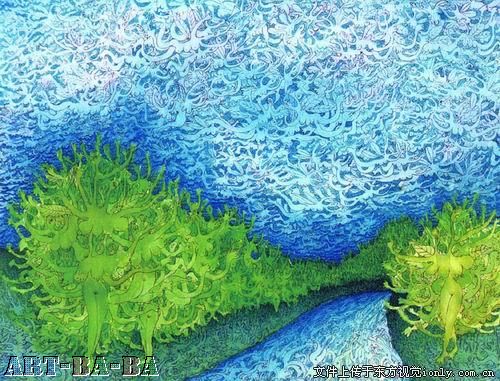
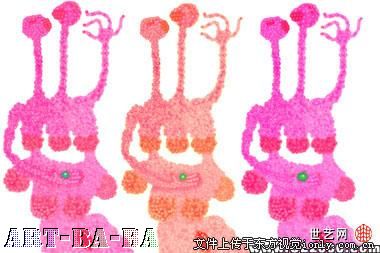
Gu Dexin found a girl in her ovulation period, took care of her alimentation and made love to her. He used her secretion to make some paint and wrote on the wall "Ten thousands years after October 15th, 2005, people are still there". Exhibition food and drinks were dispayed by the work, creating a relation to it.

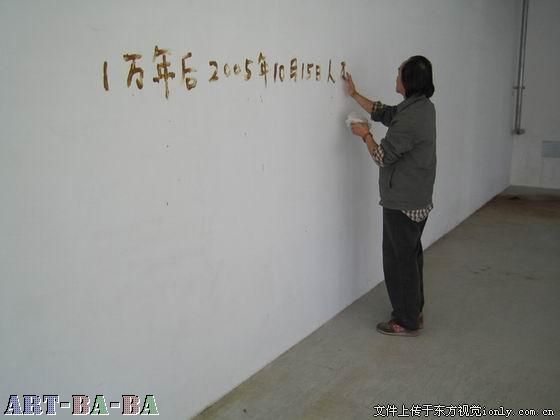
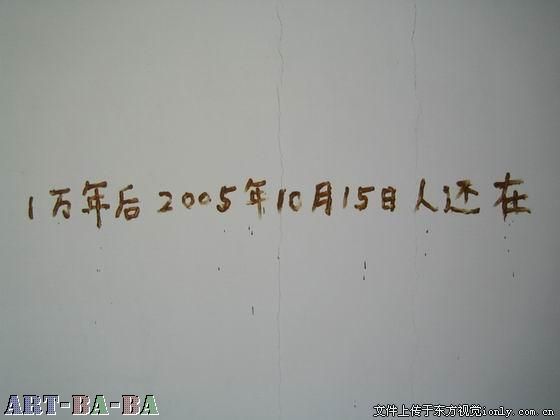



Sketches of project 1
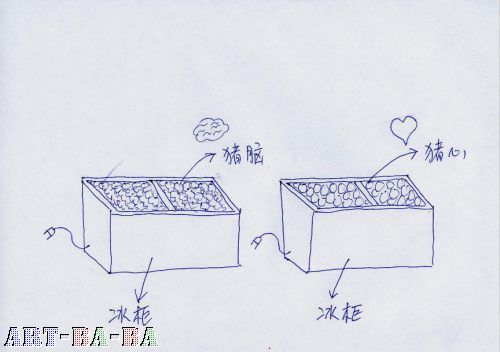
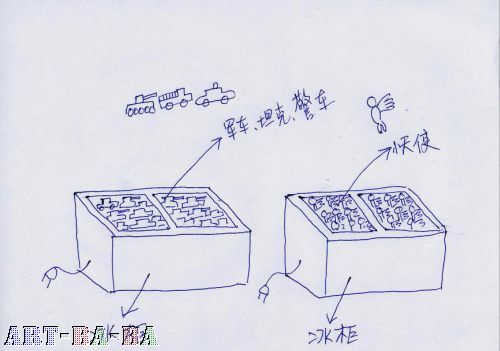

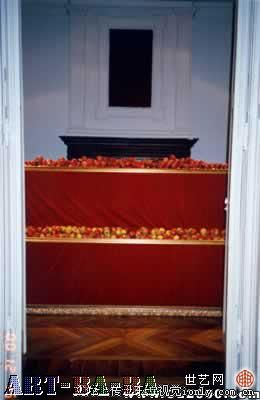
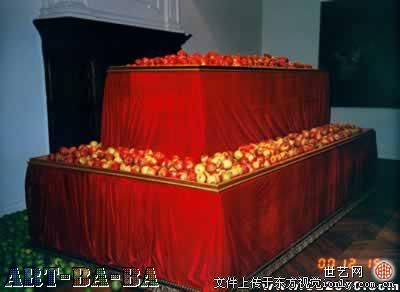
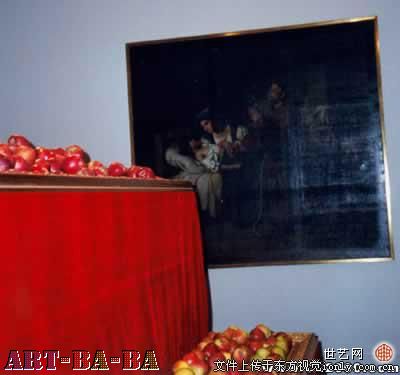
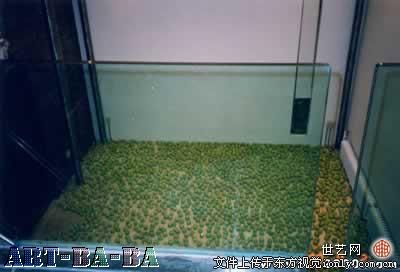
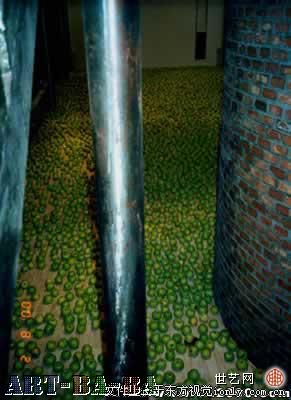
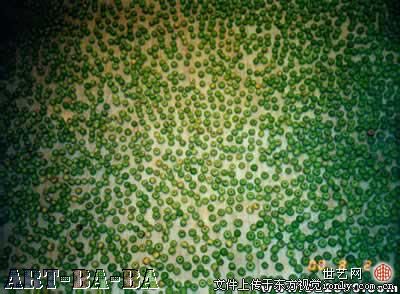
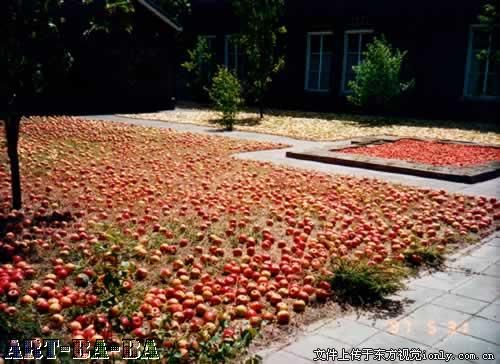
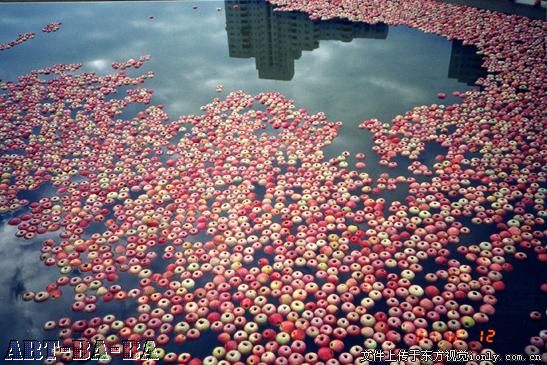











Installation presented in All Under Heaven, Mukha, Antwerp, Belgium.


The Monk and The Devil, Chinese contemporary art exhibition
Musee d'art contemporain de Lyon, France
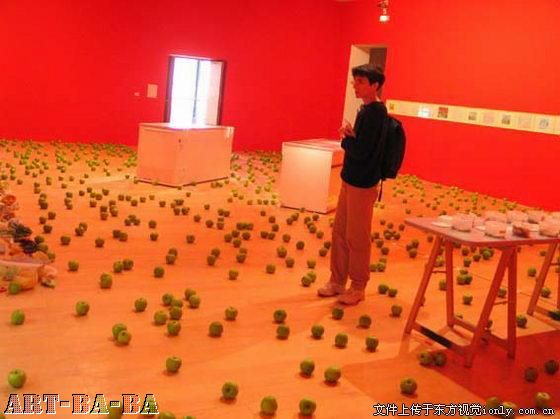
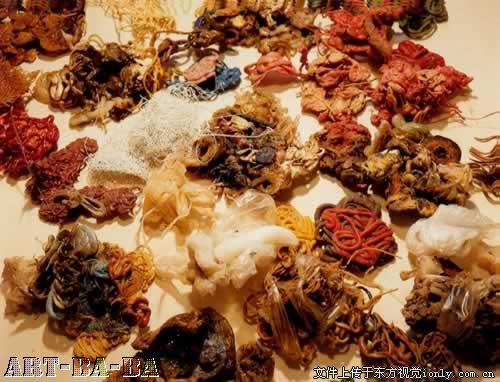
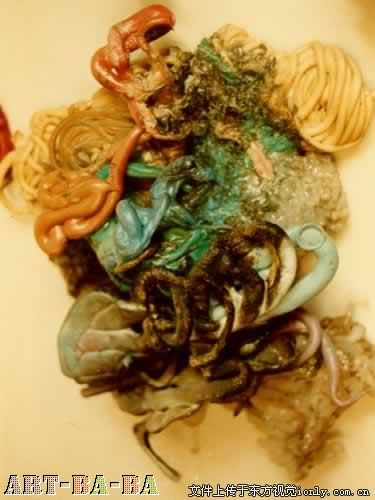
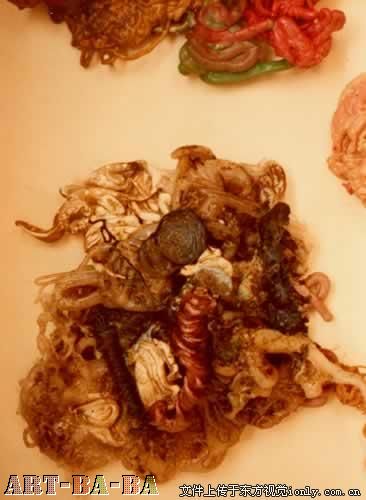
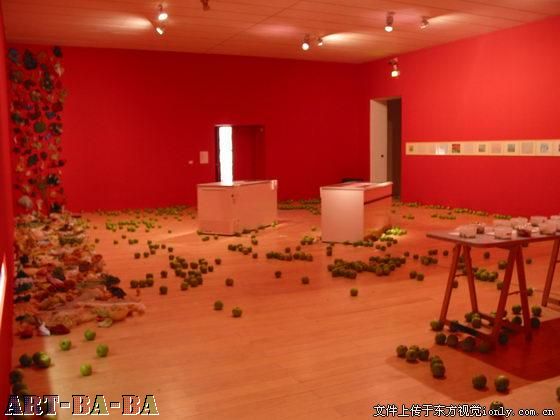
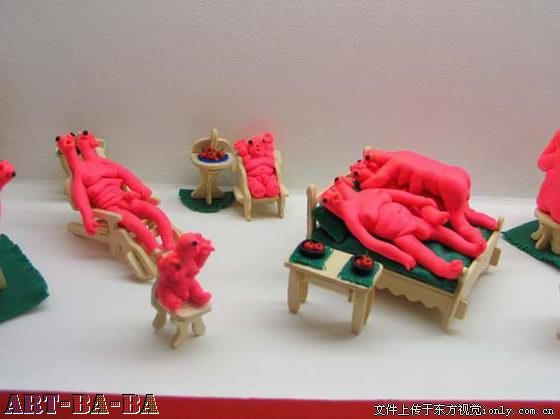
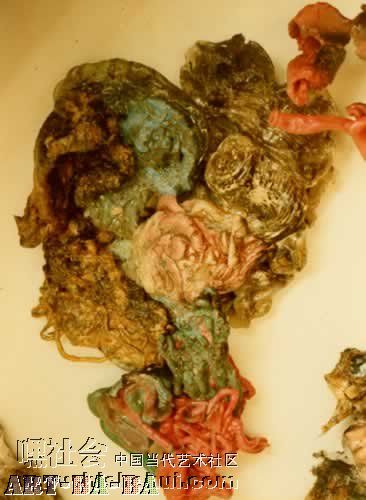
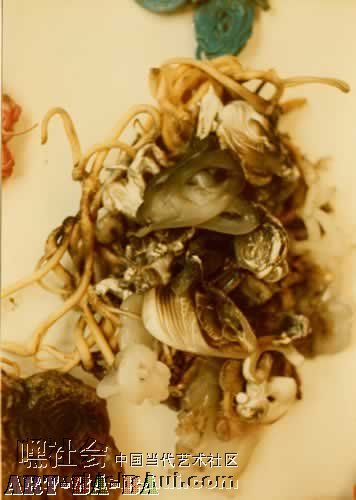
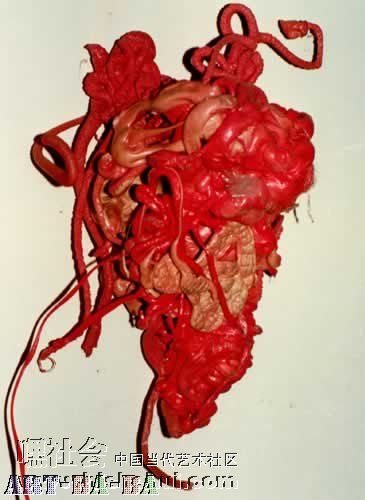


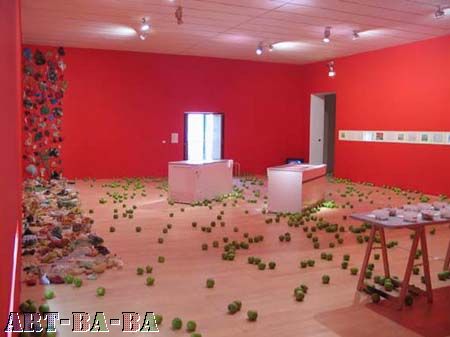
Musee d'art contemporain de Lyon, France












Installation...

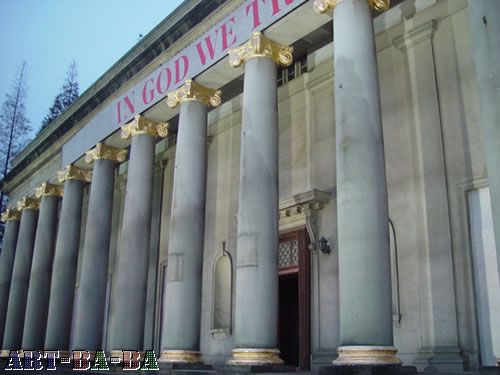


Exhibition at Shanghai Gallery of Art, 3 on the Bund
2005

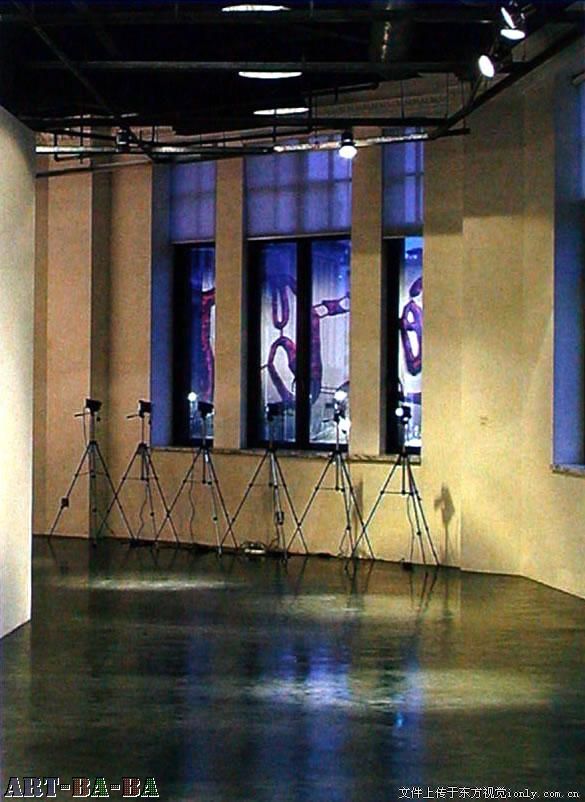



2005





Return of the Unreal: Gu Dexin’s Installation
Return of the Unreal: A Review of Gu Dexin’s Installation 2007.04.14 at The Shanghai Gallery of Art
by Paul Gladston
As anyone familiar with the Shanghai Gallery of Art knows, it is a venue that continues to present significant challenges for the artists who are invited to show there. Although the gallery is for the most part an unadorned ‘white cube’ of the sort to be found in many major cities across the world, it also has two permanent architectural features which intervene powerfully in the ostensible neutrality of the space. One is an atrium bounded by substantial geometric columns faced with green marble to the left as one enters the gallery that cuts through the stories above in such a way that the resulting void narrows progressively to give a false, though still vertiginous, quasi-Piranesian sense of vastness. The other is a series of windows ranged along the far wall of the gallery that affords the visitor a truly spectacular view of the Huangpu River and the metropolitan skyline of Pudong; a view which in Western terms at least, along with that opened up by the gallery’s atrium, is arguably nothing short of sublime.
For artists exhibiting at the gallery there is, therefore, a persistent necessity to find some means by which these insistent architectural features and their attendant visions of sublimity can either be successfully down played (negated) or incorporated into some sort of critical dialogue with the work on display.
In Gu Dexin’s previous solo exhibition at the gallery, entitled 2005.03.05, the artist chose to engage with this inescapable architectural problematic in a characteristically challenging fashion by mounting a minor retrospective of sorts involving numerous objects and images culled largely from earlier installations and artworks. These included huge piles of rotting fruit (some of which served to partially obscure the outside view of the Shanghai Bund), nine chests of refrigerated pigs brains, a series of framed photographic images of meat in the process of being rubbed between the forefinger and thumb of a disembodied hand, a colossal metal flag pole laid out aimlessly along the floor, and a pair of empty red plinths (one occupying the centre of the gallery’s atrium).
As David Chan has indicated, Gu Dexin’s installation could therefore be understood to engage with its setting in two ways: first, by imposing a sense of combinatory excess analogous to the gallery’s assumed sublimity; and second, through the incorporation of ‘empty’ or ‘natural’ objects - the plinths and the flag pole, and the rotting fruit respectively - as means of undermining, by turns, the artificially staged conceits of the gallery’s atrium and the accelerated ‘hyperreality’ of the urban scene outside. The combined effect of all of which, according to Chan, was a deconstructive intervention not only upon un-reflexive attitudes to the (Westernized) institutional consecration of contemporary Chinese visual art (presumably amplified by the juxtaposition of what might be seen as the supplementarity of the postmodernist sublime with nods towards the ‘emptiness’ and ‘naturalness’ of a traditional Chinese aesthetic), but also upon continuing debates surrounding the role of visual art in China as a critical foil to the country’s official ideology of economic ‘openness’ and ‘progress’ (as self-consciously staged by the signature vision of the Pudong skyline).
Like its predecessor, Gu Dexin’s current installation at the Shanghai Gallery of Art, 2007.04.14, also pivots unavoidably on the problematic encounter between the work on display and the architecturally framed visions which lend the gallery its distinct sense of place. This time, however, we no longer encounter the multiple piling up of objects and images that competed for attention at the artist’s previous show. Instead, the viewer is faced by two newly installed architectural features: a specially constructed incline – vaguely reminiscent of Vito Acconci’s Seedbed - whose limits are continuous with those of the gallery’s usual floor space and which rises from the base of the wall nearest the entrance to join neatly with the lower edge of the windows at the far end of the gallery; and, a shallow, progressively deepening trough at the base of the gallery’s atrium which emerges from the opening left behind by the incline as it intersects with the outside edges of the atrium’s columns.
Moreover, the viewer is also presented with two further and readily discernible elaborations on this interventionist architectural thematic: first, that the incline has been completely covered by concrete slabs, manhole covers, and drains in imitation of the dusty surface of a Chinese urban pavement; and second, that scattered randomly across a floor of bright blue resin at the base of the trough are countless life-size models of fruit flies whose artificial wings sparkle with the reflected glare of the gallery’s electric lights. On close inspection the viewer may also note that behind the grills of the installation’s drain covers are numerous plastic maggots suspended inertly and somewhat obscurely in small pools of red resin.
The first impression of Gu Dexin’s current installation is therefore, by comparison with his last exhibition at the Shanghai Gallery of Art, one of a calculated restraint (an impression given added weight by the pristine cleanliness of the simulated pavement which is very much at odds with our everyday experience of its actual urban counterpart); so much so, in fact, that the aesthetic impact of the work would appear to have been self-consciously subordinated to the forceful sublimity of its surroundings. Indeed, the sheer insistence of the gallery’s sublime theatricality, which continually draws the gaze of the viewer, detracts from the visual immediacy of Gu Dexin’s work to such an extent that it may only be through very close and prolonged looking that its staging of a relationship between the openly displayed simulacra of flies and those of the partially hidden maggots is finally revealed to the viewer.
As such, this staging invites almost inevitable comparisons with Damien Hirst’s installation A Thousand Years. While it would be invidious to use such a comparison as an index of straightforward art-historical indebtedness given the near parallel progression of Damien Hirst’s and Gu Dexin’s careers as purveyors of artistic carnality, it is nevertheless possible to discern here a marked intertextuality between the powerful viscerality of Hirst’s earlier work and the rather insipid presence of Gu Dexin’s 2007.04.14. Despite the fact that both represent the same natural process they do so in markedly different ways: in Hirst’s case through the actual and dynamic presentation of the ‘ready-made’ life-cycle of the birth and transformation of maggots along with their subsequent death as flies; and in Gu Dexin’s the same as a static simulation brought about by the juxtaposition of artificial elements. What can therefore be drawn from such a comparison is that in relation to the arguably sublime otherness and incomprehensibility of Hirst’s installation, Gu Dexin’s presentation of a continuous cycle of life and death is one that has been placed self-consciously under suspension (‘sous-rature’). As a result of which, 2007.04.14 would - somewhat unexpectedly, perhaps, given Gu Dexin’s preceding reputation for bloody excess - appear to have been drained of any immediate or obvious aesthetic impact leaving behind in its wake what might be described from the locus of a Western post-Duchampian artworld as a lingering and indefinable whiff of ‘anaesthesia’.
The potential metaphorical significance of this apparently deliberate suspension of aesthetic immediacy is perhaps not too far to seek. The jux
Return of the Unreal: A Review of Gu Dexin’s Installation 2007.04.14 at The Shanghai Gallery of Art
by Paul Gladston
As anyone familiar with the Shanghai Gallery of Art knows, it is a venue that continues to present significant challenges for the artists who are invited to show there. Although the gallery is for the most part an unadorned ‘white cube’ of the sort to be found in many major cities across the world, it also has two permanent architectural features which intervene powerfully in the ostensible neutrality of the space. One is an atrium bounded by substantial geometric columns faced with green marble to the left as one enters the gallery that cuts through the stories above in such a way that the resulting void narrows progressively to give a false, though still vertiginous, quasi-Piranesian sense of vastness. The other is a series of windows ranged along the far wall of the gallery that affords the visitor a truly spectacular view of the Huangpu River and the metropolitan skyline of Pudong; a view which in Western terms at least, along with that opened up by the gallery’s atrium, is arguably nothing short of sublime.
For artists exhibiting at the gallery there is, therefore, a persistent necessity to find some means by which these insistent architectural features and their attendant visions of sublimity can either be successfully down played (negated) or incorporated into some sort of critical dialogue with the work on display.
In Gu Dexin’s previous solo exhibition at the gallery, entitled 2005.03.05, the artist chose to engage with this inescapable architectural problematic in a characteristically challenging fashion by mounting a minor retrospective of sorts involving numerous objects and images culled largely from earlier installations and artworks. These included huge piles of rotting fruit (some of which served to partially obscure the outside view of the Shanghai Bund), nine chests of refrigerated pigs brains, a series of framed photographic images of meat in the process of being rubbed between the forefinger and thumb of a disembodied hand, a colossal metal flag pole laid out aimlessly along the floor, and a pair of empty red plinths (one occupying the centre of the gallery’s atrium).
As David Chan has indicated, Gu Dexin’s installation could therefore be understood to engage with its setting in two ways: first, by imposing a sense of combinatory excess analogous to the gallery’s assumed sublimity; and second, through the incorporation of ‘empty’ or ‘natural’ objects - the plinths and the flag pole, and the rotting fruit respectively - as means of undermining, by turns, the artificially staged conceits of the gallery’s atrium and the accelerated ‘hyperreality’ of the urban scene outside. The combined effect of all of which, according to Chan, was a deconstructive intervention not only upon un-reflexive attitudes to the (Westernized) institutional consecration of contemporary Chinese visual art (presumably amplified by the juxtaposition of what might be seen as the supplementarity of the postmodernist sublime with nods towards the ‘emptiness’ and ‘naturalness’ of a traditional Chinese aesthetic), but also upon continuing debates surrounding the role of visual art in China as a critical foil to the country’s official ideology of economic ‘openness’ and ‘progress’ (as self-consciously staged by the signature vision of the Pudong skyline).
Like its predecessor, Gu Dexin’s current installation at the Shanghai Gallery of Art, 2007.04.14, also pivots unavoidably on the problematic encounter between the work on display and the architecturally framed visions which lend the gallery its distinct sense of place. This time, however, we no longer encounter the multiple piling up of objects and images that competed for attention at the artist’s previous show. Instead, the viewer is faced by two newly installed architectural features: a specially constructed incline – vaguely reminiscent of Vito Acconci’s Seedbed - whose limits are continuous with those of the gallery’s usual floor space and which rises from the base of the wall nearest the entrance to join neatly with the lower edge of the windows at the far end of the gallery; and, a shallow, progressively deepening trough at the base of the gallery’s atrium which emerges from the opening left behind by the incline as it intersects with the outside edges of the atrium’s columns.
Moreover, the viewer is also presented with two further and readily discernible elaborations on this interventionist architectural thematic: first, that the incline has been completely covered by concrete slabs, manhole covers, and drains in imitation of the dusty surface of a Chinese urban pavement; and second, that scattered randomly across a floor of bright blue resin at the base of the trough are countless life-size models of fruit flies whose artificial wings sparkle with the reflected glare of the gallery’s electric lights. On close inspection the viewer may also note that behind the grills of the installation’s drain covers are numerous plastic maggots suspended inertly and somewhat obscurely in small pools of red resin.
The first impression of Gu Dexin’s current installation is therefore, by comparison with his last exhibition at the Shanghai Gallery of Art, one of a calculated restraint (an impression given added weight by the pristine cleanliness of the simulated pavement which is very much at odds with our everyday experience of its actual urban counterpart); so much so, in fact, that the aesthetic impact of the work would appear to have been self-consciously subordinated to the forceful sublimity of its surroundings. Indeed, the sheer insistence of the gallery’s sublime theatricality, which continually draws the gaze of the viewer, detracts from the visual immediacy of Gu Dexin’s work to such an extent that it may only be through very close and prolonged looking that its staging of a relationship between the openly displayed simulacra of flies and those of the partially hidden maggots is finally revealed to the viewer.
As such, this staging invites almost inevitable comparisons with Damien Hirst’s installation A Thousand Years. While it would be invidious to use such a comparison as an index of straightforward art-historical indebtedness given the near parallel progression of Damien Hirst’s and Gu Dexin’s careers as purveyors of artistic carnality, it is nevertheless possible to discern here a marked intertextuality between the powerful viscerality of Hirst’s earlier work and the rather insipid presence of Gu Dexin’s 2007.04.14. Despite the fact that both represent the same natural process they do so in markedly different ways: in Hirst’s case through the actual and dynamic presentation of the ‘ready-made’ life-cycle of the birth and transformation of maggots along with their subsequent death as flies; and in Gu Dexin’s the same as a static simulation brought about by the juxtaposition of artificial elements. What can therefore be drawn from such a comparison is that in relation to the arguably sublime otherness and incomprehensibility of Hirst’s installation, Gu Dexin’s presentation of a continuous cycle of life and death is one that has been placed self-consciously under suspension (‘sous-rature’). As a result of which, 2007.04.14 would - somewhat unexpectedly, perhaps, given Gu Dexin’s preceding reputation for bloody excess - appear to have been drained of any immediate or obvious aesthetic impact leaving behind in its wake what might be described from the locus of a Western post-Duchampian artworld as a lingering and indefinable whiff of ‘anaesthesia’.
The potential metaphorical significance of this apparently deliberate suspension of aesthetic immediacy is perhaps not too far to seek. The jux
Gu Dexin's solo exhibition
Shanghai Gallery of Art, Three on the Bund
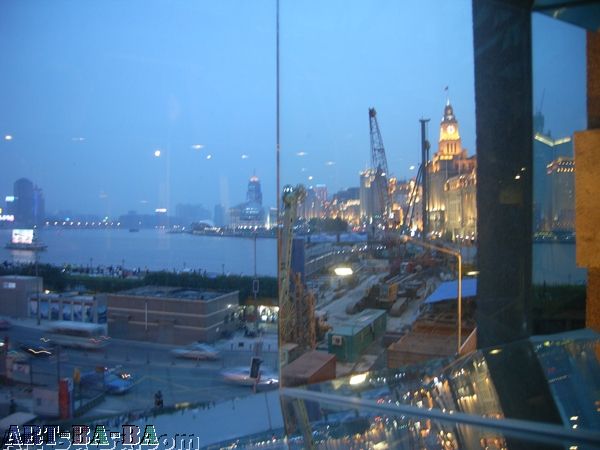
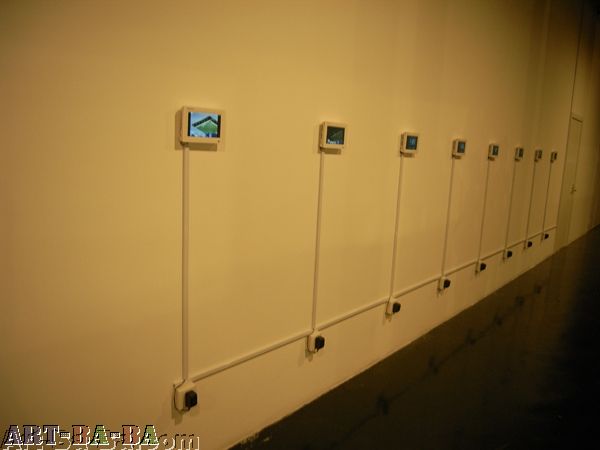
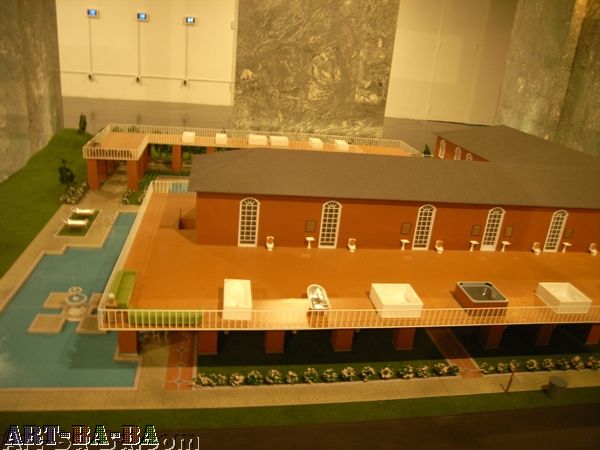
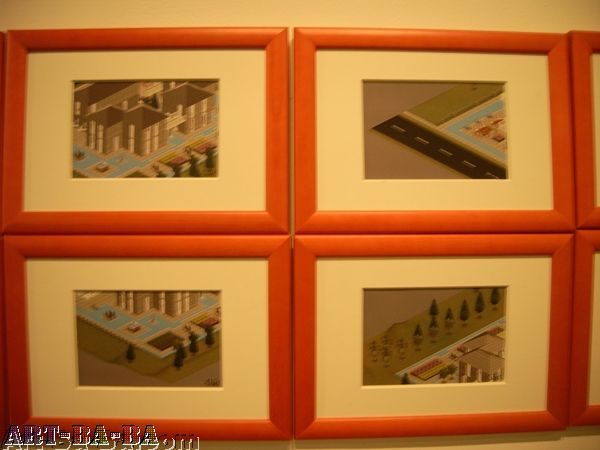
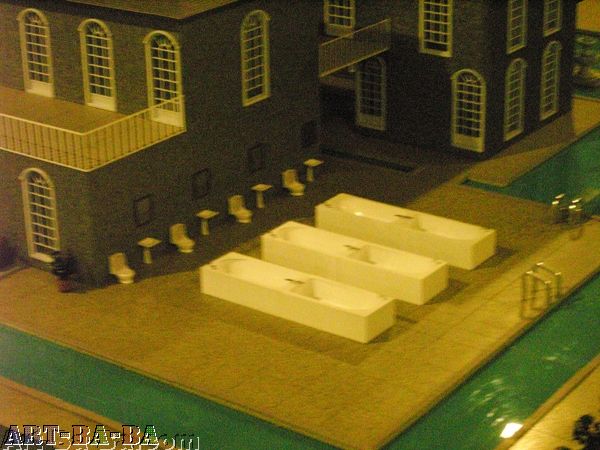

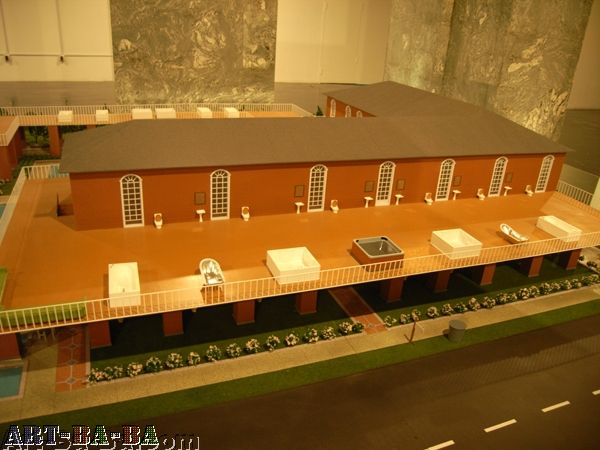
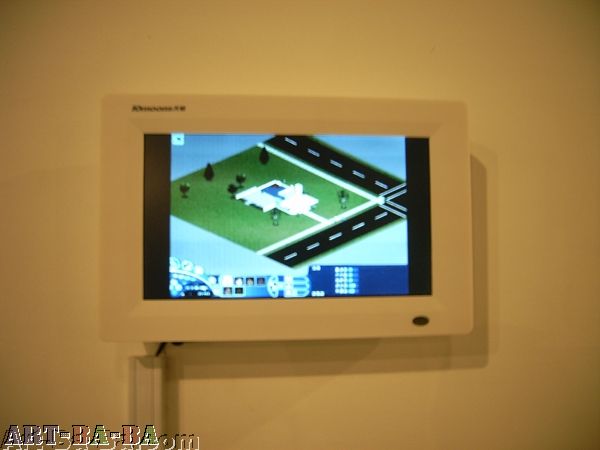

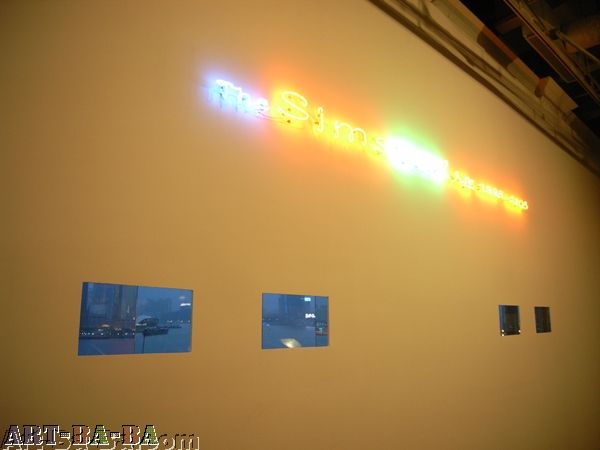
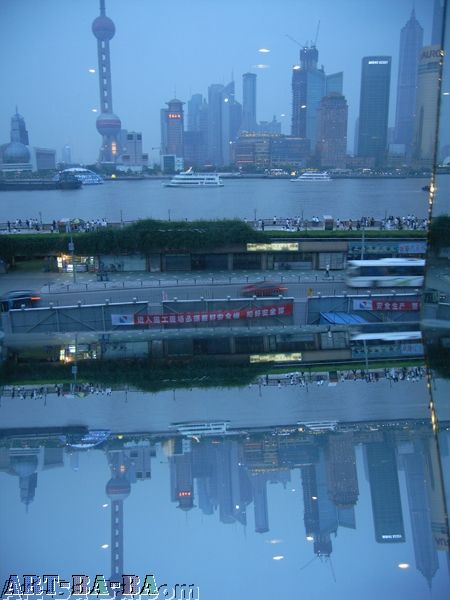

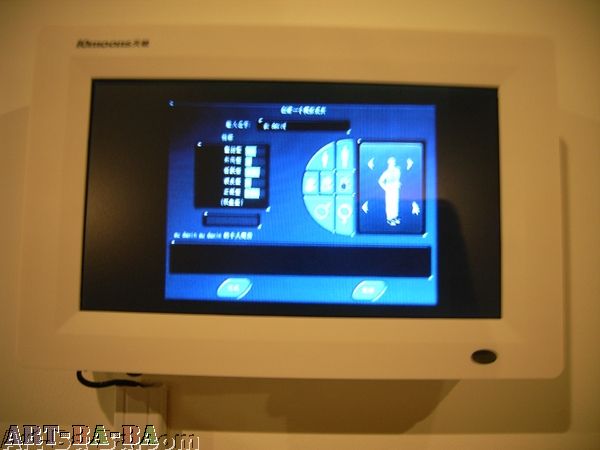
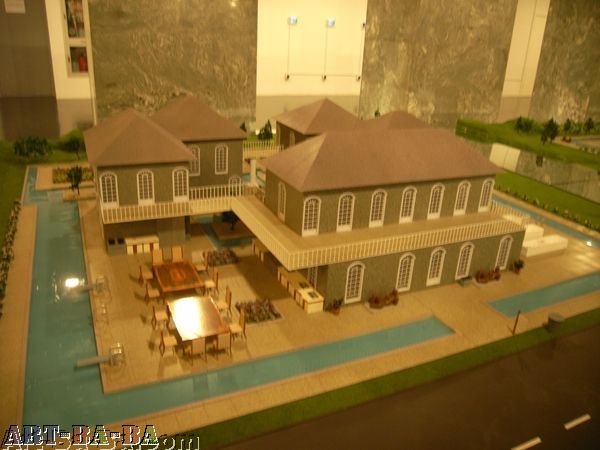
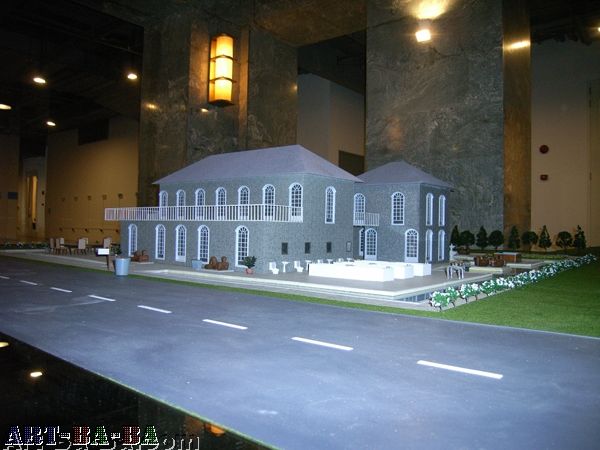
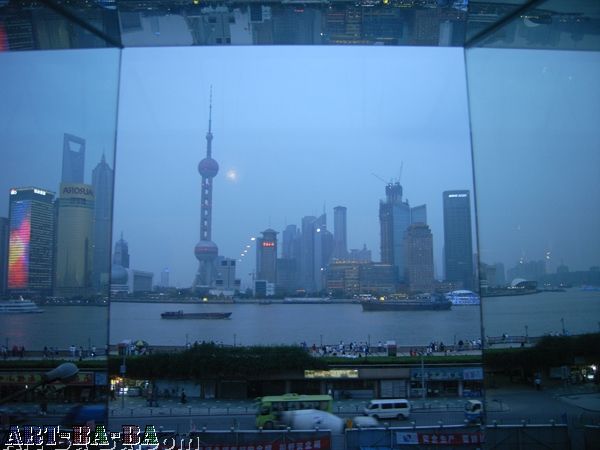
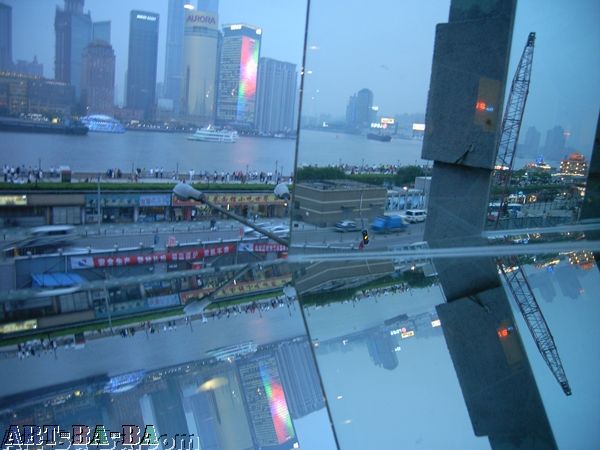
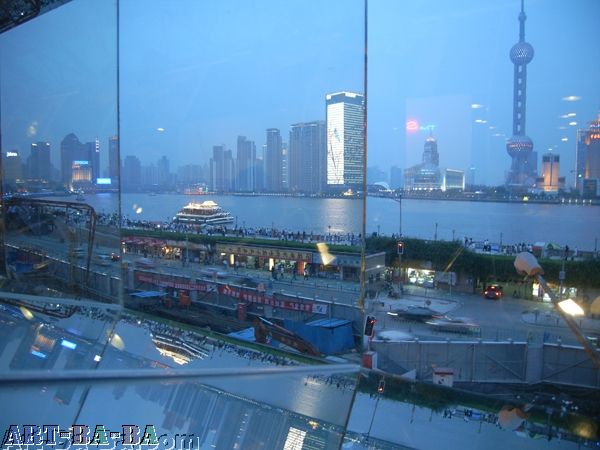

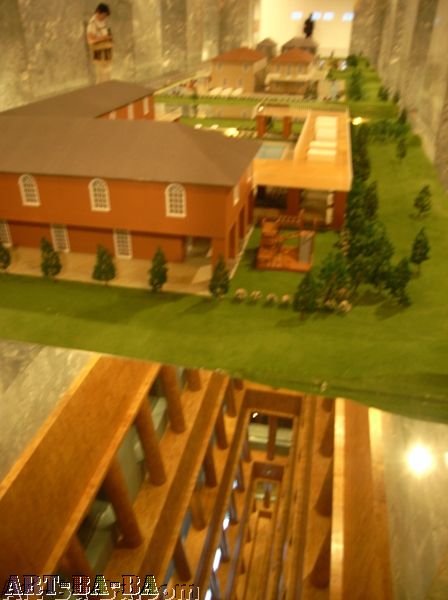
Shanghai Gallery of Art, Three on the Bund




















Gu Dexin «March 4, 2006»
Before giving material birth to each of his art creatures, self-taught Gu Dexin (*1962, Beijing) gets into a frenzied, sleepless psychological labour from which he is released only with the beginning the manual work. Through the direct contact and manipulation of his materials -often of vegetable, animal or industrial origins- his conceptual embryos come to a complete formal maturation.
Cast in the cycle of their unfathomable existences, Gu Dexin's works are left free to celebrate their uncontainable and spontaneous child-like joie de vivre that, originally untouched by any external limitation, addresses both the physical and the philosophical aspect of life. Gu Dexin's installations, sculptures, videos, cartoons, photographs, paintings and embroideries are orchestrated according to an inner musicality that is neither perceivable nor decipherable through the established cognitive methods. It is from the full awareness of the restricting expressive nature of written and spoken language that Gu Dexin's sardonic silences and the speechless character of his works derive.
Almost always created for the occasion of a show and specifically inspired by the imaginary interaction between the exhibition hall and his mental space, Gu's works are consequently and systematically named after the opening date of the art event. This is in order not to set, by means of words, any conditions that will effect the viewer's interpretation of the content. In addition to the fact that he sometimes uses perishable materials, moreover, Gu's installations are often subject to a process of transformation though which their original appearance and meaning naturally changes into something different and unpredictable.
Consisting of fifty modified automatic toy cars each bearing a life-size sex toy on the top (25 rubber penises and 25 rubber vaginas), Gu Dexin's installation March 4, 2006 penetrates the exhibition hall of Galerie Urs Meile transforming the space from empty box with its own pre-existing architectural features into a colourful, chaotic display of bumper cars that run headlong abounding in crashes and restarts. The surreal mechanical orgy ends only when the batteries go flat and, after having stopped, the artworks are left in their random order turning, as the artist says, "into nothing but a shape."
If Gu Dexin affirms to being fascinated by sex, love making and all the other corporeal activities, it is because all those things have a deep influence on people's lives, an influence that is determined by natural instincts on the one hand, by the moral values imposed by the social environment on the other. Similarly, toys play a very important role in the life of an individual by continuously creeping into his psychological world and imperceptibly ruling his criteria of judgment and choices, both spiritually and materially:
"As a matter of facts, toys constitute a burden weighting heavily on adults' shoulders, a subtle pressure that adults give to children or to other adults. They are specimens, requests for standardized behaviors by a demanding society."
By assembling a toy car (a mass-produced object especially designed for children) and a sex toy (an instrument manufactured for the exclusive use of adults), dolls collector Gu Dexin ironically stresses those tensions generated by the friction of conflicting elements such as natural and man-made condition, playfulness and regulation, creativity and actual reality, desire and frustration. Gu Dexin reveals the games and the power of toys, and our acceptance and interiorization of their rules:
"What interests me most in this artwork", states Gu Dexin,, "is: whether people want to change their bodies into toys, or toys into bodies."
By Nataline Colonnello
All the quotations are drawn from excerpts of an interview with Gu Dexin held in Beijing, December 18, 2005
Before giving material birth to each of his art creatures, self-taught Gu Dexin (*1962, Beijing) gets into a frenzied, sleepless psychological labour from which he is released only with the beginning the manual work. Through the direct contact and manipulation of his materials -often of vegetable, animal or industrial origins- his conceptual embryos come to a complete formal maturation.
Cast in the cycle of their unfathomable existences, Gu Dexin's works are left free to celebrate their uncontainable and spontaneous child-like joie de vivre that, originally untouched by any external limitation, addresses both the physical and the philosophical aspect of life. Gu Dexin's installations, sculptures, videos, cartoons, photographs, paintings and embroideries are orchestrated according to an inner musicality that is neither perceivable nor decipherable through the established cognitive methods. It is from the full awareness of the restricting expressive nature of written and spoken language that Gu Dexin's sardonic silences and the speechless character of his works derive.
Almost always created for the occasion of a show and specifically inspired by the imaginary interaction between the exhibition hall and his mental space, Gu's works are consequently and systematically named after the opening date of the art event. This is in order not to set, by means of words, any conditions that will effect the viewer's interpretation of the content. In addition to the fact that he sometimes uses perishable materials, moreover, Gu's installations are often subject to a process of transformation though which their original appearance and meaning naturally changes into something different and unpredictable.
Consisting of fifty modified automatic toy cars each bearing a life-size sex toy on the top (25 rubber penises and 25 rubber vaginas), Gu Dexin's installation March 4, 2006 penetrates the exhibition hall of Galerie Urs Meile transforming the space from empty box with its own pre-existing architectural features into a colourful, chaotic display of bumper cars that run headlong abounding in crashes and restarts. The surreal mechanical orgy ends only when the batteries go flat and, after having stopped, the artworks are left in their random order turning, as the artist says, "into nothing but a shape."
If Gu Dexin affirms to being fascinated by sex, love making and all the other corporeal activities, it is because all those things have a deep influence on people's lives, an influence that is determined by natural instincts on the one hand, by the moral values imposed by the social environment on the other. Similarly, toys play a very important role in the life of an individual by continuously creeping into his psychological world and imperceptibly ruling his criteria of judgment and choices, both spiritually and materially:
"As a matter of facts, toys constitute a burden weighting heavily on adults' shoulders, a subtle pressure that adults give to children or to other adults. They are specimens, requests for standardized behaviors by a demanding society."
By assembling a toy car (a mass-produced object especially designed for children) and a sex toy (an instrument manufactured for the exclusive use of adults), dolls collector Gu Dexin ironically stresses those tensions generated by the friction of conflicting elements such as natural and man-made condition, playfulness and regulation, creativity and actual reality, desire and frustration. Gu Dexin reveals the games and the power of toys, and our acceptance and interiorization of their rules:
"What interests me most in this artwork", states Gu Dexin,, "is: whether people want to change their bodies into toys, or toys into bodies."
By Nataline Colonnello
All the quotations are drawn from excerpts of an interview with Gu Dexin held in Beijing, December 18, 2005
GU DEXIN
2009-05-02
GALLERIACONTINUA / BEIJING MAY 2nd, 2009
“…to thine own self be true,
And it must follow, as the night the day,
Thou canst not then be false to any man.”
Shakespeare- Hamlet
Since 2005, Galleria Continua has hosted significant and demanding exhibitions. Artists are invited to express them selves through an intimate dialogue with the wholly exigent space, to engage its dimensions and its strong characteristics.
Gu Dexin’s starting point for his solo exhibition at Galleria Continua/Beijing was to leave the space as vacant and untouched as possible; to let the air fill in the gap between ‘reality’ and people’s perception of it; to avoid exercising ’POWER’ on any front.
The title of the exhibition, as for each of his projects, is represented simply by a date, signifying the opening and simultaneous closing of an event. For the artist, it indicates a conclusion, but for others, it is a beginning.
The exhibition contemplates messages of guilt and redemption. Over our heads, a tormented bundle of clouds flows unceasingly, preceding the human sense of time.
Gu Dexin’s interpretation of space is contemplative and measured; it, takes into account the gallery’s singular history, dimension, and location. He does not normally offer us a profound conceptual explanation of his work, but allows it to speak for itself. Often monumental in scale and site specific, his installation works communicate by appealing to the viewer at first sight and thence transporting us to the exceptional depth of the artist’s idea. Through this, and through Gu Dexin’s exceptional ability for visual expression, the distance between the viewer’s senses and thoughts is eliminated; the work reaches the heart and the mind on a deeply profound level.
Gu Dexin is an extremely peaceful person. His ideas about art, life, and his personal mode of living have always been intimately related, constantly sustaining one another with extreme coherence. Through art, Gu Dexin expresses and amuses himself and others. For Gu Dexin, art, as a medium, has never been a way to impose ideas, nor a way to exercise any sort of power. On the other hand, art has never held an indispensable meaning or position in his life; perfect equilibrium has always been sought and deeply pondered.
With a career as an ‘artist’, or, as he would probably prefer to say, as “a person who likes to play”, spanning more than thirty years, Gu Dexin has always maintained a firmly humble position. Initially he fought to express his ideals together with young colleagues through exhibitions, performances and installations that were becoming prevalent towards the end of the seventies. Later, he fought to keep a ‘low profile’ and to maintain a simple lifestyle whilst becoming more widely recognized. He has felt strongly about preventing the feverish art world from taking control of his thoughts and, most importantly, his life.
Unlike many others of his controversial contemporaries, Gu Dexin has always lived in China; he never left his hometown of Beijing, nor his small, comfortable apartment in the district of He Pingli. Always interested in following the subtle nuances of his native world, and unable to ignore the reality when it has been distressing, he has built a harmonious place to live quietly and work on his own. It has been a lifelong spiritual and intellectual engagement with his own thoughts, sometimes with fears, sometimes with loneliness.
Once the mind of Gu Dexin is ‘caught up’ in a project for inhabiting a new space, his work reaches impressive dimensions and characteristics. He brings the viewer to a world that seems surreal and fascinating, but which, in depth, represents a situation from reality – a weird dangerous and mistrustful world that hides unexpected cruelties such as the vacuous existence of the individual, the fragility of life itself. These moments of ‘truth’ seem so familiar to Gu Dexin, perhaps because of his elevated and deeply developed integrity.
Since the dawn of time, humankind has contemplated the dim recesses of the psyche, searching inwardly for an abundant world where life is harmonious and balanced. In our present world this daunting time of new beginnings, our longing continues, not for a new place nor one from the past, but for a world transformed, a world where respect for all is the conscious order of things.
It is this sort of mad lucidity, which encircles Gu Dexin’s way of being and ‘doing’. It enables spectators to realise that we are surrounded by a forceful ‘politics of power’, a muffled world in which equal opportunities, justice and freedom are imbued with threats…
Gu Dexin was born in Beijing in 1962. He currently lives and works in Beijing. Over the past thirty years, Gu Dexin has exhibited extensively in China and world-wide. He has participated internationally in many group shows including Les Magiciens de la Terre, Center Georges Pompidou, Paris, France (1989); China’s New Art Post (1989); Hong Kong Arts Centre, Hong Kong (1993); China Avant-garde, Haus der Kulturen, Berlin, Germany; Kunsthal, Rotterdam, Holland; Museum Of Modem Art, Oxford, U. K.; Kunsthallen Brandts Klaedefabrik, Odense, Denmark (1993); Dreams and conflicts, la Biennale di Venezia (2003); China Power Station: Part 1 Serpentine Gallery Presents London (2006); ‘85 new wave-the birth of Chinese contemporary art. UCCA Beijing (2007); The Real Thing, Contemporary art From China Tate Liverpool.
Text source: Galleria Continua website
2009-05-02
GALLERIACONTINUA / BEIJING MAY 2nd, 2009
“…to thine own self be true,
And it must follow, as the night the day,
Thou canst not then be false to any man.”
Shakespeare- Hamlet
Since 2005, Galleria Continua has hosted significant and demanding exhibitions. Artists are invited to express them selves through an intimate dialogue with the wholly exigent space, to engage its dimensions and its strong characteristics.
Gu Dexin’s starting point for his solo exhibition at Galleria Continua/Beijing was to leave the space as vacant and untouched as possible; to let the air fill in the gap between ‘reality’ and people’s perception of it; to avoid exercising ’POWER’ on any front.
The title of the exhibition, as for each of his projects, is represented simply by a date, signifying the opening and simultaneous closing of an event. For the artist, it indicates a conclusion, but for others, it is a beginning.
The exhibition contemplates messages of guilt and redemption. Over our heads, a tormented bundle of clouds flows unceasingly, preceding the human sense of time.
Gu Dexin’s interpretation of space is contemplative and measured; it, takes into account the gallery’s singular history, dimension, and location. He does not normally offer us a profound conceptual explanation of his work, but allows it to speak for itself. Often monumental in scale and site specific, his installation works communicate by appealing to the viewer at first sight and thence transporting us to the exceptional depth of the artist’s idea. Through this, and through Gu Dexin’s exceptional ability for visual expression, the distance between the viewer’s senses and thoughts is eliminated; the work reaches the heart and the mind on a deeply profound level.
Gu Dexin is an extremely peaceful person. His ideas about art, life, and his personal mode of living have always been intimately related, constantly sustaining one another with extreme coherence. Through art, Gu Dexin expresses and amuses himself and others. For Gu Dexin, art, as a medium, has never been a way to impose ideas, nor a way to exercise any sort of power. On the other hand, art has never held an indispensable meaning or position in his life; perfect equilibrium has always been sought and deeply pondered.
With a career as an ‘artist’, or, as he would probably prefer to say, as “a person who likes to play”, spanning more than thirty years, Gu Dexin has always maintained a firmly humble position. Initially he fought to express his ideals together with young colleagues through exhibitions, performances and installations that were becoming prevalent towards the end of the seventies. Later, he fought to keep a ‘low profile’ and to maintain a simple lifestyle whilst becoming more widely recognized. He has felt strongly about preventing the feverish art world from taking control of his thoughts and, most importantly, his life.
Unlike many others of his controversial contemporaries, Gu Dexin has always lived in China; he never left his hometown of Beijing, nor his small, comfortable apartment in the district of He Pingli. Always interested in following the subtle nuances of his native world, and unable to ignore the reality when it has been distressing, he has built a harmonious place to live quietly and work on his own. It has been a lifelong spiritual and intellectual engagement with his own thoughts, sometimes with fears, sometimes with loneliness.
Once the mind of Gu Dexin is ‘caught up’ in a project for inhabiting a new space, his work reaches impressive dimensions and characteristics. He brings the viewer to a world that seems surreal and fascinating, but which, in depth, represents a situation from reality – a weird dangerous and mistrustful world that hides unexpected cruelties such as the vacuous existence of the individual, the fragility of life itself. These moments of ‘truth’ seem so familiar to Gu Dexin, perhaps because of his elevated and deeply developed integrity.
Since the dawn of time, humankind has contemplated the dim recesses of the psyche, searching inwardly for an abundant world where life is harmonious and balanced. In our present world this daunting time of new beginnings, our longing continues, not for a new place nor one from the past, but for a world transformed, a world where respect for all is the conscious order of things.
It is this sort of mad lucidity, which encircles Gu Dexin’s way of being and ‘doing’. It enables spectators to realise that we are surrounded by a forceful ‘politics of power’, a muffled world in which equal opportunities, justice and freedom are imbued with threats…
Gu Dexin was born in Beijing in 1962. He currently lives and works in Beijing. Over the past thirty years, Gu Dexin has exhibited extensively in China and world-wide. He has participated internationally in many group shows including Les Magiciens de la Terre, Center Georges Pompidou, Paris, France (1989); China’s New Art Post (1989); Hong Kong Arts Centre, Hong Kong (1993); China Avant-garde, Haus der Kulturen, Berlin, Germany; Kunsthal, Rotterdam, Holland; Museum Of Modem Art, Oxford, U. K.; Kunsthallen Brandts Klaedefabrik, Odense, Denmark (1993); Dreams and conflicts, la Biennale di Venezia (2003); China Power Station: Part 1 Serpentine Gallery Presents London (2006); ‘85 new wave-the birth of Chinese contemporary art. UCCA Beijing (2007); The Real Thing, Contemporary art From China Tate Liverpool.
Text source: Galleria Continua website
Gu Dexin: An UNEMPLOYED Artist
By Yi Peng
pparently one should denounce the logic of icons, images or texts in order to evaluate and comprehend Gu Dexin’s artworks. Gu’s life-long pursuit of art dates back to the late 1970s, a period that saw China flooded by a variety of western culture and art movements – from Renaissance to Impressionism, Greco to Picasso, messed up in a merry-go-round that influenced this young self-trained ‘painter’ well-known within He Ping Li, the name of the compound where he grew up. He refused to allow his paintings to conform to any “ism”, but rather scribbled beautifully and self-indulgently. However, when those who took his painting skills seriously introduced him to some instructors – a neighbor who took up painting as profession, a “rightist” teacher working at the Fine Art Academy, even a vice-president of an art academy who briefly participated in the Yan’an period, he couldn’t bear to go to a second class -- he saw no point in painting like that.
In the earlier days, Gu did not even gain an admission card to sit for the entrance examination for the Central Academy of Fine Art. Though we have no idea what kind of works he submitted, the fact that the application of “Art History” instructed by art academies of that time ended at Impressionism reasoned the failure of Gu and his scribbles. Over the next several years, that he had once wished to pass in campus but now feels no regret, he created an array of “mini-paints” – a group of aliens sprouting several pairs of breasts, which were later interpreted as “Beyond Sex” by the art critic Hou Hanru.
He was previously connected with various non-official groups of painters, such as the ‘Stars Group’ and ‘No Name’, both of which were fervently involved in the Beijing art scene of the 1980s. He felt particularly encouraged when he arrived at the works of Wang Keping at the once-famous “Xing Xing Exhibition”. Wang’s work that featured pure artistic means, brief but powerful in expression, with a distinctive viewpoint and attitude, ignited his earnest beliefs and ideals about art. Years later in a discussion with Robert Rauschenberg during his 1985 journey to China, the same feeling even saved him out of a life full of alcohol and idleness, and later become an artist who is full of dignity and wisdom, able to command the world’s most powerful artistic language.
Since the mid-80’s, maybe even earlier, Gu has become unsatisfied with art creations on canvas, but was eager to find a powerful language that could be sensed directly and reach to our mind without any futile conversions. He struck out to the experiment of installation and soon qualified himself one of the pioneers in the field in China. Comparing with the “installations” generated in the “85 New Trend Movement” that still confined by the imagery factors hailed from paintings and sculptures, his works presented his amazing intuition of handling with “materials”. To look at Gu’s installations requires the non-faint-hearted; his instinctively capricious juxtaposition of daily objects like plastic, raw meat and fruit are so sensible that could suddenly lead to a startling and deadening effect to one’s mindset. As all the using materials are so common to daily life, Gu is able to get familiar with their qualities: how long does the raw meat take to deteriorate? How to reshape a piece of plastic? What will the materials smell like after deterioration or reshaping? In order to grips qualities of plastic – a kind of colorful, easy-to-remodel “new material” of the day, he even went to work in a plastic factory for several years. He tends to present the materials themselves in his works so as to let their silent but naturally sensible confession, or rather, the “existence”, make senses to the spectators,
Since the end of the 80’s, he has been actively involved in various international exhibitions. Within these various exhibitions we are confronted with his unparalleled ability for spatial arrangement and control. His startling 2007 site-specific work, executed within neo-classical style architecture, a brief walk from the Bund in Shanghai, manifested his full capability. At first sight there was nothing to see as you walked into the space; but within a few steps as you followed the sidewalk tiles running away at a 25-degree angle, you felt seduced to march forward without realizing that you were about to effortlessly walk out of the window and fall into thin air. The sudden halt led the eyes down to the floor; several manholes with something dimly visible as blood red drew your attention inward, where floating maggots merged in a viscous silica gel. On the other side, a lake of blue colored silicon rested on the tall and broad atrium with sparkling reflections from the wings of the houseflies scattered on top.
Perhaps Gu Dexin was trying to bring us into a real situation: surrounding is in a world extremely strange, dangerous, and suspicious; then came a truth which was unexpectedly cruel: the vacuous and ridiculous existence of individuals and the fragility of life threw you into the deep, solitary abyss. Still, the moment you looked back, the scene had turned on its head into a vision of splendid grandeur, so peaceful and beautiful. It reminded me of a certain feeling expressed by an artist of the same age, “You seemed to have entered a slow motion movie”. The abrupt slowing-down of reality crawls unbelievably into surrealism, which seems to have nothing to do with you, though it truly exists with you are involved. When you crawl out of this slow motion world, you are no longer the ‘you’ that entered. I would rather believe, what Gu frozen for us, is a serious moment (“Ernste Stunde”, by Rainer Maria Rilke). It is certainly not a specified and tangible moment, but a moment that leaks out the secret of life.
These moments of rareness seem to be close at hand for Gu, which, I believe, are the result of his very long spiritual and intellectual engagement with dark loneliness and grieving. Later, based on his gifted ability for visual expression, he chose to use the most direct and simple language possible to manifest his thoughts. He collapses the distance between the senses and the inner mind, reaching the so-called effect “Chu Mu Jing Xin”, which literally means ‘to strike the eyes and immediately rouse the mind’. Take the ‘kneading meat’ for example: he has kneaded a piece of raw meat for months or years until it has rotted and dried and framed in gold and with decorated flower patterns. Or the flagpole made of stainless steel, which was extended by 25 meters, lying across the center of the exhibition hall with kids rolling and horsing about on it. He has also made a few animations with simple-lined little cartoon figures, which amused five-year-old children, but grieved those who have suffered through history. There is a kind of rational craziness about Gu’s character that enables us spectators to realize that there are politics of power everywhere within our daily lives- a peaceful world on the verge of war with equality and liberty trampled by horrors. And all this time, you have probably perceived nothing.
As we’ve mentioned, Gu Dexin grew up in the compound of He Ping Li in Beijing, born there in 1962. In the past two decades, he has been invited for several times to immigrate overseas. Regardless, he intends to never leave his place of birth, for he needs to constantly know more about “here” and to stay is the only way to gain access. He used to be an alcoholic who once passed out in a roadside garden. But now he has abstained from alcohol for health reasons. He married his wife in 1988, living a normal life as every married couple, grocery shopping and cooking meals all by themselves. When it is widely expected that he would become the last master of our time, he, to the contrary, denies his identity as an artist by filling the blank space for ‘occupation’ on the VISA registration form with: UNEMPLOYED.
February, 2009
---------------------------------------------------------------------------------------------------------------------
Appendix: a talk with Gu Dexin
Xiao Gu (little Gu) – as we have called him over the decades. I think it is because there’re so many things “unchanged” about him. Xiao Gu is good to everyone. Extremely good! The smile on his face displays some kind of unwavering peace after survival. He never explains his works, seldom accepting interviews. We searched among his friends for memories of serious dialogue within informal discussions:
Q: Are you satisfied with your past artworks?
A: For me, to end means everything. I don’t care about satisfaction.
Q: Do you care about the exposing your works to the public?
A: No.
Q: What kind of artist do you dream to be?
A: I don’t care whether I’m an artist or not. I can be anything other than an artist.
Q: Then what you care about?
A: Maybe I care about knowing more.
Q: Such as truth or deceit?
A: Yes.
Q: What does contemporary art mean to you?
A: A sort of attitude.
Q: Why?
A: There’re so many differences between art of the past and today. In the past, artists and art were products of their system, political or religious… like Leonardo da Vinci. Art was not commonly accessible to the public at that time. Only those with privilege were able to do art. Nowadays, however, anyone can do art.
Q: Where is art heading?
A: I think artists may not exist in the future art scene, what will remain are artworks only.
Q: As an individual, are you an optimist or pessimist?
A: A pessimist maybe.
Q: Why?
A: Cause of something hard to change within human nature.
Q: For example…?
A: Like power.
Q: Do you believe in anything? What enables you to go on with life?
A: Love.
Editorial Note: Chinese contemporary artist Gu Dexin is widely esteemed for his great foresights with conceptual art during the last two decades. Gu Dexin solo exhibition "Gu Dexin: 2009.3.14" opens from March 14 to April 3, 2009 in Bejing Center for the arts at Legation Quarter. Gu Dexin continues to use meat, cement, marble, etc. to create his works. For more information, please go to: www.legationquarter.com
By Yi Peng
pparently one should denounce the logic of icons, images or texts in order to evaluate and comprehend Gu Dexin’s artworks. Gu’s life-long pursuit of art dates back to the late 1970s, a period that saw China flooded by a variety of western culture and art movements – from Renaissance to Impressionism, Greco to Picasso, messed up in a merry-go-round that influenced this young self-trained ‘painter’ well-known within He Ping Li, the name of the compound where he grew up. He refused to allow his paintings to conform to any “ism”, but rather scribbled beautifully and self-indulgently. However, when those who took his painting skills seriously introduced him to some instructors – a neighbor who took up painting as profession, a “rightist” teacher working at the Fine Art Academy, even a vice-president of an art academy who briefly participated in the Yan’an period, he couldn’t bear to go to a second class -- he saw no point in painting like that.
In the earlier days, Gu did not even gain an admission card to sit for the entrance examination for the Central Academy of Fine Art. Though we have no idea what kind of works he submitted, the fact that the application of “Art History” instructed by art academies of that time ended at Impressionism reasoned the failure of Gu and his scribbles. Over the next several years, that he had once wished to pass in campus but now feels no regret, he created an array of “mini-paints” – a group of aliens sprouting several pairs of breasts, which were later interpreted as “Beyond Sex” by the art critic Hou Hanru.
He was previously connected with various non-official groups of painters, such as the ‘Stars Group’ and ‘No Name’, both of which were fervently involved in the Beijing art scene of the 1980s. He felt particularly encouraged when he arrived at the works of Wang Keping at the once-famous “Xing Xing Exhibition”. Wang’s work that featured pure artistic means, brief but powerful in expression, with a distinctive viewpoint and attitude, ignited his earnest beliefs and ideals about art. Years later in a discussion with Robert Rauschenberg during his 1985 journey to China, the same feeling even saved him out of a life full of alcohol and idleness, and later become an artist who is full of dignity and wisdom, able to command the world’s most powerful artistic language.
Since the mid-80’s, maybe even earlier, Gu has become unsatisfied with art creations on canvas, but was eager to find a powerful language that could be sensed directly and reach to our mind without any futile conversions. He struck out to the experiment of installation and soon qualified himself one of the pioneers in the field in China. Comparing with the “installations” generated in the “85 New Trend Movement” that still confined by the imagery factors hailed from paintings and sculptures, his works presented his amazing intuition of handling with “materials”. To look at Gu’s installations requires the non-faint-hearted; his instinctively capricious juxtaposition of daily objects like plastic, raw meat and fruit are so sensible that could suddenly lead to a startling and deadening effect to one’s mindset. As all the using materials are so common to daily life, Gu is able to get familiar with their qualities: how long does the raw meat take to deteriorate? How to reshape a piece of plastic? What will the materials smell like after deterioration or reshaping? In order to grips qualities of plastic – a kind of colorful, easy-to-remodel “new material” of the day, he even went to work in a plastic factory for several years. He tends to present the materials themselves in his works so as to let their silent but naturally sensible confession, or rather, the “existence”, make senses to the spectators,
Since the end of the 80’s, he has been actively involved in various international exhibitions. Within these various exhibitions we are confronted with his unparalleled ability for spatial arrangement and control. His startling 2007 site-specific work, executed within neo-classical style architecture, a brief walk from the Bund in Shanghai, manifested his full capability. At first sight there was nothing to see as you walked into the space; but within a few steps as you followed the sidewalk tiles running away at a 25-degree angle, you felt seduced to march forward without realizing that you were about to effortlessly walk out of the window and fall into thin air. The sudden halt led the eyes down to the floor; several manholes with something dimly visible as blood red drew your attention inward, where floating maggots merged in a viscous silica gel. On the other side, a lake of blue colored silicon rested on the tall and broad atrium with sparkling reflections from the wings of the houseflies scattered on top.
Perhaps Gu Dexin was trying to bring us into a real situation: surrounding is in a world extremely strange, dangerous, and suspicious; then came a truth which was unexpectedly cruel: the vacuous and ridiculous existence of individuals and the fragility of life threw you into the deep, solitary abyss. Still, the moment you looked back, the scene had turned on its head into a vision of splendid grandeur, so peaceful and beautiful. It reminded me of a certain feeling expressed by an artist of the same age, “You seemed to have entered a slow motion movie”. The abrupt slowing-down of reality crawls unbelievably into surrealism, which seems to have nothing to do with you, though it truly exists with you are involved. When you crawl out of this slow motion world, you are no longer the ‘you’ that entered. I would rather believe, what Gu frozen for us, is a serious moment (“Ernste Stunde”, by Rainer Maria Rilke). It is certainly not a specified and tangible moment, but a moment that leaks out the secret of life.
These moments of rareness seem to be close at hand for Gu, which, I believe, are the result of his very long spiritual and intellectual engagement with dark loneliness and grieving. Later, based on his gifted ability for visual expression, he chose to use the most direct and simple language possible to manifest his thoughts. He collapses the distance between the senses and the inner mind, reaching the so-called effect “Chu Mu Jing Xin”, which literally means ‘to strike the eyes and immediately rouse the mind’. Take the ‘kneading meat’ for example: he has kneaded a piece of raw meat for months or years until it has rotted and dried and framed in gold and with decorated flower patterns. Or the flagpole made of stainless steel, which was extended by 25 meters, lying across the center of the exhibition hall with kids rolling and horsing about on it. He has also made a few animations with simple-lined little cartoon figures, which amused five-year-old children, but grieved those who have suffered through history. There is a kind of rational craziness about Gu’s character that enables us spectators to realize that there are politics of power everywhere within our daily lives- a peaceful world on the verge of war with equality and liberty trampled by horrors. And all this time, you have probably perceived nothing.
As we’ve mentioned, Gu Dexin grew up in the compound of He Ping Li in Beijing, born there in 1962. In the past two decades, he has been invited for several times to immigrate overseas. Regardless, he intends to never leave his place of birth, for he needs to constantly know more about “here” and to stay is the only way to gain access. He used to be an alcoholic who once passed out in a roadside garden. But now he has abstained from alcohol for health reasons. He married his wife in 1988, living a normal life as every married couple, grocery shopping and cooking meals all by themselves. When it is widely expected that he would become the last master of our time, he, to the contrary, denies his identity as an artist by filling the blank space for ‘occupation’ on the VISA registration form with: UNEMPLOYED.
February, 2009
---------------------------------------------------------------------------------------------------------------------
Appendix: a talk with Gu Dexin
Xiao Gu (little Gu) – as we have called him over the decades. I think it is because there’re so many things “unchanged” about him. Xiao Gu is good to everyone. Extremely good! The smile on his face displays some kind of unwavering peace after survival. He never explains his works, seldom accepting interviews. We searched among his friends for memories of serious dialogue within informal discussions:
Q: Are you satisfied with your past artworks?
A: For me, to end means everything. I don’t care about satisfaction.
Q: Do you care about the exposing your works to the public?
A: No.
Q: What kind of artist do you dream to be?
A: I don’t care whether I’m an artist or not. I can be anything other than an artist.
Q: Then what you care about?
A: Maybe I care about knowing more.
Q: Such as truth or deceit?
A: Yes.
Q: What does contemporary art mean to you?
A: A sort of attitude.
Q: Why?
A: There’re so many differences between art of the past and today. In the past, artists and art were products of their system, political or religious… like Leonardo da Vinci. Art was not commonly accessible to the public at that time. Only those with privilege were able to do art. Nowadays, however, anyone can do art.
Q: Where is art heading?
A: I think artists may not exist in the future art scene, what will remain are artworks only.
Q: As an individual, are you an optimist or pessimist?
A: A pessimist maybe.
Q: Why?
A: Cause of something hard to change within human nature.
Q: For example…?
A: Like power.
Q: Do you believe in anything? What enables you to go on with life?
A: Love.
Editorial Note: Chinese contemporary artist Gu Dexin is widely esteemed for his great foresights with conceptual art during the last two decades. Gu Dexin solo exhibition "Gu Dexin: 2009.3.14" opens from March 14 to April 3, 2009 in Bejing Center for the arts at Legation Quarter. Gu Dexin continues to use meat, cement, marble, etc. to create his works. For more information, please go to: www.legationquarter.com
Gu Dexin’s A GREAT PATHWAY TO HEAVEN/Shanghai Art Gallery, May 2007
By Joan Lebold Cohen
ot surprisingly, A GREAT PATHWAY TO HEAVEN does not reveal itself at first glance. What is Gu Dexin’s message in this puzzling installation that purports to depict an ordinary street with life-size paving stones? As the title implies, are we to tap dance our way in full costume and song on the magic way to paradise?
Gu’s reproduced street ascends the spacious Shanghai Art Gallery at a 25 degree angle to the windows that face the river, the Pudong skyline and the sky. Gu has achieved his uninterrupted heavenly vision by building his street up to the window-sill. The viewer wonders, is this all that there is to it?
Retracing one’s steps and viewing the street, which is studded with 27 cast iron, meticulously reproduced manhole covers, one can peer through their holes and see slimy red muck oozing below. Retreating to one side of the street, there is an authentic metal storm drain grate. Through that grate one can confirm the previously-- glimpsed red slime as well as maggots.
Turning from this disgusting vision to the other side of the gallery street, one can glimpse an appealingly Mediterranean blue pool. This long rectangular pool contains what looks like intense shining clusters in the distance. Is this the antidote to the polluted and disgusting street? Yet approaching the pool dissipates the mirage. On closer inspection, the beautiful blue pool has no water and is covered with huge clusters of giant black flies whose wings sparkle in the distance.
How can one interpret this powerful installation? Is it a Western Biblical reference to the corruption of Sodom and Gomorrah? Or does it refer to the historical reporting of corrupt Chinese officials at the end of a dynastic cycle when the Emperor has lost the mandate of heaven? Chinese media fill their pages and airwaves with stories of corrupt officials all over the world and especially locally, such as the former Communist Party Secretary of Shanghai. The stories in the daily press feature the new consumer class, the newly rich, and how they parade their wealth, spending in a most outrageous and ostentatious manner and behaving as if they were above the law. Is the artist commenting on the current national situation or is it a global comment indictment?
Is this what are we are doing to ourselves and our planet? Are we ripe for the apocalypse? Is the artist giving us a sign? Gu Dexin doesn’t answer his puzzling work in words, only clues. Gu has a history of presenting microcosms of our decaying world by assembling fruit and vegetables in a gallery for a month and allowing decay to overwhelm the space. He is also famous for kneading pieces of meat for a week at a time till they are completely broken down into something else. His current effort is a more powerful societal comment that we cannot ignore.
Joan Lebold Cohen, author of The New Chinese Painting, specialist in contemporary Chinese art. Her website is located at: www.joanleboldcohen.com
By Joan Lebold Cohen
ot surprisingly, A GREAT PATHWAY TO HEAVEN does not reveal itself at first glance. What is Gu Dexin’s message in this puzzling installation that purports to depict an ordinary street with life-size paving stones? As the title implies, are we to tap dance our way in full costume and song on the magic way to paradise?
Gu’s reproduced street ascends the spacious Shanghai Art Gallery at a 25 degree angle to the windows that face the river, the Pudong skyline and the sky. Gu has achieved his uninterrupted heavenly vision by building his street up to the window-sill. The viewer wonders, is this all that there is to it?
Retracing one’s steps and viewing the street, which is studded with 27 cast iron, meticulously reproduced manhole covers, one can peer through their holes and see slimy red muck oozing below. Retreating to one side of the street, there is an authentic metal storm drain grate. Through that grate one can confirm the previously-- glimpsed red slime as well as maggots.
Turning from this disgusting vision to the other side of the gallery street, one can glimpse an appealingly Mediterranean blue pool. This long rectangular pool contains what looks like intense shining clusters in the distance. Is this the antidote to the polluted and disgusting street? Yet approaching the pool dissipates the mirage. On closer inspection, the beautiful blue pool has no water and is covered with huge clusters of giant black flies whose wings sparkle in the distance.
How can one interpret this powerful installation? Is it a Western Biblical reference to the corruption of Sodom and Gomorrah? Or does it refer to the historical reporting of corrupt Chinese officials at the end of a dynastic cycle when the Emperor has lost the mandate of heaven? Chinese media fill their pages and airwaves with stories of corrupt officials all over the world and especially locally, such as the former Communist Party Secretary of Shanghai. The stories in the daily press feature the new consumer class, the newly rich, and how they parade their wealth, spending in a most outrageous and ostentatious manner and behaving as if they were above the law. Is the artist commenting on the current national situation or is it a global comment indictment?
Is this what are we are doing to ourselves and our planet? Are we ripe for the apocalypse? Is the artist giving us a sign? Gu Dexin doesn’t answer his puzzling work in words, only clues. Gu has a history of presenting microcosms of our decaying world by assembling fruit and vegetables in a gallery for a month and allowing decay to overwhelm the space. He is also famous for kneading pieces of meat for a week at a time till they are completely broken down into something else. His current effort is a more powerful societal comment that we cannot ignore.
Joan Lebold Cohen, author of The New Chinese Painting, specialist in contemporary Chinese art. Her website is located at: www.joanleboldcohen.com
Thank you for posting these articles!!
Below a link to: Gu Dexin's solo exhibition in Galleria Continua
Absurdity and paradox are the basic constituents of Gu Dexin's artistic games, where logic is shrewdly pushed beyond normally accepted limits. He says: "I am like a kid, I have no bounds". Best known for his inexplicable installations, in his videos entitled A1-A8, Gu Dexin (1962, Beijing) features eight very short examples of ordinary, sardonic cruelty. First shown at the 2003 edition of the Venice Biennial together with a second series of videos in colour called B1-B8, this set of cartoons is reminiscent of simple childish black and white drawings. A1-A8 (2001-2003) are dominated by an atmosphere of caustic and perceptive irony through which the artist adroitly broaches the thorny subject of the frustrating misuse of power, as it affects both the individual and the totality of mankind. Each section, being more like a dreamy vision than a story with a complete plot, presents a climactic action in which a savage force suddenly inflicts an injury or execution that irreversibly damages the impotent victims. It is exactly by means of this decontextualization that the unwarranted violence against generally accepted values raises a laugh. Human beings, blindly deprived of their rights to think, to procreate and even to live, thus become puppets voicing their own nonentity, foolish tools of machines controlled by obscure and wicked masterminds. The fragmentary nature of these videos as well as the speechlessness of their characters, stress the communicative potential of this work precisely because of a lack of completeness: "To me, in an artwork", the artist affirms, "there is neither a beginning nor a conclusion. In other words, there is not that kind of grammar that is peculiar to written language. The visual language of art does not need to be studied; it is not as precise as a written or spoken word, yet its ?non-correctness' generates a kind of openness that is much greater".
by Nataline Colonnello
From: Play Therapy, Introduction to Chinese artists and works selected for 2003's edition of the Bangkok Short Video Festival.
by Nataline Colonnello
From: Play Therapy, Introduction to Chinese artists and works selected for 2003's edition of the Bangkok Short Video Festival.
Gu Dexin at Gallerina Continue - Until Sep 6
Rotting meat is this artist's signature dish
Until September 6 Galleria Continua
Less sophisticated than country kids at a county fair, the contemporary art world is always fascinated by a one-trick pony.
Veteran Beijing artist Gu Dexin is not a exactly a one-trickster, but he has resorted to the same trick with enough frequency to be mistaken as one.
He first turned European noses at a satellite show of the Venice Biennale in 1995, when he dumped three hundred kilos of raw beef into three glass coffins set in a local casino.
In the heat of summer, poisonous gases from the rotting meat quickly forced officials to clean up the show. This shy enfant terrible of the art world went on to astound European audiences in a succession of shows, placing raw meat or fruit in public places and letting them rot.
Up until this year, when he installed raw pork at the Legation Quarter, the formula has served him brilliantly. Part of the force of this current show is the absence of decay – resulting in a sterile and odourless silence.
A large square in the main space reads, in Chinese, ‘We can go to heaven’.
But around the walls, Chinese characters surround us, repeating the words: ‘We Killed Men, We Killed Women, We Killed the Old, We Killed the Kids, We Ate Humans…’
Above this cheerful mantra, placed in the high windows of the space, time-lapse videos depict white clouds forming in a blue sky. It’s as if we have actually arrived in paradise.
Gu has not stated the source of his inspiration. But we infer that whenever we get to heaven – if we do – memories of our collective sins will poison our permanent bliss.
Abandoning his antics of rot and stench, Gu has presented us with the most serene and disturbing show of the year. Stacey Duff
Rotting meat is this artist's signature dish
Until September 6 Galleria Continua
Less sophisticated than country kids at a county fair, the contemporary art world is always fascinated by a one-trick pony.
Veteran Beijing artist Gu Dexin is not a exactly a one-trickster, but he has resorted to the same trick with enough frequency to be mistaken as one.
He first turned European noses at a satellite show of the Venice Biennale in 1995, when he dumped three hundred kilos of raw beef into three glass coffins set in a local casino.
In the heat of summer, poisonous gases from the rotting meat quickly forced officials to clean up the show. This shy enfant terrible of the art world went on to astound European audiences in a succession of shows, placing raw meat or fruit in public places and letting them rot.
Up until this year, when he installed raw pork at the Legation Quarter, the formula has served him brilliantly. Part of the force of this current show is the absence of decay – resulting in a sterile and odourless silence.
A large square in the main space reads, in Chinese, ‘We can go to heaven’.
But around the walls, Chinese characters surround us, repeating the words: ‘We Killed Men, We Killed Women, We Killed the Old, We Killed the Kids, We Ate Humans…’
Above this cheerful mantra, placed in the high windows of the space, time-lapse videos depict white clouds forming in a blue sky. It’s as if we have actually arrived in paradise.
Gu has not stated the source of his inspiration. But we infer that whenever we get to heaven – if we do – memories of our collective sins will poison our permanent bliss.
Abandoning his antics of rot and stench, Gu has presented us with the most serene and disturbing show of the year. Stacey Duff
How do I know China wrecked the Copenhagen deal?I was in the room
我是如何知道中国毁掉哥本哈根谈判的?我在现场
英国卫报 Mark Lynas
翻译:KTO
Copenhagen was a disaster. That much is agreed. But the truth about what actually happened is in danger of being lost amid the spin and inevitable mutual recriminations. The truth is this: China wrecked the talks, intentionally humiliated Barack Obama, and insisted on an awful "deal" so western leaders would walk away carrying the blame. How do I know this? Because I was in the room and saw it happen.
哥本哈根无疑是一个灾难。但是灾难背后的真相很可能因为国家间不可避免的相互指责而永远不为人所知。事实是:中国毁掉了谈判,故意羞辱了Obama,并且坚持其所提出的糟糕的提议从而使西方国家领导人承担来自舆论的指责。我是如何知道这些的呢?因为我当时在谈判房间里目睹了这一切。
China's strategy was simple: block the open negotiations for two weeks, and then ensure that the closed-door deal made it look as if the west had failed the world's poor once again. And sure enough, the aid agencies, civil society movements and environmental groups all took the bait. The failure was "the inevitable result of rich countries refusing adequately and fairly to shoulder their overwhelming responsibility", said Christian Aid. "Rich countries have bullied developing nations," fumed Friends of the Earth International.
中国的策略很简单:阻碍公开谈判两周,并且保证使关门协议看起来像是西方国家对穷国的背叛。可以十分肯定的是,救援机构,公民社会运动以及环境组织全都上了中国的当。Christian Aid说道:谈判的失败是“西方国家拒绝合理公平地承担责任的必然后果”。“富国威胁了发展中国家” – 愤怒的Friends of the Earth International这样说道。
All very predictable, but the complete opposite of the truth. Even George Monbiot, writing in yesterday's Guardian, made the mistake of singly blaming Obama. But I saw Obama fighting desperately to salvage a deal, and the Chinese delegate saying "no", over and over again. Monbiot even approvingly quoted the Sudanese delegate Lumumba Di-Aping, who denounced the Copenhagen accord as "a suicide pact, an incineration pact, in order to maintain the economic dominance of a few countries".
一切不出意料,但却完全与事实相悖。Even George Monbiot在昨天的卫报上错误指责奥巴马一个人。但是我看到的确是奥巴马在为挽救协议的签署全力以赴,而中国的代表确一而再再而三的将其否决。Monbiot甚至颇为赞赏的引用了苏丹代表Lumumba Di-Aping的话:哥本哈根协议是“一个自杀性,毁灭性的协议,其目的是为了保证少数国家的经济主导地位”
Sudan behaves at the talks as a puppet of China; one of a number of countries that relieves the Chinese delegation of having to fight its battles in open sessions. It was a perfect stitch-up. China gutted the deal behind the scenes, and then left its proxies to savage it in public.
Here's what actually went on late last Friday night, as heads of state from two dozen countries met behind closed doors. Obama was at the table for several hours, sitting between Gordon Brown and the Ethiopian prime minister, Meles Zenawi. The Danish prime minister chaired, and on his right sat Ban Ki-moon, secretary-general of the UN. Probably only about 50 or 60 people, including the heads of state, were in the room. I was attached to one of the delegations, whose head of state was also present for most of the time.
然而,苏丹在谈话中完全变为中国的傀儡,并且与其他几个国家一起,使中国代表团免于在公开会议与他国进行辩论。这是一个完美的计划--中国在幕后说出其谈判条件,然后这些国家公开为其辩护。下面是周五晚上在24个国家的领导人关门会议上真实经过:奥巴马出席会议数小时,他的旁边分别是英国首相布朗和埃塞俄比亚首相Meles Zenawi。会议由丹麦首相主持,坐在其右边的是联合国秘书长潘基文。在会议室内算上各国领导,总过只有50-60个人。我安排到一个国家的代表团名下。
What I saw was profoundly shocking. The Chinese premier, Wen Jinbao, did not deign to attend the meetings personally, instead sending a second-tier official in the country's foreign ministry to sit opposite Obama himself. The diplomatic snub was obvious and brutal, as was the practical implication: several times during the session, the world's most powerful heads of state were forced to wait around as the Chinese delegate went off to make telephone calls to his "superiors".
我在会议中所看到的非常令人震惊。中国总 理 温 家 宝, 本人并没有出席会议,而是派出了外交部的一个二级官员与奥巴马面向而座。这个行为的暗示很明显并且粗鲁。以至于在会议进行中这些世界上最强大的国家的首脑甚至要等待中国代表离席以便给打电话向“上级”请示。
Shifting the blame
转移指责
To those who would blame Obama and rich countries in general, know this: it was China's representative who insisted that industrialised country targets, previously agreed as an 80% cut by 2050, be taken out of the deal. "Why can't we even mention our own targets?" demanded a furious Angela Merkel. Australia's prime minister, Kevin Rudd, was annoyed enough to bang his microphone. Brazil's representative too pointed out the illogicality of China's position. Why should rich countries not announce even this unilateral cut? The Chinese delegate said no, and I watched, aghast, as Merkel threw up her hands in despair and conceded the point. Now we know why – because China bet, correctly, that Obama would get the blame for the Copenhagen accord's lack of ambition.
有一个事实是那些指责奥巴马和其他富国的人所需要了解的:是中国的代表坚持要把工业化国家在2050年之前减排80%的目标从最终的条款中删除的。针对此事,默克尔愤怒的说“为什么连我们都不能提出自己的目标?”澳大利亚总理陆克文甚至愤怒的拍起了麦克风。巴西代表也指出了中国立场中混乱的逻辑。为什么中国连发达国家单方面减排的提议都不接受呢?现在我知道了:因为中国正确预测到了奥巴马会为哥本哈根协议的谈判失败承担大部分的指责。
China, backed at times by India, then proceeded to take out all the numbers that mattered. A 2020 peaking year in global emissions, essential to restrain temperatures to 2C, was removed and replaced by woolly language suggesting that emissions should peak "as soon as possible". The long-term target, of global 50% cuts by 2050, was also excised. No one else, perhaps with the exceptions of India and Saudi Arabia, wanted this to happen. I am certain that had the Chinese not been in the room, we would have left Copenhagen with a deal that had environmentalists popping champagne corks popping in every corner of the world.
这之后,在印度的偶尔支持下,中国开始提出自己提案,在提案中2020年全球碳排放达到峰值(保证全球升温2摄氏度以内的关键一步)被替换成碳排放量应“尽快达到峰值”这样模糊的标准;2050年全球碳排放减半的长期目标被直接删除。也许除了印度和沙特阿拉伯,没有其他国家愿意看到这样的结果。我很确定当时如果没有中国人在会议室,我们会带着一个让环境主义者们欢呼雀跃的协议离开哥本哈根。
Strong position
强硬立场
So how did China manage to pull off this coup? First, it was in an extremely strong negotiating position. China didn't need a deal. As one developing country foreign minister said to me: "The Athenians had nothing to offer to the Spartans." On the other hand, western leaders in particular – but also presidents Lula of Brazil, Zuma of South Africa, Calderón of Mexico and many others – were desperate for a positive outcome. Obama needed a strong deal perhaps more than anyone. The US had confirmed the offer of $100bn to developing countries for adaptation, put serious cuts on the table for the first time (17% below 2005 levels by 2020), and was obviously prepared to up its offer.
那么,中国是怎么让其他国家就范的呢?首先,它采取了一个极端强硬的立场:中国不需要任何协议。正像一个发展中国家的外交部部长对我说的:“雅典人对斯巴达没有任何馈赠”。另一方面,特别是西方国家领导人(当然也包括巴西,南非,墨西哥等国的总统)对于一个积极的结果过于企盼。奥巴马是他们中最需要谈判成功的人- 美国已经许诺对发展中国家的100亿美元的援助,在谈判桌上做出了首次巨大的让步(2020年照2005年减排百分之17),并且显然已经为这些提议做好了准备。
Above all, Obama needed to be able to demonstrate to the Senate that he could deliver China in any global climate regulation framework, so conservative senators could not argue that US carbon cuts would further advantage Chinese industry. With midterm elections looming, Obama and his staff also knew that Copenhagen would be probably their only opportunity to go to climate change talks with a strong mandate. This further strengthened China's negotiating hand, as did the complete lack of civil society political pressure on either China or India. Campaign groups never blame developing countries for failure; this is an iron rule that is never broken. The Indians, in particular, have become past masters at co-opting the language of equity ("equal rights to the atmosphere") in the service of planetary suicide – and leftish campaigners and commentators are hoist with their own petard.
更重要的是,奥巴马迫切需要向参议院证明他能够将中国圈在任何一个气候框架之内以便使保守的参议员们相信美国的减排不会促进中国的工业增长。奥巴马和他的助手们意识到了中期选举的不乐观,他们也知道哥本哈根是使他们自己能够打出强有力的气候牌的唯一一次机会。中国在这一点上再一次占到了优势,因为中国的领导人完全不会受到来自国内的政治压力。舆论群体永远不会指责发展中国家的失败 – 这是一条铁打不动的定律。而中国已经超过印度,成为了最会利用这种公平言论(对于大气层的平等权利)毁灭地球的能手,这使左翼社会活动家和评论员搬起石头砸到了自己的脚。
With the deal gutted, the heads of state session concluded with a final battle as the Chinese delegate insisted on removing the 1.5C target so beloved of the small island states and low-lying nations who have most to lose from rising seas. President Nasheed of the Maldives, supported by Brown, fought valiantly to save this crucial number. "How can you ask my country to go extinct?" demanded Nasheed. The Chinese delegate feigned great offence – and the number stayed, but surrounded by language which makes it all but meaningless. The deed was done.
作为谈判的最后一击,中国代表坚持取消可能在海平面上升中丧失其国土的岛国以及低地国家强烈要求的1.5摄氏度目标。马尔代夫总统Nasheed在布朗的支持下,为这个目标与中国代表展开了强烈的争执,他质问道:“你们怎么能够要求一个国家走向灭亡呢?” 中国代表假装受到了很大的冒犯。这个数字被保住了,但是条款文本中的文字游戏确使它失去了实质性的意义。谈判就此结束。
China's game
中国的游戏
All this raises the question: what is China's game? Why did China, in the words of a UK-based analyst who also spent hours in heads of state meetings, "not only reject targets for itself, but also refuse to allow any other country to take on binding targets?" The analyst, who has attended climate conferences for more than 15 years, concludes that China wants to weaken the climate regulation regime now "in order to avoid the risk that it might be called on to be more ambitious in a few years' time".
所有这些都引出一个疑问:中国想要什么?一个当时在场的英国的分析师问道:为什么中国“不仅否决自己的目标,同时还拒绝其他国家达成任何目标?” 这个有着超过15年气候会议与会经验的分析师的结论是中国弱化气候公约以便“保证其不会在最近几年之内承担被要求减缓发展速度的风险”。
This does not mean China is not serious about global warming. It is strong in both the wind and solar industries. But China's growth, and growing global political and economic dominance, is based largely on cheap coal. China knows it is becoming an uncontested superpower; indeed its newfound muscular confidence was on striking display in Copenhagen. Its coal-based economy doubles every decade, and its power increases commensurately. Its leadership will not alter this magic formula unless they absolutely have to.
这并不代表中国对于全球变暖问题不严肃。中国具有着强大的风力和太阳能发电工业。但是中国的增长,与日俱增的政治和经济地位大部分是建立在廉价的煤炭上的。中国了解自己正在成为一个不可比拟的超级力量;这与上哥本哈根会议上的强硬表现相映成趣。中国基于煤炭的经济每隔10年就会翻一番,它的实力正在以令人惊愕的速度增长。除非在万不得已的情况下,中国的领导人不会放弃这样一个神奇的发展模式。
Copenhagen was much worse than just another bad deal, because it illustrated a profound shift in global geopolitics. This is fast becoming China's century, yet its leadership has displayed that multilateral environmental governance is not only not a priority, but is viewed as a hindrance to the new superpower's freedom of action. I left Copenhagen more despondent than I have felt in a long time. After all the hope and all the hype, the mobilisation of thousands, a wave of optimism crashed against the rock of global power politics, fell back, and drained away.
哥本哈根的影响要远远超过一个糟糕的协议,因为它还展现了全球地缘政治上的巨大变迁。这个世纪属于快速发展的中国,但是中国的领导人却不仅没有将多边环境治理提升到议事日程上,反而将其视为其自由发展的障碍。我以无比沮丧的心情离开哥本哈根。人们的希望,声势浩大的宣传,千百万人的动员和乐观主义情绪全部被强权政治的重拳击得粉碎,烟消云散了。
我是如何知道中国毁掉哥本哈根谈判的?我在现场
英国卫报 Mark Lynas
翻译:KTO
Copenhagen was a disaster. That much is agreed. But the truth about what actually happened is in danger of being lost amid the spin and inevitable mutual recriminations. The truth is this: China wrecked the talks, intentionally humiliated Barack Obama, and insisted on an awful "deal" so western leaders would walk away carrying the blame. How do I know this? Because I was in the room and saw it happen.
哥本哈根无疑是一个灾难。但是灾难背后的真相很可能因为国家间不可避免的相互指责而永远不为人所知。事实是:中国毁掉了谈判,故意羞辱了Obama,并且坚持其所提出的糟糕的提议从而使西方国家领导人承担来自舆论的指责。我是如何知道这些的呢?因为我当时在谈判房间里目睹了这一切。
China's strategy was simple: block the open negotiations for two weeks, and then ensure that the closed-door deal made it look as if the west had failed the world's poor once again. And sure enough, the aid agencies, civil society movements and environmental groups all took the bait. The failure was "the inevitable result of rich countries refusing adequately and fairly to shoulder their overwhelming responsibility", said Christian Aid. "Rich countries have bullied developing nations," fumed Friends of the Earth International.
中国的策略很简单:阻碍公开谈判两周,并且保证使关门协议看起来像是西方国家对穷国的背叛。可以十分肯定的是,救援机构,公民社会运动以及环境组织全都上了中国的当。Christian Aid说道:谈判的失败是“西方国家拒绝合理公平地承担责任的必然后果”。“富国威胁了发展中国家” – 愤怒的Friends of the Earth International这样说道。
All very predictable, but the complete opposite of the truth. Even George Monbiot, writing in yesterday's Guardian, made the mistake of singly blaming Obama. But I saw Obama fighting desperately to salvage a deal, and the Chinese delegate saying "no", over and over again. Monbiot even approvingly quoted the Sudanese delegate Lumumba Di-Aping, who denounced the Copenhagen accord as "a suicide pact, an incineration pact, in order to maintain the economic dominance of a few countries".
一切不出意料,但却完全与事实相悖。Even George Monbiot在昨天的卫报上错误指责奥巴马一个人。但是我看到的确是奥巴马在为挽救协议的签署全力以赴,而中国的代表确一而再再而三的将其否决。Monbiot甚至颇为赞赏的引用了苏丹代表Lumumba Di-Aping的话:哥本哈根协议是“一个自杀性,毁灭性的协议,其目的是为了保证少数国家的经济主导地位”
Sudan behaves at the talks as a puppet of China; one of a number of countries that relieves the Chinese delegation of having to fight its battles in open sessions. It was a perfect stitch-up. China gutted the deal behind the scenes, and then left its proxies to savage it in public.
Here's what actually went on late last Friday night, as heads of state from two dozen countries met behind closed doors. Obama was at the table for several hours, sitting between Gordon Brown and the Ethiopian prime minister, Meles Zenawi. The Danish prime minister chaired, and on his right sat Ban Ki-moon, secretary-general of the UN. Probably only about 50 or 60 people, including the heads of state, were in the room. I was attached to one of the delegations, whose head of state was also present for most of the time.
然而,苏丹在谈话中完全变为中国的傀儡,并且与其他几个国家一起,使中国代表团免于在公开会议与他国进行辩论。这是一个完美的计划--中国在幕后说出其谈判条件,然后这些国家公开为其辩护。下面是周五晚上在24个国家的领导人关门会议上真实经过:奥巴马出席会议数小时,他的旁边分别是英国首相布朗和埃塞俄比亚首相Meles Zenawi。会议由丹麦首相主持,坐在其右边的是联合国秘书长潘基文。在会议室内算上各国领导,总过只有50-60个人。我安排到一个国家的代表团名下。
What I saw was profoundly shocking. The Chinese premier, Wen Jinbao, did not deign to attend the meetings personally, instead sending a second-tier official in the country's foreign ministry to sit opposite Obama himself. The diplomatic snub was obvious and brutal, as was the practical implication: several times during the session, the world's most powerful heads of state were forced to wait around as the Chinese delegate went off to make telephone calls to his "superiors".
我在会议中所看到的非常令人震惊。中国总 理 温 家 宝, 本人并没有出席会议,而是派出了外交部的一个二级官员与奥巴马面向而座。这个行为的暗示很明显并且粗鲁。以至于在会议进行中这些世界上最强大的国家的首脑甚至要等待中国代表离席以便给打电话向“上级”请示。
Shifting the blame
转移指责
To those who would blame Obama and rich countries in general, know this: it was China's representative who insisted that industrialised country targets, previously agreed as an 80% cut by 2050, be taken out of the deal. "Why can't we even mention our own targets?" demanded a furious Angela Merkel. Australia's prime minister, Kevin Rudd, was annoyed enough to bang his microphone. Brazil's representative too pointed out the illogicality of China's position. Why should rich countries not announce even this unilateral cut? The Chinese delegate said no, and I watched, aghast, as Merkel threw up her hands in despair and conceded the point. Now we know why – because China bet, correctly, that Obama would get the blame for the Copenhagen accord's lack of ambition.
有一个事实是那些指责奥巴马和其他富国的人所需要了解的:是中国的代表坚持要把工业化国家在2050年之前减排80%的目标从最终的条款中删除的。针对此事,默克尔愤怒的说“为什么连我们都不能提出自己的目标?”澳大利亚总理陆克文甚至愤怒的拍起了麦克风。巴西代表也指出了中国立场中混乱的逻辑。为什么中国连发达国家单方面减排的提议都不接受呢?现在我知道了:因为中国正确预测到了奥巴马会为哥本哈根协议的谈判失败承担大部分的指责。
China, backed at times by India, then proceeded to take out all the numbers that mattered. A 2020 peaking year in global emissions, essential to restrain temperatures to 2C, was removed and replaced by woolly language suggesting that emissions should peak "as soon as possible". The long-term target, of global 50% cuts by 2050, was also excised. No one else, perhaps with the exceptions of India and Saudi Arabia, wanted this to happen. I am certain that had the Chinese not been in the room, we would have left Copenhagen with a deal that had environmentalists popping champagne corks popping in every corner of the world.
这之后,在印度的偶尔支持下,中国开始提出自己提案,在提案中2020年全球碳排放达到峰值(保证全球升温2摄氏度以内的关键一步)被替换成碳排放量应“尽快达到峰值”这样模糊的标准;2050年全球碳排放减半的长期目标被直接删除。也许除了印度和沙特阿拉伯,没有其他国家愿意看到这样的结果。我很确定当时如果没有中国人在会议室,我们会带着一个让环境主义者们欢呼雀跃的协议离开哥本哈根。
Strong position
强硬立场
So how did China manage to pull off this coup? First, it was in an extremely strong negotiating position. China didn't need a deal. As one developing country foreign minister said to me: "The Athenians had nothing to offer to the Spartans." On the other hand, western leaders in particular – but also presidents Lula of Brazil, Zuma of South Africa, Calderón of Mexico and many others – were desperate for a positive outcome. Obama needed a strong deal perhaps more than anyone. The US had confirmed the offer of $100bn to developing countries for adaptation, put serious cuts on the table for the first time (17% below 2005 levels by 2020), and was obviously prepared to up its offer.
那么,中国是怎么让其他国家就范的呢?首先,它采取了一个极端强硬的立场:中国不需要任何协议。正像一个发展中国家的外交部部长对我说的:“雅典人对斯巴达没有任何馈赠”。另一方面,特别是西方国家领导人(当然也包括巴西,南非,墨西哥等国的总统)对于一个积极的结果过于企盼。奥巴马是他们中最需要谈判成功的人- 美国已经许诺对发展中国家的100亿美元的援助,在谈判桌上做出了首次巨大的让步(2020年照2005年减排百分之17),并且显然已经为这些提议做好了准备。
Above all, Obama needed to be able to demonstrate to the Senate that he could deliver China in any global climate regulation framework, so conservative senators could not argue that US carbon cuts would further advantage Chinese industry. With midterm elections looming, Obama and his staff also knew that Copenhagen would be probably their only opportunity to go to climate change talks with a strong mandate. This further strengthened China's negotiating hand, as did the complete lack of civil society political pressure on either China or India. Campaign groups never blame developing countries for failure; this is an iron rule that is never broken. The Indians, in particular, have become past masters at co-opting the language of equity ("equal rights to the atmosphere") in the service of planetary suicide – and leftish campaigners and commentators are hoist with their own petard.
更重要的是,奥巴马迫切需要向参议院证明他能够将中国圈在任何一个气候框架之内以便使保守的参议员们相信美国的减排不会促进中国的工业增长。奥巴马和他的助手们意识到了中期选举的不乐观,他们也知道哥本哈根是使他们自己能够打出强有力的气候牌的唯一一次机会。中国在这一点上再一次占到了优势,因为中国的领导人完全不会受到来自国内的政治压力。舆论群体永远不会指责发展中国家的失败 – 这是一条铁打不动的定律。而中国已经超过印度,成为了最会利用这种公平言论(对于大气层的平等权利)毁灭地球的能手,这使左翼社会活动家和评论员搬起石头砸到了自己的脚。
With the deal gutted, the heads of state session concluded with a final battle as the Chinese delegate insisted on removing the 1.5C target so beloved of the small island states and low-lying nations who have most to lose from rising seas. President Nasheed of the Maldives, supported by Brown, fought valiantly to save this crucial number. "How can you ask my country to go extinct?" demanded Nasheed. The Chinese delegate feigned great offence – and the number stayed, but surrounded by language which makes it all but meaningless. The deed was done.
作为谈判的最后一击,中国代表坚持取消可能在海平面上升中丧失其国土的岛国以及低地国家强烈要求的1.5摄氏度目标。马尔代夫总统Nasheed在布朗的支持下,为这个目标与中国代表展开了强烈的争执,他质问道:“你们怎么能够要求一个国家走向灭亡呢?” 中国代表假装受到了很大的冒犯。这个数字被保住了,但是条款文本中的文字游戏确使它失去了实质性的意义。谈判就此结束。
China's game
中国的游戏
All this raises the question: what is China's game? Why did China, in the words of a UK-based analyst who also spent hours in heads of state meetings, "not only reject targets for itself, but also refuse to allow any other country to take on binding targets?" The analyst, who has attended climate conferences for more than 15 years, concludes that China wants to weaken the climate regulation regime now "in order to avoid the risk that it might be called on to be more ambitious in a few years' time".
所有这些都引出一个疑问:中国想要什么?一个当时在场的英国的分析师问道:为什么中国“不仅否决自己的目标,同时还拒绝其他国家达成任何目标?” 这个有着超过15年气候会议与会经验的分析师的结论是中国弱化气候公约以便“保证其不会在最近几年之内承担被要求减缓发展速度的风险”。
This does not mean China is not serious about global warming. It is strong in both the wind and solar industries. But China's growth, and growing global political and economic dominance, is based largely on cheap coal. China knows it is becoming an uncontested superpower; indeed its newfound muscular confidence was on striking display in Copenhagen. Its coal-based economy doubles every decade, and its power increases commensurately. Its leadership will not alter this magic formula unless they absolutely have to.
这并不代表中国对于全球变暖问题不严肃。中国具有着强大的风力和太阳能发电工业。但是中国的增长,与日俱增的政治和经济地位大部分是建立在廉价的煤炭上的。中国了解自己正在成为一个不可比拟的超级力量;这与上哥本哈根会议上的强硬表现相映成趣。中国基于煤炭的经济每隔10年就会翻一番,它的实力正在以令人惊愕的速度增长。除非在万不得已的情况下,中国的领导人不会放弃这样一个神奇的发展模式。
Copenhagen was much worse than just another bad deal, because it illustrated a profound shift in global geopolitics. This is fast becoming China's century, yet its leadership has displayed that multilateral environmental governance is not only not a priority, but is viewed as a hindrance to the new superpower's freedom of action. I left Copenhagen more despondent than I have felt in a long time. After all the hope and all the hype, the mobilisation of thousands, a wave of optimism crashed against the rock of global power politics, fell back, and drained away.
哥本哈根的影响要远远超过一个糟糕的协议,因为它还展现了全球地缘政治上的巨大变迁。这个世纪属于快速发展的中国,但是中国的领导人却不仅没有将多边环境治理提升到议事日程上,反而将其视为其自由发展的障碍。我以无比沮丧的心情离开哥本哈根。人们的希望,声势浩大的宣传,千百万人的动员和乐观主义情绪全部被强权政治的重拳击得粉碎,烟消云散了。
Google to end China censorship after e-mail breach
source: The Seattle Times website
Google Inc. will stop censoring its search results in China and may pull out of the country completely after discovering that computer hackers had tricked human-rights activists into exposing their e-mail accounts to outsiders.
By MICHAEL LIEDTKE
AP Technology Writer
SAN FRANCISCO —
Google Inc. will stop censoring its search results in China and may pull out of the country completely after discovering that computer hackers had tricked human-rights activists into exposing their e-mail accounts to outsiders.
The change of heart announced Tuesday heralds a major shift for the Internet's search leader, which has repeatedly said it will obey Chinese laws requiring some politically and socially sensitive issues to be blocked from search results available in other countries. The acquiescence had outraged free-speech advocates and even some shareholders, who argued Google's cooperation with China violated the company's "don't be evil" motto.
The criticism had started to sway Google co-founder Sergey Brin, who openly expressed his misgivings about the company's presence in China.
But the tipping point didn't come until Google recently uncovered hacking attacks launched from within China. The apparent goals: breaking into the computers of at least 20 major U.S. companies and gathering personal information about dozens of human rights activists trying to shine a light on China's alleged abuses.
Google spokesman Matt Furman declined to say whether the company suspects the Chinese government may have had a hand in the attacks.
Secretary of State Hillary Rodham Clinton said the Google allegations "raise very serious concerns and questions" and the U.S. is seeking an explanation from the Chinese government.
Google officials also plan to talk to the Chinese government to determine if there is a way the company can still provide unfiltered search results in the country. If an agreement can't be worked out, Google is prepared to leave China four years after creating a search engine bearing China's Web suffix, ".cn" to put itself in a better position to profit from the world's most populous country.
"The decision to review our business operations in China has been incredibly hard, and we know that it will have potentially far-reaching consequences," David Drummond, Google's top lawyer, wrote in a Tuesday blog posting.
A spokesman for the Chinese consulate in San Francisco had no immediate comment.
Abandoning China wouldn't put a big dent in Google's earnings, although it could crimp the company's growth as the country's Internet usage continues to rise. China's Internet audience already has soared from 10 million to nearly 340 million in the past decade.
Google, based in Mountain View, said its Chinese operations account for an "immaterial" amount of its roughly $22 billion in annual revenue. J.P. Morgan analyst Imran Khan had been expecting Google's China revenue to total about $600 million this year.
Although Google's search engine is the most popular worldwide, it's a distant second in China, where the homegrown Baidu.com processes more than 60 percent of all requests.
Free-speech and human rights groups are hoping Google's about-face will spur more companies to take a similar stand.
"Google has taken a bold and difficult step for Internet freedom in support of fundamental human rights," said Leslie Harris, president of the Center for Democracy & Technology, a civil-liberties group in Washington. "No company should be forced to operate under government threat to its core values or to the rights and safety of its users."
It's "an incredibly significant move," said Danny O'Brien, international outreach coordinator at the Electronic Frontier Foundation, an Internet rights group in San Francisco. "This changes the game because the question won't be 'How can we work in China?' but 'How can we create services that Chinese people can use, from outside of China?'"
Many Web sites based outside China, including Google's YouTube video site, are regularly blocked by the country's government.
Google's new stance on China was triggered by what it described as a sophisticated computer attack orchestrated from within the country. Rep. Anna Eshoo, D-Calif., praised Google for disclosing chicanery that "raises serious national security concerns."
Without providing details, Google said it and at least 20 other major companies from the Internet, financial services, technology, media and chemical industries were targeted. The heist lifted some of Google's intellectual property but didn't get any information about the users of its services, the company said. Google has passed along what it knows so far to U.S. authorities and other affected companies.
It does not appear that any U.S. government agencies or Web sites were affected by the attack, according to two U.S. administration officials. The officials spoke on condition of anonymity because they were not authorized to speak publicly about the issue.
The assault on Google appeared primarily aimed at breaking into the company's e-mail service, "Gmail," in an attempt to pry into the accounts of human right activists protesting the Chinese government's policies.
Only two e-mail accounts were infiltrated in these attacks, Google said, and the intruders were only able to see subject lines and the dates that the individual accounts were created. None of the content written within the body of the e-mails leaked out, Google said.
As part of its investigation into that incident, Google stumbled onto another scam that was more successful. Google said dozens of activists fighting the Chinese government's policies fell prey to ruses commonly known as "phishing" or malware. The victims live in the United States, Europe and China, Google said.
Phishing involves malicious e-mails urging the recipients to open an attachment or visit a link that they're conned into believing comes from a friend or legitimate company. Clicking on a phishing link of installs malware - malicious software - on to computers.
Once it's installed on a computer, malware can be used as a surveillance tool that can obtain passwords and unlock e-mail accounts.
Google's unfettered search results won't necessarily ensure more information will be made available to the average person in China because the government could still use its own filtering tools, said Clothilde Le Coz, Washington director for Reporters Without Borders, a media watchdog group.
"The Chinese government is one of the most efficient in terms of censoring the Web," she said. The blocking technology has proven so effective that it's become known as the "Great Firewall of China."
--
AP Technology Writers Barbara Ortutay in New York, Jessica Mintz in Seattle and Jordan Robertson in San Francisco and Associated Press Writer Lolita C. Baldor in Washington contributed to this report.
source: The Seattle Times website
Google Inc. will stop censoring its search results in China and may pull out of the country completely after discovering that computer hackers had tricked human-rights activists into exposing their e-mail accounts to outsiders.
By MICHAEL LIEDTKE
AP Technology Writer
SAN FRANCISCO —
Google Inc. will stop censoring its search results in China and may pull out of the country completely after discovering that computer hackers had tricked human-rights activists into exposing their e-mail accounts to outsiders.
The change of heart announced Tuesday heralds a major shift for the Internet's search leader, which has repeatedly said it will obey Chinese laws requiring some politically and socially sensitive issues to be blocked from search results available in other countries. The acquiescence had outraged free-speech advocates and even some shareholders, who argued Google's cooperation with China violated the company's "don't be evil" motto.
The criticism had started to sway Google co-founder Sergey Brin, who openly expressed his misgivings about the company's presence in China.
But the tipping point didn't come until Google recently uncovered hacking attacks launched from within China. The apparent goals: breaking into the computers of at least 20 major U.S. companies and gathering personal information about dozens of human rights activists trying to shine a light on China's alleged abuses.
Google spokesman Matt Furman declined to say whether the company suspects the Chinese government may have had a hand in the attacks.
Secretary of State Hillary Rodham Clinton said the Google allegations "raise very serious concerns and questions" and the U.S. is seeking an explanation from the Chinese government.
Google officials also plan to talk to the Chinese government to determine if there is a way the company can still provide unfiltered search results in the country. If an agreement can't be worked out, Google is prepared to leave China four years after creating a search engine bearing China's Web suffix, ".cn" to put itself in a better position to profit from the world's most populous country.
"The decision to review our business operations in China has been incredibly hard, and we know that it will have potentially far-reaching consequences," David Drummond, Google's top lawyer, wrote in a Tuesday blog posting.
A spokesman for the Chinese consulate in San Francisco had no immediate comment.
Abandoning China wouldn't put a big dent in Google's earnings, although it could crimp the company's growth as the country's Internet usage continues to rise. China's Internet audience already has soared from 10 million to nearly 340 million in the past decade.
Google, based in Mountain View, said its Chinese operations account for an "immaterial" amount of its roughly $22 billion in annual revenue. J.P. Morgan analyst Imran Khan had been expecting Google's China revenue to total about $600 million this year.
Although Google's search engine is the most popular worldwide, it's a distant second in China, where the homegrown Baidu.com processes more than 60 percent of all requests.
Free-speech and human rights groups are hoping Google's about-face will spur more companies to take a similar stand.
"Google has taken a bold and difficult step for Internet freedom in support of fundamental human rights," said Leslie Harris, president of the Center for Democracy & Technology, a civil-liberties group in Washington. "No company should be forced to operate under government threat to its core values or to the rights and safety of its users."
It's "an incredibly significant move," said Danny O'Brien, international outreach coordinator at the Electronic Frontier Foundation, an Internet rights group in San Francisco. "This changes the game because the question won't be 'How can we work in China?' but 'How can we create services that Chinese people can use, from outside of China?'"
Many Web sites based outside China, including Google's YouTube video site, are regularly blocked by the country's government.
Google's new stance on China was triggered by what it described as a sophisticated computer attack orchestrated from within the country. Rep. Anna Eshoo, D-Calif., praised Google for disclosing chicanery that "raises serious national security concerns."
Without providing details, Google said it and at least 20 other major companies from the Internet, financial services, technology, media and chemical industries were targeted. The heist lifted some of Google's intellectual property but didn't get any information about the users of its services, the company said. Google has passed along what it knows so far to U.S. authorities and other affected companies.
It does not appear that any U.S. government agencies or Web sites were affected by the attack, according to two U.S. administration officials. The officials spoke on condition of anonymity because they were not authorized to speak publicly about the issue.
The assault on Google appeared primarily aimed at breaking into the company's e-mail service, "Gmail," in an attempt to pry into the accounts of human right activists protesting the Chinese government's policies.
Only two e-mail accounts were infiltrated in these attacks, Google said, and the intruders were only able to see subject lines and the dates that the individual accounts were created. None of the content written within the body of the e-mails leaked out, Google said.
As part of its investigation into that incident, Google stumbled onto another scam that was more successful. Google said dozens of activists fighting the Chinese government's policies fell prey to ruses commonly known as "phishing" or malware. The victims live in the United States, Europe and China, Google said.
Phishing involves malicious e-mails urging the recipients to open an attachment or visit a link that they're conned into believing comes from a friend or legitimate company. Clicking on a phishing link of installs malware - malicious software - on to computers.
Once it's installed on a computer, malware can be used as a surveillance tool that can obtain passwords and unlock e-mail accounts.
Google's unfettered search results won't necessarily ensure more information will be made available to the average person in China because the government could still use its own filtering tools, said Clothilde Le Coz, Washington director for Reporters Without Borders, a media watchdog group.
"The Chinese government is one of the most efficient in terms of censoring the Web," she said. The blocking technology has proven so effective that it's become known as the "Great Firewall of China."
--
AP Technology Writers Barbara Ortutay in New York, Jessica Mintz in Seattle and Jordan Robertson in San Francisco and Associated Press Writer Lolita C. Baldor in Washington contributed to this report.
frieze2009年年度总结展望:中国(2010-03-10 22:53:15)标签:文化 分类:Essay
Looking Forward, Looking Back
Carol Yinghua Lu is a writer, curator and a contributing editor of frieze. She lives and works in Beijing, China
Best Group Show
‘Report to the Motherland – 60 Years of Chinese Fine Arts’ at The National Art Museum of China in Beijing provided a comprehensive survey of developments in art since the founding of the Republic of China in 1949. It was the first time a show had been organized around the country’s official 60-year-old art history; it included ink, watercolour and oil paintings, engraving, sculpture, folk arts, comics and propaganda posters that showcased ‘the process of nationalization, popularization and modernization of art’. Although many of the 700 works of art included in this informative show were not modern or contemporary, they lent a rare opportunity to gain greater understanding of the origins of contemporary Chinese art.
Best Solo Show
Gu Dexin’s exhibition 2009–05–02 in Galleria Continua, Beijing was the last public project of the artist’s career. Born in 1962, Gu is widely considered to be one of the most prolific and reflective conceptual artists in China and his consistent refusal to offer any explanation about his work has never diminished his popularity. Unsurprisingly, this unnerving exhibition was a highly metaphorical and austere contemplation on existential issues and refused to provide any comforting answers. For the artist, it marked his departure from the art world, which, typically, he refused to discuss.
A Show looking forward to in 2010
‘Reshaping History, Chinart from 2000 to 2009’ is scheduled to open simultaneously in major museums in Beijing, Guangzhou and Shanghai in April 2010 and has stirred controversy with the immodest claim of its title. According to art historian Lu Peng, who is the initiator of this ambitious project, its original title was ‘Making History’, which was abandoned as it was considered too close to ‘Making Worlds’ the title of the 53rd Venice Biennale. ‘Chinart’ was coined to refer to both Chinese art and the new group of museums Lu Peng helped initiate and which are still under construction – they’re part of a local tourist and economic promotion for Qingchengshan in Sichuan Province – the show’s main sponsor. The show, which will, no doubt reflect Lu Peng’s fast and loose approach to writing history, will include nearly 1000 works produced from 2000 to 2009 by almost 200 artists working over the past 30 years and will provide a useful, up-to-date and inclusive check-list of contemporary Chinese art since the end of Cultural Revolution in 1979 – as long as one bears in mind it’s just one angle and not the whole history.
Emerging Artist to Watch
Li Jinghu’s conceptual practice is rooted in his ability to excavate artistic potential from insignificant objects; he has carved a motorcycle helmet from a watermelon, shaped broken tiles into stars, planted flowers in a pair of boots, turned bamboo blooms into flutes by drilling holes on their handles, dismantled an alarm clock to create a string of wind-bells, and painted random cement fragments found on construction sites to look like Chinese cabbages. He views life with such optimism and lightness that his art is contagiously romantic and moving.
Looking Forward, Looking Back
Carol Yinghua Lu is a writer, curator and a contributing editor of frieze. She lives and works in Beijing, China
Best Group Show
‘Report to the Motherland – 60 Years of Chinese Fine Arts’ at The National Art Museum of China in Beijing provided a comprehensive survey of developments in art since the founding of the Republic of China in 1949. It was the first time a show had been organized around the country’s official 60-year-old art history; it included ink, watercolour and oil paintings, engraving, sculpture, folk arts, comics and propaganda posters that showcased ‘the process of nationalization, popularization and modernization of art’. Although many of the 700 works of art included in this informative show were not modern or contemporary, they lent a rare opportunity to gain greater understanding of the origins of contemporary Chinese art.
Best Solo Show
Gu Dexin’s exhibition 2009–05–02 in Galleria Continua, Beijing was the last public project of the artist’s career. Born in 1962, Gu is widely considered to be one of the most prolific and reflective conceptual artists in China and his consistent refusal to offer any explanation about his work has never diminished his popularity. Unsurprisingly, this unnerving exhibition was a highly metaphorical and austere contemplation on existential issues and refused to provide any comforting answers. For the artist, it marked his departure from the art world, which, typically, he refused to discuss.
A Show looking forward to in 2010
‘Reshaping History, Chinart from 2000 to 2009’ is scheduled to open simultaneously in major museums in Beijing, Guangzhou and Shanghai in April 2010 and has stirred controversy with the immodest claim of its title. According to art historian Lu Peng, who is the initiator of this ambitious project, its original title was ‘Making History’, which was abandoned as it was considered too close to ‘Making Worlds’ the title of the 53rd Venice Biennale. ‘Chinart’ was coined to refer to both Chinese art and the new group of museums Lu Peng helped initiate and which are still under construction – they’re part of a local tourist and economic promotion for Qingchengshan in Sichuan Province – the show’s main sponsor. The show, which will, no doubt reflect Lu Peng’s fast and loose approach to writing history, will include nearly 1000 works produced from 2000 to 2009 by almost 200 artists working over the past 30 years and will provide a useful, up-to-date and inclusive check-list of contemporary Chinese art since the end of Cultural Revolution in 1979 – as long as one bears in mind it’s just one angle and not the whole history.
Emerging Artist to Watch
Li Jinghu’s conceptual practice is rooted in his ability to excavate artistic potential from insignificant objects; he has carved a motorcycle helmet from a watermelon, shaped broken tiles into stars, planted flowers in a pair of boots, turned bamboo blooms into flutes by drilling holes on their handles, dismantled an alarm clock to create a string of wind-bells, and painted random cement fragments found on construction sites to look like Chinese cabbages. He views life with such optimism and lightness that his art is contagiously romantic and moving.
奥巴马悼念遇难矿工逐一念名字
以下是《东方日报》翻译的奥巴马悼词全文,英文附后。
“我们在这里,怀念29位美国人:卡尔‧阿克德、杰森‧阿金斯、克里斯多佛‧贝尔、格利高里‧史蒂夫‧布洛克、肯尼斯‧艾伦‧查普曼、罗伯特‧克拉克、查尔斯‧蒂莫西‧戴维斯、克里‧戴维斯、迈克尔‧李‧埃尔斯维克、威廉‧I.格里菲斯、史蒂芬‧哈拉、爱德华‧迪恩‧琼斯、理查德‧K.雷恩、威廉姆‧罗斯威尔特‧林奇、尼古拉斯‧达利尔‧麦考斯基、乔‧马克姆、罗纳德‧李‧梅尔、詹姆斯‧E.姆尼、亚当‧基斯‧摩根、雷克斯‧L.姆林斯、乔甚‧S.纳皮尔、霍华德‧D.佩恩、迪拉德‧厄尔‧波辛格、乔尔‧R.普莱斯、迪华德‧斯科特、加里‧考拉斯、格罗佛‧戴尔‧斯金斯、本尼‧威灵汉姆以及里奇‧沃克曼。”
无论我、副总统、州长,或是今天致悼词的任何一个人,都不能说出任何话语,可以填补你们因痛失亲人心中的创伤。
尽管我们在哀悼这29条逝去的生命,我们同样也要纪念这29条曾活在世间的生命。
凌晨4点半起床,最迟5点,他们就开始一天的生活,他们在黑暗中工作。穿着工作服和硬头靴,头戴安全帽,静坐着开始一小时的征程,去到五英里远的矿井,唯一的灯光是从他们头戴的安全帽上发出的,或是进入时矿山沿途的光线。
日以继夜,他们挖掘煤炭,这也是他们劳动的果实,我们对此却不以为然:这照亮一个会议中心的电能;点亮我们教堂或家园、学校、办公室的灯光;让我们国家运转的能源;让世界维持的能源。
大多时候,他们从黑暗的矿里探出头,眯眼盯着光亮。大多时候,他们从矿里探出身,满是汗水和尘垢。大多时候,他们能够回家。但不是那天。
这些人,这些丈夫、父亲、祖父、弟兄、儿子、叔父、侄子,他们从事这份工作时,并没有忽视其中的风险。他们中的一些已经负伤,一些人眼见朋友受伤。所以,他们知道有风险。他们的家人也知道。他们知道,在自己去矿上之前,孩子会在夜晚祈祷。他们知道妻子在焦急等待自己的电话,通报今天的任务完成,一切安好。他们知道,每有紧急新闻播出,或是广播被突然切断,他们的父母会感到莫大的恐惧。
但他们还是离开家园,来到矿里。一些人毕生期盼成为矿工;他们期待步入父辈走过的道路。然而,他们并不是为自己做出的选择。
这艰险的工作,其中巨大的艰辛,在地下度过的时光,都为了家人。都是为了你们;也为了在路上行进中的汽车,为了头顶上天花板的灯光;为了能给孩子的未来一个机会,日后享受与伴侣的退休生活。这都是期冀能有更好的生活。所以,这些矿工的生活就是追寻美国梦,他们也因此丧命。
在矿里,为了他们的家人,他们自己组成了家庭:庆祝彼此的生日,一同休憩,一同看橄榄球或篮球,一同消磨时间,打猎或是钓鱼。他们可能不总是喜欢这些事情,但他们喜欢一起去完成。他们喜欢像一个家庭那样去做这些事。他们喜欢像一个社区一样去做这些事。
这也是美国人熟知的一首歌里表达的精神。我想,让大多数人惊讶的是这首歌实际是一名矿工的儿子所写,关于贝克利这个小镇的,关于西弗吉尼亚人民的。这首歌曲,“靠着我”(Lean on Me)是关于友谊的赞歌,但也是关于社区关于一同相聚的赞歌。
灾难发生的几分钟,几小时,几日之后,这个社区终被外界关注。搜救者,冒着风险在充满沼气和一氧化碳的狭窄地道里搜寻,抱着一线希望去发现一位幸存者。朋友们打开门廊的灯守夜;悬挂自制的标语上写着,“为我们的矿工和他们的家人祈祷。”邻居们彼此安慰,相扶相依。
我看到了,这就是社区的力量。在灾难随后的几天,电子邮件和信件涌入白宫。邮戳来自全国各地,人们通常都是同一开头:“我很骄傲来自一个矿工的家庭。”“我是一名矿工的儿子。”“我很自豪能成为一名矿工的女人。”……他们都感到自豪,他们让我关护我们的矿工,为他们祈祷。他们说,不要忘了,矿工维持着美国的光亮。在这些信件里,他们提出一个很小的要求:不要让这样的事再发生。不要让这事情再发生。
我们怎忍让他们失望?一个依赖矿工的国家怎能不尽全力履行职责保护他们?我们的国家怎能容忍人们仅因工作就付出生命;难道仅仅是因为他们追求美国梦吗?
我们不能让29条逝去的生命回来。他们此刻与主同在。我们在这里的任务,就是防止有生命再在这样的悲剧中逝去。去做我们必须做的,无论个人或是集体,去确保矿下的安全,向他们对待彼此那样对待我们的矿工,如同一家人。因为我们是一家人,我们都是美国人。我们必须要彼此依靠,守望彼此,爱护彼此,为彼此祈福祈祷。
今天,我想起一首圣歌,在我们心痛时会想起这首歌。“我虽行过死荫的幽谷,但心无所惧,因你与我同在。你的杖,你的竿,都在安慰我。”
上帝保佑我们的矿工!上帝保佑他们的家人!上帝保佑西弗吉尼亚!上帝保佑美国!
奥巴马悼词英文:
We’re here to memorialize 29 Americans: Carl Acord. Jason Atkins. Christopher Bell. Gregory Steven Brock. Kenneth Allan Chapman. Robert Clark. Charles Timothy Davis. Cory Davis. Michael Lee Elswick. William I. Griffith. Steven Harrah. Edward Dean Jones. Richard K. Lane. William Roosevelt Lynch. Nicholas Darrell McCroskey. Joe Marcum. Ronald Lee Maynor. James E. Mooney. Adam Keith Morgan. Rex L. Mullins. Joshua S. Napper. Howard D. Payne. Dillard Earl Persinger. Joel R. Price. Deward Scott. Gary Quarles. Grover Dale Skeens. Benny Willingham. And Ricky Workman.
Nothing I, or the Vice President, or the Governor, none of the speakers here today, nothing we say can fill the hole they leave in your hearts, or the absence that they leave in your lives. If any comfort can be found, it can, perhaps, be found by seeking the face of God -- (applause) -- who quiets our troubled minds, a God who mends our broken hearts, a God who eases our mourning souls.
Even as we mourn 29 lives lost, we also remember 29 lives lived. Up at 4:30 a.m., 5:00 in the morning at the latest, they began their day, as they worked, in darkness. In coveralls and hard-toe boots, a hardhat over their heads, they would sit quietly for their hour-long journey, five miles into a mountain, the only light the lamp on their caps, or the glow from the mantrip they rode in.
Day after day, they would burrow into the coal, the fruits of their labor, what so often we take for granted: the electricity that lights up a convention center; that lights up our church or our home, our school, our office; the energy that powers our country; the energy that powers the world. (Applause.)
And most days they’d emerge from the dark mine, squinting at the light. Most days, they’d emerge, sweaty and dirty and dusted from coal. Most days, they’d come home. But not that day.
These men -– these husbands, fathers, grandfathers, brothers sons, uncles, nephews -– they did not take on their job unaware of the perils. Some of them had already been injured; some of them had seen a friend get hurt. So they understood there were risks. And their families did, too. They knew their kids would say a prayer at night before they left. They knew their wives would wait for a call when their shift ended saying everything was okay. They knew their parents felt a pang of fear every time a breaking news alert came on, or the radio cut in.
But they left for the mines anyway -– some, having waited all their lives to be miners; having longed to follow in the footsteps of their fathers and their grandfathers. And yet, none of them did it for themselves alone.
All that hard work, all that hardship, all the time spent underground, it was all for the families. It was all for you. For a car in the driveway, a roof overhead. For a chance to give their kids opportunities that they would never know, and enjoy retirement with their spouses. It was all in the hopes of something better. And so these miners lived -– as they died -– in pursuit of the American Dream.
There, in the mines, for their families, they became a family themselves -– sharing birthdays, relaxing together, watching Mountaineers football or basketball together, spending days off together, hunting or fishing. They may not have always loved what they did, said a sister, but they loved doing it together. They loved doing it as a family. They loved doing it as a community.
That’s a spirit that’s reflected in a song that almost every American knows. But it’s a song most people, I think, would be surprised was actually written by a coal miner’s son about this town, Beckley, about the people of West Virginia. It’s the song, Lean on Me -– an anthem of friendship, but also an anthem of community, of coming together.
That community was revealed for all to see in the minutes, and hours, and days after the tragedy. Rescuers, risking their own safety, scouring narrow tunnels saturated with methane and carbon monoxide, hoping against hope they might find a survivor. Friends keeping porch lights on in a nightly vigil; hanging up homemade signs that read, “Pray for our miners, and their families.” Neighbors consoling each other, and supporting each other and leaning on one another.
I’ve seen it, the strength of that community. In the days that followed the disaster, emails and letters poured into the White House. Postmarked from different places across the country, they often began the same way: “I am proud to be from a family of miners.” “I am the son of a coal miner.” “I am proud to be a coal miner’s daughter.” (Applause.) They were always proud, and they asked me to keep our miners in my thoughts, in my prayers. Never forget, they say, miners keep America’s lights on. (Applause.) And then in these letters, they make a simple plea: Don’t let this happen again. (Applause.) Don't let this happen again.
How can we fail them? How can a nation that relies on its miners not do everything in its power to protect them? How can we let anyone in this country put their lives at risk by simply showing up to work; by simply pursuing the American Dream?
We cannot bring back the 29 men we lost. They are with the Lord now. Our task, here on Earth, is to save lives from being lost in another such tragedy; to do what must do, individually and collectively, to assure safe conditions underground -- (applause) -- to treat our miners like they treat each other -- like a family. (Applause.) Because we are all family and we are all Americans. (Applause.) And we have to lean on one another, and look out for one another, and love one another, and pray for one another.
There’s a psalm that comes to mind today -– a psalm that comes to mind, a psalm we often turn to in times of heartache.
“Even though I walk through the valley of the shadow of death, I will fear no evil, for You are with me; your rod and your staff, they comfort me.”
God bless our miners. (Applause.) God bless their families. God bless West Virginia. (Applause.) And God bless the United States of America. (Applause.)
以下是《东方日报》翻译的奥巴马悼词全文,英文附后。
“我们在这里,怀念29位美国人:卡尔‧阿克德、杰森‧阿金斯、克里斯多佛‧贝尔、格利高里‧史蒂夫‧布洛克、肯尼斯‧艾伦‧查普曼、罗伯特‧克拉克、查尔斯‧蒂莫西‧戴维斯、克里‧戴维斯、迈克尔‧李‧埃尔斯维克、威廉‧I.格里菲斯、史蒂芬‧哈拉、爱德华‧迪恩‧琼斯、理查德‧K.雷恩、威廉姆‧罗斯威尔特‧林奇、尼古拉斯‧达利尔‧麦考斯基、乔‧马克姆、罗纳德‧李‧梅尔、詹姆斯‧E.姆尼、亚当‧基斯‧摩根、雷克斯‧L.姆林斯、乔甚‧S.纳皮尔、霍华德‧D.佩恩、迪拉德‧厄尔‧波辛格、乔尔‧R.普莱斯、迪华德‧斯科特、加里‧考拉斯、格罗佛‧戴尔‧斯金斯、本尼‧威灵汉姆以及里奇‧沃克曼。”
无论我、副总统、州长,或是今天致悼词的任何一个人,都不能说出任何话语,可以填补你们因痛失亲人心中的创伤。
尽管我们在哀悼这29条逝去的生命,我们同样也要纪念这29条曾活在世间的生命。
凌晨4点半起床,最迟5点,他们就开始一天的生活,他们在黑暗中工作。穿着工作服和硬头靴,头戴安全帽,静坐着开始一小时的征程,去到五英里远的矿井,唯一的灯光是从他们头戴的安全帽上发出的,或是进入时矿山沿途的光线。
日以继夜,他们挖掘煤炭,这也是他们劳动的果实,我们对此却不以为然:这照亮一个会议中心的电能;点亮我们教堂或家园、学校、办公室的灯光;让我们国家运转的能源;让世界维持的能源。
大多时候,他们从黑暗的矿里探出头,眯眼盯着光亮。大多时候,他们从矿里探出身,满是汗水和尘垢。大多时候,他们能够回家。但不是那天。
这些人,这些丈夫、父亲、祖父、弟兄、儿子、叔父、侄子,他们从事这份工作时,并没有忽视其中的风险。他们中的一些已经负伤,一些人眼见朋友受伤。所以,他们知道有风险。他们的家人也知道。他们知道,在自己去矿上之前,孩子会在夜晚祈祷。他们知道妻子在焦急等待自己的电话,通报今天的任务完成,一切安好。他们知道,每有紧急新闻播出,或是广播被突然切断,他们的父母会感到莫大的恐惧。
但他们还是离开家园,来到矿里。一些人毕生期盼成为矿工;他们期待步入父辈走过的道路。然而,他们并不是为自己做出的选择。
这艰险的工作,其中巨大的艰辛,在地下度过的时光,都为了家人。都是为了你们;也为了在路上行进中的汽车,为了头顶上天花板的灯光;为了能给孩子的未来一个机会,日后享受与伴侣的退休生活。这都是期冀能有更好的生活。所以,这些矿工的生活就是追寻美国梦,他们也因此丧命。
在矿里,为了他们的家人,他们自己组成了家庭:庆祝彼此的生日,一同休憩,一同看橄榄球或篮球,一同消磨时间,打猎或是钓鱼。他们可能不总是喜欢这些事情,但他们喜欢一起去完成。他们喜欢像一个家庭那样去做这些事。他们喜欢像一个社区一样去做这些事。
这也是美国人熟知的一首歌里表达的精神。我想,让大多数人惊讶的是这首歌实际是一名矿工的儿子所写,关于贝克利这个小镇的,关于西弗吉尼亚人民的。这首歌曲,“靠着我”(Lean on Me)是关于友谊的赞歌,但也是关于社区关于一同相聚的赞歌。
灾难发生的几分钟,几小时,几日之后,这个社区终被外界关注。搜救者,冒着风险在充满沼气和一氧化碳的狭窄地道里搜寻,抱着一线希望去发现一位幸存者。朋友们打开门廊的灯守夜;悬挂自制的标语上写着,“为我们的矿工和他们的家人祈祷。”邻居们彼此安慰,相扶相依。
我看到了,这就是社区的力量。在灾难随后的几天,电子邮件和信件涌入白宫。邮戳来自全国各地,人们通常都是同一开头:“我很骄傲来自一个矿工的家庭。”“我是一名矿工的儿子。”“我很自豪能成为一名矿工的女人。”……他们都感到自豪,他们让我关护我们的矿工,为他们祈祷。他们说,不要忘了,矿工维持着美国的光亮。在这些信件里,他们提出一个很小的要求:不要让这样的事再发生。不要让这事情再发生。
我们怎忍让他们失望?一个依赖矿工的国家怎能不尽全力履行职责保护他们?我们的国家怎能容忍人们仅因工作就付出生命;难道仅仅是因为他们追求美国梦吗?
我们不能让29条逝去的生命回来。他们此刻与主同在。我们在这里的任务,就是防止有生命再在这样的悲剧中逝去。去做我们必须做的,无论个人或是集体,去确保矿下的安全,向他们对待彼此那样对待我们的矿工,如同一家人。因为我们是一家人,我们都是美国人。我们必须要彼此依靠,守望彼此,爱护彼此,为彼此祈福祈祷。
今天,我想起一首圣歌,在我们心痛时会想起这首歌。“我虽行过死荫的幽谷,但心无所惧,因你与我同在。你的杖,你的竿,都在安慰我。”
上帝保佑我们的矿工!上帝保佑他们的家人!上帝保佑西弗吉尼亚!上帝保佑美国!
奥巴马悼词英文:
We’re here to memorialize 29 Americans: Carl Acord. Jason Atkins. Christopher Bell. Gregory Steven Brock. Kenneth Allan Chapman. Robert Clark. Charles Timothy Davis. Cory Davis. Michael Lee Elswick. William I. Griffith. Steven Harrah. Edward Dean Jones. Richard K. Lane. William Roosevelt Lynch. Nicholas Darrell McCroskey. Joe Marcum. Ronald Lee Maynor. James E. Mooney. Adam Keith Morgan. Rex L. Mullins. Joshua S. Napper. Howard D. Payne. Dillard Earl Persinger. Joel R. Price. Deward Scott. Gary Quarles. Grover Dale Skeens. Benny Willingham. And Ricky Workman.
Nothing I, or the Vice President, or the Governor, none of the speakers here today, nothing we say can fill the hole they leave in your hearts, or the absence that they leave in your lives. If any comfort can be found, it can, perhaps, be found by seeking the face of God -- (applause) -- who quiets our troubled minds, a God who mends our broken hearts, a God who eases our mourning souls.
Even as we mourn 29 lives lost, we also remember 29 lives lived. Up at 4:30 a.m., 5:00 in the morning at the latest, they began their day, as they worked, in darkness. In coveralls and hard-toe boots, a hardhat over their heads, they would sit quietly for their hour-long journey, five miles into a mountain, the only light the lamp on their caps, or the glow from the mantrip they rode in.
Day after day, they would burrow into the coal, the fruits of their labor, what so often we take for granted: the electricity that lights up a convention center; that lights up our church or our home, our school, our office; the energy that powers our country; the energy that powers the world. (Applause.)
And most days they’d emerge from the dark mine, squinting at the light. Most days, they’d emerge, sweaty and dirty and dusted from coal. Most days, they’d come home. But not that day.
These men -– these husbands, fathers, grandfathers, brothers sons, uncles, nephews -– they did not take on their job unaware of the perils. Some of them had already been injured; some of them had seen a friend get hurt. So they understood there were risks. And their families did, too. They knew their kids would say a prayer at night before they left. They knew their wives would wait for a call when their shift ended saying everything was okay. They knew their parents felt a pang of fear every time a breaking news alert came on, or the radio cut in.
But they left for the mines anyway -– some, having waited all their lives to be miners; having longed to follow in the footsteps of their fathers and their grandfathers. And yet, none of them did it for themselves alone.
All that hard work, all that hardship, all the time spent underground, it was all for the families. It was all for you. For a car in the driveway, a roof overhead. For a chance to give their kids opportunities that they would never know, and enjoy retirement with their spouses. It was all in the hopes of something better. And so these miners lived -– as they died -– in pursuit of the American Dream.
There, in the mines, for their families, they became a family themselves -– sharing birthdays, relaxing together, watching Mountaineers football or basketball together, spending days off together, hunting or fishing. They may not have always loved what they did, said a sister, but they loved doing it together. They loved doing it as a family. They loved doing it as a community.
That’s a spirit that’s reflected in a song that almost every American knows. But it’s a song most people, I think, would be surprised was actually written by a coal miner’s son about this town, Beckley, about the people of West Virginia. It’s the song, Lean on Me -– an anthem of friendship, but also an anthem of community, of coming together.
That community was revealed for all to see in the minutes, and hours, and days after the tragedy. Rescuers, risking their own safety, scouring narrow tunnels saturated with methane and carbon monoxide, hoping against hope they might find a survivor. Friends keeping porch lights on in a nightly vigil; hanging up homemade signs that read, “Pray for our miners, and their families.” Neighbors consoling each other, and supporting each other and leaning on one another.
I’ve seen it, the strength of that community. In the days that followed the disaster, emails and letters poured into the White House. Postmarked from different places across the country, they often began the same way: “I am proud to be from a family of miners.” “I am the son of a coal miner.” “I am proud to be a coal miner’s daughter.” (Applause.) They were always proud, and they asked me to keep our miners in my thoughts, in my prayers. Never forget, they say, miners keep America’s lights on. (Applause.) And then in these letters, they make a simple plea: Don’t let this happen again. (Applause.) Don't let this happen again.
How can we fail them? How can a nation that relies on its miners not do everything in its power to protect them? How can we let anyone in this country put their lives at risk by simply showing up to work; by simply pursuing the American Dream?
We cannot bring back the 29 men we lost. They are with the Lord now. Our task, here on Earth, is to save lives from being lost in another such tragedy; to do what must do, individually and collectively, to assure safe conditions underground -- (applause) -- to treat our miners like they treat each other -- like a family. (Applause.) Because we are all family and we are all Americans. (Applause.) And we have to lean on one another, and look out for one another, and love one another, and pray for one another.
There’s a psalm that comes to mind today -– a psalm that comes to mind, a psalm we often turn to in times of heartache.
“Even though I walk through the valley of the shadow of death, I will fear no evil, for You are with me; your rod and your staff, they comfort me.”
God bless our miners. (Applause.) God bless their families. God bless West Virginia. (Applause.) And God bless the United States of America. (Applause.)
go go
I Nerer Promised You a Rose Garden
Gu Dexin
Galleria Continua, Beijing, China
Gu Dexin’s exhibition offered a highly constrained amount of visual information yet created an elevated level of emotional and moral tension that was both gripping and disturbing at the same time. It was matter-of-factly entitled ‘2009–05–02’, the date of its opening (as all of his site-specific projects are). The following words were written repeatedly and continually in Chinese block characters in red lacquer, on wooden panels fixed above the eye level on all the walls on the ground floor of the otherwise empty gallery: ‘WE KILLED HUMANS WE KILLED MEN WE KILLED WOMEN WE KILLED THE OLD WE KILLED THE KIDS WE ATE HUMANS WE ATE HUMAN HEARTS. WE BEAT PEOPLE UNTIL THEY TURNED BLIND. WE SMASHED PEOPLE’S FACES.’ These words, stating acts of extreme violence and annihilation, had the grim appearance of the engravings on head stones – chilling revelations and accusations as if uttered by a stern voice from above. They unhinged any sense of assurance and balance, forcing us to ask ‘How do these situations concern me?’, ‘Could I be one of them?’, ‘Would I be the victim or the executor?’, ‘Where do I stand?’.
The windows of the gallery were blocked by old television sets, all of which showed the same looped video of unhurried and fluid cloud formations in a blue sky. It was such a peaceful and comforting presence that it provided a temporary relief from the immense strain of the wall texts below. Going up to the top floor of the gallery, one passed through the second floor – which was in pitch darkness. There was nothing there. A momentary and partial deprivation of sight, a grip of apprehension – an experience not to be missed. On the third floor there were two more projections of the looped cloud video. As the artist had promised us on the ground floor, we had arrived in heaven – ‘WE CAN GO TO HEAVEN’ was the sentence written twice in the same red lacquer and positioned on a wooden panel slightly elevated above the centre of the ground space’s floor. But could anyone really shake off the lingering sense of anxiety and guilt triggered by the sentences on the wall? Those words, simple as they appeared, had cast a spell.
Gu Dexin – who became known for working with perishable materials such as fruits, meat and animal intestines, which he left to rot in the exhibition space – has now taken a drastically different approach, albeit possibly with the same issue in mind: what lasts and what doesn’t? While most of Gu Dexin’s former installations touched upon our bodily senses in the bluntest way, ‘2009–05–02’ spoke directly to something much more inescapable. There was no way to ignore the contrast between the bloodshed conjured by the words and the eternal serenity suggested by the videos. The exhibition brought up the question of art’s responsibility towards our world, asking how can a work of art discuss fundamentally human subjects such as atrocity and salvation? The least it can do perhaps is to provide a space for thinking, reminiscing and looking forward, which is what Gu Dexin’s did here, in a beautiful and forceful way.
Carol Yinghua Lu
Galleria Continua, Beijing, China
Gu Dexin’s exhibition offered a highly constrained amount of visual information yet created an elevated level of emotional and moral tension that was both gripping and disturbing at the same time. It was matter-of-factly entitled ‘2009–05–02’, the date of its opening (as all of his site-specific projects are). The following words were written repeatedly and continually in Chinese block characters in red lacquer, on wooden panels fixed above the eye level on all the walls on the ground floor of the otherwise empty gallery: ‘WE KILLED HUMANS WE KILLED MEN WE KILLED WOMEN WE KILLED THE OLD WE KILLED THE KIDS WE ATE HUMANS WE ATE HUMAN HEARTS. WE BEAT PEOPLE UNTIL THEY TURNED BLIND. WE SMASHED PEOPLE’S FACES.’ These words, stating acts of extreme violence and annihilation, had the grim appearance of the engravings on head stones – chilling revelations and accusations as if uttered by a stern voice from above. They unhinged any sense of assurance and balance, forcing us to ask ‘How do these situations concern me?’, ‘Could I be one of them?’, ‘Would I be the victim or the executor?’, ‘Where do I stand?’.
The windows of the gallery were blocked by old television sets, all of which showed the same looped video of unhurried and fluid cloud formations in a blue sky. It was such a peaceful and comforting presence that it provided a temporary relief from the immense strain of the wall texts below. Going up to the top floor of the gallery, one passed through the second floor – which was in pitch darkness. There was nothing there. A momentary and partial deprivation of sight, a grip of apprehension – an experience not to be missed. On the third floor there were two more projections of the looped cloud video. As the artist had promised us on the ground floor, we had arrived in heaven – ‘WE CAN GO TO HEAVEN’ was the sentence written twice in the same red lacquer and positioned on a wooden panel slightly elevated above the centre of the ground space’s floor. But could anyone really shake off the lingering sense of anxiety and guilt triggered by the sentences on the wall? Those words, simple as they appeared, had cast a spell.
Gu Dexin – who became known for working with perishable materials such as fruits, meat and animal intestines, which he left to rot in the exhibition space – has now taken a drastically different approach, albeit possibly with the same issue in mind: what lasts and what doesn’t? While most of Gu Dexin’s former installations touched upon our bodily senses in the bluntest way, ‘2009–05–02’ spoke directly to something much more inescapable. There was no way to ignore the contrast between the bloodshed conjured by the words and the eternal serenity suggested by the videos. The exhibition brought up the question of art’s responsibility towards our world, asking how can a work of art discuss fundamentally human subjects such as atrocity and salvation? The least it can do perhaps is to provide a space for thinking, reminiscing and looking forward, which is what Gu Dexin’s did here, in a beautiful and forceful way.
Carol Yinghua Lu
来源:译言网
富裕独裁者的生活方式
A tour of dictators' cribs.
在独裁者家族里的一段旅程
BY JOSHUA E. KEATING | JUNE 23, 2010
来自周华.E.克汀 2010年六月23日
Updated on Jan. 14, 2011, following the overthrow of Tunisian President Zine el-Abidine Ben Ali.
在突尼斯总统本·阿里的政权被颠覆之后,2011年一月14日上传。
BEN ALI FAMILY
本.阿里家族
Country: Tunisia
国家:突尼斯
Lifestyle: There are a number of factors that led to the week of street protests and riots that overwhelmed President Zine el-Abidine Ben Ali's regime in January 2011, including widespread unemployment, rising food prices, and restrictions on civil liberties. But one major source of Tunisians' widespread rage was the conspicuous consumption of Ben Ali's extended family, particularly the relatives of his second wife, Leila Trabelsi. "No, no to the Trabelsis who looted the budget" was a popular chant among the hundreds of mostly young men who took to the streets of the coastal resort of Hammamet -- where the Trabelsis have built a number of opulent beachfront estates -- as they ransacked mansions, burned all-terrain vehicles, and even liberated a horse from its stable.
生活方式:有许多因素导致了2011年1月在本周的街头抗议和骚乱,并推翻了总统本·阿里的政权,其中包括广泛失业,物价上涨,以及对公民自由的限制。但是激起突尼斯人民全民的愤怒的一个主要因素是本.阿里家庭成员明显无节制的消费,特别是他第二任妻子的亲戚,雷拉.特贝西。“不,不是特贝西掠夺了我们的财政预算”是成千上万居住在的热闹的旅游胜地哈马马特年轻人中的流行语——特贝西家族在哈马马特建造了大量海滨豪宅——他们劫掠了豪宅,烧毁了当地所有的汽车,还把马厩里面的马放了出来。
The opulent lifestyles of Ben Ali's relatives were laid bare in a series of U.S. diplomatic cables released by WikiLeaks, particularly one describing a dinner at the home of his son-in-law, Mohamed Sakhr el-Materi. Materi's Hammamet mansion featured, among other luxuries, "an infinity pool and a terrace of perhaps 50 meters." Roman artifacts, which the host insisted were real, abounded, including a "lion's head from which water pours into the pool." The ambassador and his wife were fed a massive dinner, including more than a dozen dishes and frozen yogurt flown in by plane from Saint-Tropez.
本.阿里亲戚的奢华生活是被美国的一系列维基泄密事件曝光的,特别是其中一个对其女婿默罕默德.沙克.马特里的一顿晚餐的描述。马特里在哈马马特宅邸在其他豪宅中显得更加具有特色,“一个巨大的游泳池还有一个大约50米高的露台。”里面还有许多古罗马的工艺品,据房子的主人马特里说它们都是真品,其中包括一个“朝游泳池吐水的狮子头”。这位大使和他的妻子吃的是奢华而巨量的晚餐,包括12余道菜和从圣特罗佩空运过来的冷冻酸奶。
Materi also owned a pet tiger, which he kept in a cage on his compound and consumed four chickens a day. All in all, the situation reminded U.S. Amb. Robert Codec, who had served as an advisor to the transitional government in Iraq and signed the cable, of Uday Hussein's opulent lifestyle.
马特里还养了一头老虎做宠物,他把它养在院子里的一个笼子里面,还每天给它吃四只鸡。总之,这种境况让美国的安.罗伯特.扣德想起了尤德.胡塞因奢靡的生活,罗伯特是伊拉克政权过渡时期的一个顾问。
Not content with buying their own luxuries, Ben Ali's relatives had also taken to appropriating them from others. Another leaked State Department cable describes a 2006 incident in which Imed and Moaz Trabelsi, Ben Ali's nephews through his wife, reportedly stole a $3 million yacht belonging to a prominent French businessman from a dock in Corsica. The yacht reappeared a short time later in a Tunisian port having been repainted to cover its distinguishing characteristics. The French weren't fooled, however, and the yacht was returned to defuse a potential diplomatic uproar. Despite an Interpol warrant being issued for their arrest, the two were never punished.
他们并不满足于仅仅给自己购买奢侈品,本.阿里的亲戚们还从其他人手里掠夺物品。另外一个从美国国务院泄露出来的消息说本.阿里妻子的外甥意米和莫阿.特贝西偷窃了法国著名商人在科西嘉岛的一艘价值三百万美元的快艇。这艘快艇后来在突尼斯港口短暂的出现过,但已经被重新涂上油漆覆盖了它的标识。但是这个法国人不是傻子,这艘快艇也回归原主,从而避免了一场潜在的外交纷争。尽管国际刑警组织以正当理由提出逮捕他们,这两人目前仍未被惩罚。
KIM JONG IL
金正日
Country: North Korea
国家:朝鲜
Lifestyle: Reliable information about North Korea is hard to come by, but the Dear Leader is thought to have two residences in Pyongyang as well as 10 country chalets throughout North Korea -- and there are probably more if you include the country estates that belonged to his late father, Kim Il Sung. Many of these are reportedly connected to each other by private underground rail lines.
生活方式:很难得到关于朝鲜的可靠消息,但是这名伟大的领袖一般被认为在平壤拥有两套官邸,还有10余处其他住宅遍布整个朝鲜——如果你把他的先父金日成的财产算在内的话,他拥有的房产会更多。据报道其中的许多宅邸互相之间有秘密地道相连。
One of Kim's largest homes is a seven-story tower on the beach in South Hamgyong province, said to feature separate floors for Kim's family members and a unique underwater viewing room, three stories beneath the ocean's surface.
金正日最大的住宅之一是一座在咸镜北道省南面海滩上的七层楼高的塔,据说金正日家庭成员分别住在不同的楼层,还有一个独特的水下观光的房间,在海平面以下三层楼深处。
At another one of his estates, Kim is thought to enjoy body-boarding in an indoor wave pool, accompanied at all times by a young female doctor and nurse. (Whether these two actually have any medical training was a subject of some speculation from the rest of Kim's entourage, according to a former bodyguard.
人们认为金正日会在他的另外一个府邸里面的一个冲浪池里享受冲浪,全程都有年轻的女医生和女护士陪护。(据以前的保镖说,这二人到底有没有接受过任何医疗训练是其他随从经常推测的问题)
At Kim's Pyongyang residences, he's known for throwing lavish, all-night drinking parties for his top officials, usually including a bevy of scantily clad young women. Just how trashed do North Korea's best and brightest get at these events? According to the Hennessy company, the hard-partying leader ordered more than half a million dollars worth of cognac during the 1990s.
人们知道,金正日在平壤的住宅是他挥霍金钱,给他的高级政府官员开彻夜饮酒的聚会的地方。这些聚会里一般都有一大群衣着暴露年轻女人。朝鲜最垃圾而又最伟大的人是怎么做到这些的?轩尼诗公司声称,这位日日逍遥的领袖在20世纪90年代时订购了超过50万美金的高级白兰地酒。
ROBERT MUGABE
罗伯特.穆加贝
Country: Zimbabwe
国家:津巴布韦
Lifestyle: Rampant inflation and an unemployment rate that has reached into the 90s haven't stopped 86-year-old President Robert Mugabe from living out his golden years in style. In 2008, Mugabe completed work on a new $26 million, 25-bath estate in a wealthy suburb of Harare, the country's capital. Millions more were spent decorating the place, including hiring a team of Middle Eastern artists who worked for a year to design the building's ceilings. It also comes with the latest in home-security technology -- a battery of anti-aircraft missiles donated by China. The project was all the more preposterous because Mugabe's "official" salary as president is only about $57,000 per year. When asked by a British reporter about the house, Mugabe simply replied, "It is lavish because it's attractive."
生活方式:90年代激烈的通货膨胀和高失业率并没有让这个86岁的总统罗伯特·穆加贝远离他奢靡的生活。2008年,穆加贝在哈拉雷,该国首都的近郊斥资二千六百万美元修建了一个拥有25个浴室的宅邸。而装修这片地方更是用了数百万美元,包括雇佣一个来自中东的艺术家团队,工作为时一年来设计这座建筑的天花板。它还采用了最先进的家庭安全技术——由中国捐赠的电能防空原子弹。这项工程最不合理的地方就在于穆加贝作为政府官员的工资每年大概只有五万七千美元。当英国记者问及此事,穆加贝简单的回答说,“因为它太吸引人了,所以我要挥霍金钱来建造它。”
It was the third mansion built by Mugabe and the fifth he has owned since becoming president. In the late 1990s, his wife Grace caused an uproar when she used government funds meant to build low-cost housing for the poor to build herself a 30-room estate. "Graceland," as it became known, was later bought by Libyan leader Muammar al-Qaddafi.
这是穆加贝亲自督建的第三套宅地,也是他当上总统以来的第五套私人住宅。在上世纪九十年代末,他的妻子格蕾丝用政府的资金给自己修建一个三十室的豪宅,这笔资金本来是用作为低收入家庭建造住宅的。这件事导致了人民的骚乱。这块众人皆知的格蕾丝的地盘,后来被利比亚领导穆阿迈尔·卡扎菲购买。
Apparently not satisfied with their spreads in Zimbabwe -- or perhaps preparing in case they need to make a quick getaway -- the Mugabes also spent nearly $6 million on a home in Hong Kong (above right), it was reported in 2009.
显然他们对自己在津巴布韦的势力扩张还不满意——可能也是为了以防万一他们以后要紧急逃离那里——穆加贝家族还花了将近六百万美元在香港买了宅地,这件事在2009年被披露出来。
THE OBIANG FAMILY
奥比昂家族
Country: Equatorial Guinea
国家:赤道几内亚
Lifestyle: This West African country has been described as a "parody of an oil kleptocracy," and that's certainly true of the jet-setting life of its ruling family.. In addition to the presidential palace in the capital city of Malabo, President Teodoro Obiang has a summer place in Cape Town, South Africa as well as two mansions in Potomac, Maryland. He purchased the first for a cool $2.6 million in cash in 1999, and it reportedly includes 10 bathrooms, seven fireplaces, and an indoor pool. U.S.-based Riggs Bank financed his purchase of the second Maryland home for $1.15 million the next year, which became the subject of a investigation by the U.S. Congress. Obiang can travel in style between his properties on any his six private planes, one of which reportedly features a king-size bed and a bathroom with gold-plated taps.
生活方式:这个西非国家被描述成“处于近乎石油海盗的统治之下”,而用来描述这个统治家族实在再好不过。除了在首都马拉博的总统宫殿,特奥多罗·奥比昂总统还在南非的开普敦拥有避暑山庄,在马里兰州的波托马克拥有两套宅邸。他在1999年购买第一套宅地时花了足足二百六十万现金,报道宣称里面有十个浴室,七个壁炉,还有一个室内游泳池。第二年他在美国里格斯银行贷款一百一十五万美金购买了他在马里兰州的第二套府邸,后来成了美国国会的调查对象。奥比昂可随意选择他六架私人飞机中的一架来旅行,其中有一架据说有一个特大号的床还有镀金的水龙头。
Obiang's oldest son, nicknamed Teodorin, appears to be a chip off the old block, buying himself a fleet of Bentleys and Lamborghinis, properties in Spain and the Canary Islands, a California-based hip-hop label, and a $35 million Malibu mansion on the same street as Mel Gibson and Britney Spears. Not too shabby for a "minister of forestry" making an official salary of about $40,000.
奥比昂的长子特奥多林,和他爸爸简直是一个模子里印出来的,特奥多林的宾利以及兰博基尼可以组成一个车队,在西班牙和加那利群岛上有房产,还拥有一个位于加利福尼亚州的hip-hop厂牌,在加利福尼亚州马里布拥有一幢价值3500万美元的豪宅,该豪宅所在的街道上还住着梅尔·吉布森和布兰妮·斯皮尔斯。对于官方薪水只有约4万美元一年的“林业部长”来说,还不算太贵。
ALI BEN BONGO
阿里·邦戈
Country: Gabon
国家:加蓬
Lifestyle: Ali Ben Bongo's father and predecessor, Omar Bongo, set a high standard for deluxe living, acquiring at least 45 homes in France, including a $27 million villa, a $1.5 million Bugatti sports car, and a dozen other cars over the course of his four decades in power. Members of the Bongo family have become famous for chartering 747s for their Paris shopping sprees.
生活方式:阿里·邦戈的父亲即前任总统奥马尔·邦戈定义了奢侈生活的高端标准。在其40年执政生涯中,奥马尔在法国拥有至少45处房产,包括一幢价值二千七百万美元的别墅,一辆150万美元的布加迪运动车和其他十几辆车。邦戈家族成员以包机747飞机去巴黎疯狂购物而闻名。
After taking power in disputed election in 2009, Ali continued the family's interest in French real estate, shelling out a reported $120 million for an 18th-century mansion in the center of Paris. Located around the corner from the Musée d'Orsay in one of the city's toniest neighborhoods, the property boasts 4,500 square meters of living space stacked on top of 3,700 square meters of land.
在2009年充满争议的选举获胜后,阿里继承了家族对于法国房产的兴趣,以1.2亿美元购买了一幢位于巴黎中心地带的18世纪豪宅。该建筑位于奥赛博物馆街角处,是巴黎最时髦的社区之一。在最多只有3700平米的土地上,这幢豪居然号称占有了4500平米。
Ali's Californian wife, Inge, also got in on the act for a while, appearing on the VH1 reality show Really Rich Real Estate, on which she was filmed putting down a $25 million bid for a mansion in Malibu. She also rented a $25,000-a-month home from rap mogul Sean "P. Diddy" Combs but later sued him for landlord neglect. The couple became estranged around five years ago, and Inge now claims to be living on food stamps in the United States.
阿里的加利福尼亚妻子英吉也在其中扮演了一段时间的角色,在VH1台的真实秀《真正富豪的不动产》上,英吉正在以2500万美元竞拍马里布一幢豪宅。她以 2.5万美元一个月的价格租了饶舌天王Sean "Puffy" Combs的一间房子,但随后以“房主疏忽罪”起诉了他。这对夫妻在5年前劳燕分飞,据说英吉现在在美国靠食物补助过活。
THAN SHWE
丹瑞将军
Country: Burma
国家:缅甸
Lifestyle: In 2005, Burma's notoriously secretive and superstitious military leaders moved their base of operations from the traditional capital Yangon (formerly Rangoon) to the unfinished outpost of Naypyidaw. The move was the result of security concerns, superstition (the site was reportedly picked on the advice of astrologers), and likely the junta's top brass's desire to live in luxury away from the former capital city's impoverished masses. Around $2 million was spent on each of the 50 top generals' houses and presumably millions more on the remote 100-room mansion occupied by Than Shwe, the junta's leader.
生活方式:在2005年,缅甸以隐秘性及迷信而闻名的军事领袖们将他们活动基地从传统首都仰光搬到了新首都内比都尚未完工的前哨基地。这一举动是基于安全考虑、迷信(据报道,前哨基地是由风水师定的)以及军方小团体中的高级官员希望能远离贫穷的前首都去过奢侈生活的欲望而进行的。权力排名前50的将军们每人的官邸都耗费了约200万美元,而作为小团体领袖的丹瑞将军所占据的100间房子的豪宅估计耗费了数百万美元。
Than Shwe is obsessive about secrecy, but some details have begun to emerge of the dictator's lavish lifestyle. There are the frequent shopping trips to Singapore made by the first family (which senior general accompany Shwe on these trips are taken by many Burma watchers as a sign of who's on the way up in the regime). Than Shwe's 16-year-old grandson is reportedly a member of the Singapore Lamborghini Club. And the junta was embarrassed in 2006 when a 10-minute video was released showing the lavish wedding of Than Shwe's daughter (above left), Thandar Shwe, including a now-notorious shot of what appear to be diamonds woven into the bride's hair. The gifts at the party reportedly included cars and houses worth around $50 million.
丹瑞将军非常小心的保持隐秘,但这位独裁者奢侈的生活方式的一些细节还是暴露了出来。这个家庭经常去新加坡购物( 哪位高级将领被带去购物就预示了这位将军会高升)。据报道,丹瑞将军16岁的孙子是兰博基尼俱乐部的成员。在2006年,一段10分钟的视频让这个家族感到难堪。这段视频拍的是丹瑞将军女儿桑德秀的豪华婚礼。这张照片显示,桑德秀的头发上镶嵌的似乎都是钻石。这次婚宴的礼物包括价值约5000万美元的车和房。
富裕独裁者的生活方式
A tour of dictators' cribs.
在独裁者家族里的一段旅程
BY JOSHUA E. KEATING | JUNE 23, 2010
来自周华.E.克汀 2010年六月23日
Updated on Jan. 14, 2011, following the overthrow of Tunisian President Zine el-Abidine Ben Ali.
在突尼斯总统本·阿里的政权被颠覆之后,2011年一月14日上传。
BEN ALI FAMILY
本.阿里家族
Country: Tunisia
国家:突尼斯
Lifestyle: There are a number of factors that led to the week of street protests and riots that overwhelmed President Zine el-Abidine Ben Ali's regime in January 2011, including widespread unemployment, rising food prices, and restrictions on civil liberties. But one major source of Tunisians' widespread rage was the conspicuous consumption of Ben Ali's extended family, particularly the relatives of his second wife, Leila Trabelsi. "No, no to the Trabelsis who looted the budget" was a popular chant among the hundreds of mostly young men who took to the streets of the coastal resort of Hammamet -- where the Trabelsis have built a number of opulent beachfront estates -- as they ransacked mansions, burned all-terrain vehicles, and even liberated a horse from its stable.
生活方式:有许多因素导致了2011年1月在本周的街头抗议和骚乱,并推翻了总统本·阿里的政权,其中包括广泛失业,物价上涨,以及对公民自由的限制。但是激起突尼斯人民全民的愤怒的一个主要因素是本.阿里家庭成员明显无节制的消费,特别是他第二任妻子的亲戚,雷拉.特贝西。“不,不是特贝西掠夺了我们的财政预算”是成千上万居住在的热闹的旅游胜地哈马马特年轻人中的流行语——特贝西家族在哈马马特建造了大量海滨豪宅——他们劫掠了豪宅,烧毁了当地所有的汽车,还把马厩里面的马放了出来。
The opulent lifestyles of Ben Ali's relatives were laid bare in a series of U.S. diplomatic cables released by WikiLeaks, particularly one describing a dinner at the home of his son-in-law, Mohamed Sakhr el-Materi. Materi's Hammamet mansion featured, among other luxuries, "an infinity pool and a terrace of perhaps 50 meters." Roman artifacts, which the host insisted were real, abounded, including a "lion's head from which water pours into the pool." The ambassador and his wife were fed a massive dinner, including more than a dozen dishes and frozen yogurt flown in by plane from Saint-Tropez.
本.阿里亲戚的奢华生活是被美国的一系列维基泄密事件曝光的,特别是其中一个对其女婿默罕默德.沙克.马特里的一顿晚餐的描述。马特里在哈马马特宅邸在其他豪宅中显得更加具有特色,“一个巨大的游泳池还有一个大约50米高的露台。”里面还有许多古罗马的工艺品,据房子的主人马特里说它们都是真品,其中包括一个“朝游泳池吐水的狮子头”。这位大使和他的妻子吃的是奢华而巨量的晚餐,包括12余道菜和从圣特罗佩空运过来的冷冻酸奶。
Materi also owned a pet tiger, which he kept in a cage on his compound and consumed four chickens a day. All in all, the situation reminded U.S. Amb. Robert Codec, who had served as an advisor to the transitional government in Iraq and signed the cable, of Uday Hussein's opulent lifestyle.
马特里还养了一头老虎做宠物,他把它养在院子里的一个笼子里面,还每天给它吃四只鸡。总之,这种境况让美国的安.罗伯特.扣德想起了尤德.胡塞因奢靡的生活,罗伯特是伊拉克政权过渡时期的一个顾问。
Not content with buying their own luxuries, Ben Ali's relatives had also taken to appropriating them from others. Another leaked State Department cable describes a 2006 incident in which Imed and Moaz Trabelsi, Ben Ali's nephews through his wife, reportedly stole a $3 million yacht belonging to a prominent French businessman from a dock in Corsica. The yacht reappeared a short time later in a Tunisian port having been repainted to cover its distinguishing characteristics. The French weren't fooled, however, and the yacht was returned to defuse a potential diplomatic uproar. Despite an Interpol warrant being issued for their arrest, the two were never punished.
他们并不满足于仅仅给自己购买奢侈品,本.阿里的亲戚们还从其他人手里掠夺物品。另外一个从美国国务院泄露出来的消息说本.阿里妻子的外甥意米和莫阿.特贝西偷窃了法国著名商人在科西嘉岛的一艘价值三百万美元的快艇。这艘快艇后来在突尼斯港口短暂的出现过,但已经被重新涂上油漆覆盖了它的标识。但是这个法国人不是傻子,这艘快艇也回归原主,从而避免了一场潜在的外交纷争。尽管国际刑警组织以正当理由提出逮捕他们,这两人目前仍未被惩罚。
KIM JONG IL
金正日
Country: North Korea
国家:朝鲜
Lifestyle: Reliable information about North Korea is hard to come by, but the Dear Leader is thought to have two residences in Pyongyang as well as 10 country chalets throughout North Korea -- and there are probably more if you include the country estates that belonged to his late father, Kim Il Sung. Many of these are reportedly connected to each other by private underground rail lines.
生活方式:很难得到关于朝鲜的可靠消息,但是这名伟大的领袖一般被认为在平壤拥有两套官邸,还有10余处其他住宅遍布整个朝鲜——如果你把他的先父金日成的财产算在内的话,他拥有的房产会更多。据报道其中的许多宅邸互相之间有秘密地道相连。
One of Kim's largest homes is a seven-story tower on the beach in South Hamgyong province, said to feature separate floors for Kim's family members and a unique underwater viewing room, three stories beneath the ocean's surface.
金正日最大的住宅之一是一座在咸镜北道省南面海滩上的七层楼高的塔,据说金正日家庭成员分别住在不同的楼层,还有一个独特的水下观光的房间,在海平面以下三层楼深处。
At another one of his estates, Kim is thought to enjoy body-boarding in an indoor wave pool, accompanied at all times by a young female doctor and nurse. (Whether these two actually have any medical training was a subject of some speculation from the rest of Kim's entourage, according to a former bodyguard.
人们认为金正日会在他的另外一个府邸里面的一个冲浪池里享受冲浪,全程都有年轻的女医生和女护士陪护。(据以前的保镖说,这二人到底有没有接受过任何医疗训练是其他随从经常推测的问题)
At Kim's Pyongyang residences, he's known for throwing lavish, all-night drinking parties for his top officials, usually including a bevy of scantily clad young women. Just how trashed do North Korea's best and brightest get at these events? According to the Hennessy company, the hard-partying leader ordered more than half a million dollars worth of cognac during the 1990s.
人们知道,金正日在平壤的住宅是他挥霍金钱,给他的高级政府官员开彻夜饮酒的聚会的地方。这些聚会里一般都有一大群衣着暴露年轻女人。朝鲜最垃圾而又最伟大的人是怎么做到这些的?轩尼诗公司声称,这位日日逍遥的领袖在20世纪90年代时订购了超过50万美金的高级白兰地酒。
ROBERT MUGABE
罗伯特.穆加贝
Country: Zimbabwe
国家:津巴布韦
Lifestyle: Rampant inflation and an unemployment rate that has reached into the 90s haven't stopped 86-year-old President Robert Mugabe from living out his golden years in style. In 2008, Mugabe completed work on a new $26 million, 25-bath estate in a wealthy suburb of Harare, the country's capital. Millions more were spent decorating the place, including hiring a team of Middle Eastern artists who worked for a year to design the building's ceilings. It also comes with the latest in home-security technology -- a battery of anti-aircraft missiles donated by China. The project was all the more preposterous because Mugabe's "official" salary as president is only about $57,000 per year. When asked by a British reporter about the house, Mugabe simply replied, "It is lavish because it's attractive."
生活方式:90年代激烈的通货膨胀和高失业率并没有让这个86岁的总统罗伯特·穆加贝远离他奢靡的生活。2008年,穆加贝在哈拉雷,该国首都的近郊斥资二千六百万美元修建了一个拥有25个浴室的宅邸。而装修这片地方更是用了数百万美元,包括雇佣一个来自中东的艺术家团队,工作为时一年来设计这座建筑的天花板。它还采用了最先进的家庭安全技术——由中国捐赠的电能防空原子弹。这项工程最不合理的地方就在于穆加贝作为政府官员的工资每年大概只有五万七千美元。当英国记者问及此事,穆加贝简单的回答说,“因为它太吸引人了,所以我要挥霍金钱来建造它。”
It was the third mansion built by Mugabe and the fifth he has owned since becoming president. In the late 1990s, his wife Grace caused an uproar when she used government funds meant to build low-cost housing for the poor to build herself a 30-room estate. "Graceland," as it became known, was later bought by Libyan leader Muammar al-Qaddafi.
这是穆加贝亲自督建的第三套宅地,也是他当上总统以来的第五套私人住宅。在上世纪九十年代末,他的妻子格蕾丝用政府的资金给自己修建一个三十室的豪宅,这笔资金本来是用作为低收入家庭建造住宅的。这件事导致了人民的骚乱。这块众人皆知的格蕾丝的地盘,后来被利比亚领导穆阿迈尔·卡扎菲购买。
Apparently not satisfied with their spreads in Zimbabwe -- or perhaps preparing in case they need to make a quick getaway -- the Mugabes also spent nearly $6 million on a home in Hong Kong (above right), it was reported in 2009.
显然他们对自己在津巴布韦的势力扩张还不满意——可能也是为了以防万一他们以后要紧急逃离那里——穆加贝家族还花了将近六百万美元在香港买了宅地,这件事在2009年被披露出来。
THE OBIANG FAMILY
奥比昂家族
Country: Equatorial Guinea
国家:赤道几内亚
Lifestyle: This West African country has been described as a "parody of an oil kleptocracy," and that's certainly true of the jet-setting life of its ruling family.. In addition to the presidential palace in the capital city of Malabo, President Teodoro Obiang has a summer place in Cape Town, South Africa as well as two mansions in Potomac, Maryland. He purchased the first for a cool $2.6 million in cash in 1999, and it reportedly includes 10 bathrooms, seven fireplaces, and an indoor pool. U.S.-based Riggs Bank financed his purchase of the second Maryland home for $1.15 million the next year, which became the subject of a investigation by the U.S. Congress. Obiang can travel in style between his properties on any his six private planes, one of which reportedly features a king-size bed and a bathroom with gold-plated taps.
生活方式:这个西非国家被描述成“处于近乎石油海盗的统治之下”,而用来描述这个统治家族实在再好不过。除了在首都马拉博的总统宫殿,特奥多罗·奥比昂总统还在南非的开普敦拥有避暑山庄,在马里兰州的波托马克拥有两套宅邸。他在1999年购买第一套宅地时花了足足二百六十万现金,报道宣称里面有十个浴室,七个壁炉,还有一个室内游泳池。第二年他在美国里格斯银行贷款一百一十五万美金购买了他在马里兰州的第二套府邸,后来成了美国国会的调查对象。奥比昂可随意选择他六架私人飞机中的一架来旅行,其中有一架据说有一个特大号的床还有镀金的水龙头。
Obiang's oldest son, nicknamed Teodorin, appears to be a chip off the old block, buying himself a fleet of Bentleys and Lamborghinis, properties in Spain and the Canary Islands, a California-based hip-hop label, and a $35 million Malibu mansion on the same street as Mel Gibson and Britney Spears. Not too shabby for a "minister of forestry" making an official salary of about $40,000.
奥比昂的长子特奥多林,和他爸爸简直是一个模子里印出来的,特奥多林的宾利以及兰博基尼可以组成一个车队,在西班牙和加那利群岛上有房产,还拥有一个位于加利福尼亚州的hip-hop厂牌,在加利福尼亚州马里布拥有一幢价值3500万美元的豪宅,该豪宅所在的街道上还住着梅尔·吉布森和布兰妮·斯皮尔斯。对于官方薪水只有约4万美元一年的“林业部长”来说,还不算太贵。
ALI BEN BONGO
阿里·邦戈
Country: Gabon
国家:加蓬
Lifestyle: Ali Ben Bongo's father and predecessor, Omar Bongo, set a high standard for deluxe living, acquiring at least 45 homes in France, including a $27 million villa, a $1.5 million Bugatti sports car, and a dozen other cars over the course of his four decades in power. Members of the Bongo family have become famous for chartering 747s for their Paris shopping sprees.
生活方式:阿里·邦戈的父亲即前任总统奥马尔·邦戈定义了奢侈生活的高端标准。在其40年执政生涯中,奥马尔在法国拥有至少45处房产,包括一幢价值二千七百万美元的别墅,一辆150万美元的布加迪运动车和其他十几辆车。邦戈家族成员以包机747飞机去巴黎疯狂购物而闻名。
After taking power in disputed election in 2009, Ali continued the family's interest in French real estate, shelling out a reported $120 million for an 18th-century mansion in the center of Paris. Located around the corner from the Musée d'Orsay in one of the city's toniest neighborhoods, the property boasts 4,500 square meters of living space stacked on top of 3,700 square meters of land.
在2009年充满争议的选举获胜后,阿里继承了家族对于法国房产的兴趣,以1.2亿美元购买了一幢位于巴黎中心地带的18世纪豪宅。该建筑位于奥赛博物馆街角处,是巴黎最时髦的社区之一。在最多只有3700平米的土地上,这幢豪居然号称占有了4500平米。
Ali's Californian wife, Inge, also got in on the act for a while, appearing on the VH1 reality show Really Rich Real Estate, on which she was filmed putting down a $25 million bid for a mansion in Malibu. She also rented a $25,000-a-month home from rap mogul Sean "P. Diddy" Combs but later sued him for landlord neglect. The couple became estranged around five years ago, and Inge now claims to be living on food stamps in the United States.
阿里的加利福尼亚妻子英吉也在其中扮演了一段时间的角色,在VH1台的真实秀《真正富豪的不动产》上,英吉正在以2500万美元竞拍马里布一幢豪宅。她以 2.5万美元一个月的价格租了饶舌天王Sean "Puffy" Combs的一间房子,但随后以“房主疏忽罪”起诉了他。这对夫妻在5年前劳燕分飞,据说英吉现在在美国靠食物补助过活。
THAN SHWE
丹瑞将军
Country: Burma
国家:缅甸
Lifestyle: In 2005, Burma's notoriously secretive and superstitious military leaders moved their base of operations from the traditional capital Yangon (formerly Rangoon) to the unfinished outpost of Naypyidaw. The move was the result of security concerns, superstition (the site was reportedly picked on the advice of astrologers), and likely the junta's top brass's desire to live in luxury away from the former capital city's impoverished masses. Around $2 million was spent on each of the 50 top generals' houses and presumably millions more on the remote 100-room mansion occupied by Than Shwe, the junta's leader.
生活方式:在2005年,缅甸以隐秘性及迷信而闻名的军事领袖们将他们活动基地从传统首都仰光搬到了新首都内比都尚未完工的前哨基地。这一举动是基于安全考虑、迷信(据报道,前哨基地是由风水师定的)以及军方小团体中的高级官员希望能远离贫穷的前首都去过奢侈生活的欲望而进行的。权力排名前50的将军们每人的官邸都耗费了约200万美元,而作为小团体领袖的丹瑞将军所占据的100间房子的豪宅估计耗费了数百万美元。
Than Shwe is obsessive about secrecy, but some details have begun to emerge of the dictator's lavish lifestyle. There are the frequent shopping trips to Singapore made by the first family (which senior general accompany Shwe on these trips are taken by many Burma watchers as a sign of who's on the way up in the regime). Than Shwe's 16-year-old grandson is reportedly a member of the Singapore Lamborghini Club. And the junta was embarrassed in 2006 when a 10-minute video was released showing the lavish wedding of Than Shwe's daughter (above left), Thandar Shwe, including a now-notorious shot of what appear to be diamonds woven into the bride's hair. The gifts at the party reportedly included cars and houses worth around $50 million.
丹瑞将军非常小心的保持隐秘,但这位独裁者奢侈的生活方式的一些细节还是暴露了出来。这个家庭经常去新加坡购物( 哪位高级将领被带去购物就预示了这位将军会高升)。据报道,丹瑞将军16岁的孙子是兰博基尼俱乐部的成员。在2006年,一段10分钟的视频让这个家族感到难堪。这段视频拍的是丹瑞将军女儿桑德秀的豪华婚礼。这张照片显示,桑德秀的头发上镶嵌的似乎都是钻石。这次婚宴的礼物包括价值约5000万美元的车和房。
go!!!
ggggggggggggguuuuuuuu



go
Italian Feather brand Moncler and in the village of century Hiroki Nakamura led the Japanese brand hi-end Visvim, joint cooperation brand Moncler V, Moncler Boots body shoelace buckle close at a Moncler V classic sign symbol. Heel of Moncler brand Logo embossed and tongue at label is very eye-catching. The hiking boots if combined with Moncler Vest more full tide.
GU Dexin
It is tempting to leave this space blank – it is what Gu Dexin would prefer – but it would not be of much
help for an audience unfamiliar with his work to get an idea of what makes Gu Dexin’s art ‘real’. Gu
Dexin likes to let his work speak for itself, which on the whole it does rather well, being often
monumental in scale, and directed at the eye and, above all, the senses. For the public, Gu Dexin’s
verbal diffidence cloaks the man with an air of mystery, which amuses even Gu Dexin given that he is,
in fact, endearingly down to earth. He just doesn’t like talking. Although he has particular views on art,
most of which revolve around the utter futility of ‘the system’, of its art schools and institutions, art
history and critical theory, it is rare to see him reveal even a hint of the formidable depths of his
convictions on the subject in public. He prefers to treat audiences to one of his signature enigmatic grins.
As might be presumed, such views were formed in response to the ad hoc definitions of ‘art’, and the
role of the artist, that were formulated by Mao in 1942 (at the famous Talks on Literature and Art in
Yan’an, Shaanxi province, where Mao outlined the goals of all creative expression and the role of those
who produced it, as spreading the word of socialist ideology), and which make Gu Dexin’s approach to
art all the more intriguing. The work remains unique in China for its use of site-specific space, of natural
materials, such as apples, fire, and even pig brains, and for its appeal to senses (works are often
drenched in perfume or carry the odour of putrification) other than just the mind or the intellect. It is
also unique for being conceived as installations before most artists in China had even heard the word.
Gu Dexin brings an immense level of intuition to his work, worked out of an instinctive feel for things
rather than being directed by external influences, with the result that the works are idiosyncratic, often
disturbing and bizarre, and completely original. Even today Gu Dexin does not visit museums or
exhibitions, or look at catalogues or art magazines. Yet, he exerts an extraordinary influence within
contemporary art circles in China, which can be attributed to his unorthodox invention, and the element
of anarchy he brings to art deployed in the most courteous of manners.
Gu Dexin’s initial contact with art was through painting, at the age of fifteen, alone, in a single room in a
dormitory complex just twelve metres square. His four elder sisters lived in the room at the time, but
worked during the day, permitting him to indulge his interest in art that his cadre parents vehemently
opposed, and thus where they couldn’t see him do it. For a brief period, when Gu Dexin married, the
cramped room was both home and studio. The couple now lives in a slightly larger apartment but the
walls are still hung from corner to corner with layer upon layer of the paintings that Gu Dexin made in
his teens. Of greater interest here, though, are the shelves littered with abstract, gruesome forms, or with
smooth-skinned, multiple-breasted beings, limbs and lips entwined, each of which appear to grow out
of a larger fertility mother, like an inverse stack of Russian dolls, which Gu Dexin sculpts from
children’s plasticine.
Perhaps Gu Dexin does not like to talk about his work as the words really cannot do the work justice,
beyond being obviously visceral, intoxicating as well as offensive, and always compelling. Often the
works will undergo some physical change during the course of an exhibition, and the majority of the
pieces are site-specific projects relevant to the time and place of the exhibitions in which he participates.
Without precise knowledge of the exhibition environment, or the specific location and environs of a
work, Gu Dexin is unable – and often unwilling – to conceive a plan for a work. The relationship
between location, and the physical nature of the place, as well as the cultural framework in which it is
sited, plays an enormous part in his choice of form, content and materials. Here, a site visit to Liverpool
allowed him to encounter the red lighthouse boat that inspired the work created for The Real Thing.
2007/03/30 (Lighthouse Funnel) 2007
Fascinated with the idea of the flashing lights and bold red surface of the monster steel structure, Gu
Dexin chose to recreate the grand funnel of the boat that served as the last working mobile lighthouse in
Liverpool. Once the idea took root, there was to be no changing it, even given the tremendous
challenges of finding the appropriate workers and materials to achieve the desired exactness of
replication. Working from archived engineering plans that came as close to the original blueprint as
possible, and from a good deal of creative improvisation, a team of factory workers from a local steel
plant—located two hours east of the capital in the northern port city of Tianjin— embarked upon the
process of recreating the structure for Gu Dexin’s chosen contribution to The Real Thing, working to a
scale identical to the original in almost every practicable detail. Importantly for the artist, in the final
work, which he predictably titled 2007/03/30 (Lighthouse Funnel)—2007/03/30 being the opening date of
the exhibition—the light swings in rhythmic warning circles as the original did in the boat’s working life.
The only modification that the artist elected to make was to add the element of sound to the final work.
Here, from the twelve loudspeakers that have been attached to the lower rim of the glass casing
surrounding the light, Gu Dexin blasts a cacophony of sound bites that he selected specifically for the
project. Within the confused din of the aural maelstrom the twelve recordings engender, we can still
pick out individual sounds that have come to symbolise specific cultures—the various tones of po:ice
car sirens being the most obvious example—as well as more mundane noises heard on city streets and
in the course of daily life—here, human cries mix with gurgling water, and a variety of loud bangs and
clanking.
Each of Gu Dexin’s animation works has a distinctly evocative soundtrack: a sound chosen because it
helps to underscore the joke around which the cartoon sequences revolve. Gu Dexin began to
experiment with animation in 2002, following the acquisition of a computer in 2001, and having
mastered the use of Flash software. The first group of twenty animation works that resulted were
shown at the Fiftieth Venice Biennale in 2003. Since then he has created many, many more, all following
a similar format that is analogous to a cartoon strip. Firstly, the storylines are as to the point as an
episode of Andy Capp. Secondly, none are of more than twenty seconds duration: most are, in fact, less
than ten seconds long. Every single work in the series alludes, in one form or another, to abiding human
fears of failure, rejection, and humiliation, and conveys a sensibility that is in stark contrast to the
masculine aura of the installation and site-specific works, although still played out with the same degree
of visual violence. Here, it is a violence softened by the medium, and the average viewer’s familiarity
with the power of childlike simplistic forms to convey urgent social messages. Again, this is in contrast
to Gu Dexin’s general preferences for his installations which, courtesy of the natural, ‘biodegradable’
materials Gu Dexin uses to complete these three-dimensional works, are overtly masculine to the point
of being bombastic, hence the frequently shocking experience for the audience of confronting them. One
must assume that the contradictory emotions that are embodied in these two divergent seams of Gu
Dexin’s art are but a perfect expression of the balance of yin and yang in his character. Following this
logic, for this new work, the conjoining of humorous, childlike sounds with such a potently virile form
as the lighthouse boat funnel, reveals an equally perfect understanding of how the juxtaposition of
opposites contributes to a consummately powerful whole.
Karen J Smith
It is tempting to leave this space blank – it is what Gu Dexin would prefer – but it would not be of much
help for an audience unfamiliar with his work to get an idea of what makes Gu Dexin’s art ‘real’. Gu
Dexin likes to let his work speak for itself, which on the whole it does rather well, being often
monumental in scale, and directed at the eye and, above all, the senses. For the public, Gu Dexin’s
verbal diffidence cloaks the man with an air of mystery, which amuses even Gu Dexin given that he is,
in fact, endearingly down to earth. He just doesn’t like talking. Although he has particular views on art,
most of which revolve around the utter futility of ‘the system’, of its art schools and institutions, art
history and critical theory, it is rare to see him reveal even a hint of the formidable depths of his
convictions on the subject in public. He prefers to treat audiences to one of his signature enigmatic grins.
As might be presumed, such views were formed in response to the ad hoc definitions of ‘art’, and the
role of the artist, that were formulated by Mao in 1942 (at the famous Talks on Literature and Art in
Yan’an, Shaanxi province, where Mao outlined the goals of all creative expression and the role of those
who produced it, as spreading the word of socialist ideology), and which make Gu Dexin’s approach to
art all the more intriguing. The work remains unique in China for its use of site-specific space, of natural
materials, such as apples, fire, and even pig brains, and for its appeal to senses (works are often
drenched in perfume or carry the odour of putrification) other than just the mind or the intellect. It is
also unique for being conceived as installations before most artists in China had even heard the word.
Gu Dexin brings an immense level of intuition to his work, worked out of an instinctive feel for things
rather than being directed by external influences, with the result that the works are idiosyncratic, often
disturbing and bizarre, and completely original. Even today Gu Dexin does not visit museums or
exhibitions, or look at catalogues or art magazines. Yet, he exerts an extraordinary influence within
contemporary art circles in China, which can be attributed to his unorthodox invention, and the element
of anarchy he brings to art deployed in the most courteous of manners.
Gu Dexin’s initial contact with art was through painting, at the age of fifteen, alone, in a single room in a
dormitory complex just twelve metres square. His four elder sisters lived in the room at the time, but
worked during the day, permitting him to indulge his interest in art that his cadre parents vehemently
opposed, and thus where they couldn’t see him do it. For a brief period, when Gu Dexin married, the
cramped room was both home and studio. The couple now lives in a slightly larger apartment but the
walls are still hung from corner to corner with layer upon layer of the paintings that Gu Dexin made in
his teens. Of greater interest here, though, are the shelves littered with abstract, gruesome forms, or with
smooth-skinned, multiple-breasted beings, limbs and lips entwined, each of which appear to grow out
of a larger fertility mother, like an inverse stack of Russian dolls, which Gu Dexin sculpts from
children’s plasticine.
Perhaps Gu Dexin does not like to talk about his work as the words really cannot do the work justice,
beyond being obviously visceral, intoxicating as well as offensive, and always compelling. Often the
works will undergo some physical change during the course of an exhibition, and the majority of the
pieces are site-specific projects relevant to the time and place of the exhibitions in which he participates.
Without precise knowledge of the exhibition environment, or the specific location and environs of a
work, Gu Dexin is unable – and often unwilling – to conceive a plan for a work. The relationship
between location, and the physical nature of the place, as well as the cultural framework in which it is
sited, plays an enormous part in his choice of form, content and materials. Here, a site visit to Liverpool
allowed him to encounter the red lighthouse boat that inspired the work created for The Real Thing.
2007/03/30 (Lighthouse Funnel) 2007
Fascinated with the idea of the flashing lights and bold red surface of the monster steel structure, Gu
Dexin chose to recreate the grand funnel of the boat that served as the last working mobile lighthouse in
Liverpool. Once the idea took root, there was to be no changing it, even given the tremendous
challenges of finding the appropriate workers and materials to achieve the desired exactness of
replication. Working from archived engineering plans that came as close to the original blueprint as
possible, and from a good deal of creative improvisation, a team of factory workers from a local steel
plant—located two hours east of the capital in the northern port city of Tianjin— embarked upon the
process of recreating the structure for Gu Dexin’s chosen contribution to The Real Thing, working to a
scale identical to the original in almost every practicable detail. Importantly for the artist, in the final
work, which he predictably titled 2007/03/30 (Lighthouse Funnel)—2007/03/30 being the opening date of
the exhibition—the light swings in rhythmic warning circles as the original did in the boat’s working life.
The only modification that the artist elected to make was to add the element of sound to the final work.
Here, from the twelve loudspeakers that have been attached to the lower rim of the glass casing
surrounding the light, Gu Dexin blasts a cacophony of sound bites that he selected specifically for the
project. Within the confused din of the aural maelstrom the twelve recordings engender, we can still
pick out individual sounds that have come to symbolise specific cultures—the various tones of po:ice
car sirens being the most obvious example—as well as more mundane noises heard on city streets and
in the course of daily life—here, human cries mix with gurgling water, and a variety of loud bangs and
clanking.
Each of Gu Dexin’s animation works has a distinctly evocative soundtrack: a sound chosen because it
helps to underscore the joke around which the cartoon sequences revolve. Gu Dexin began to
experiment with animation in 2002, following the acquisition of a computer in 2001, and having
mastered the use of Flash software. The first group of twenty animation works that resulted were
shown at the Fiftieth Venice Biennale in 2003. Since then he has created many, many more, all following
a similar format that is analogous to a cartoon strip. Firstly, the storylines are as to the point as an
episode of Andy Capp. Secondly, none are of more than twenty seconds duration: most are, in fact, less
than ten seconds long. Every single work in the series alludes, in one form or another, to abiding human
fears of failure, rejection, and humiliation, and conveys a sensibility that is in stark contrast to the
masculine aura of the installation and site-specific works, although still played out with the same degree
of visual violence. Here, it is a violence softened by the medium, and the average viewer’s familiarity
with the power of childlike simplistic forms to convey urgent social messages. Again, this is in contrast
to Gu Dexin’s general preferences for his installations which, courtesy of the natural, ‘biodegradable’
materials Gu Dexin uses to complete these three-dimensional works, are overtly masculine to the point
of being bombastic, hence the frequently shocking experience for the audience of confronting them. One
must assume that the contradictory emotions that are embodied in these two divergent seams of Gu
Dexin’s art are but a perfect expression of the balance of yin and yang in his character. Following this
logic, for this new work, the conjoining of humorous, childlike sounds with such a potently virile form
as the lighthouse boat funnel, reveals an equally perfect understanding of how the juxtaposition of
opposites contributes to a consummately powerful whole.
Karen J Smith
Gu Dexin in 2009 /Fei DaweiBack .
Gu Dexin, 2009.05.02, Galleria Continua, Beijing, 2009
The exhibitions, both by Gu Dexin, “2009.3.14” at the Beijing Center for the Arts and “2009.05.02” at Galleria Continua, are, I believe, the best exhibitions I have seen this year.
Gu’s most valuable characteristic is his perseverance in his artistic creation. He never strives for superficial effects or pursues variations that are merely used to provoke the audience. From the first day he began his studies until this very moment, he has maintained a rare and honest attitude towards art-making; thus, his work is the art of necessity and the art of sincerity. There is no nonsense, no artificiality, no evasion, and no excessive exaggeration in his work. It is just so powerful, absolute, pure, and moving.
Since the 1980s, Gu’s art has undergone changes in form and of themes. However, these changes are actually reinforcements of his original beliefs, and they have deepened his artistic thinking. No matter if it was in the former era of material poverty, or the current era of spiritual poverty, his work embodies an undefeatable power and the dignity of art that cannot be bought in any case.
Gu’s artworks of the last few years, especially his solo exhibitions held in Shanghai, Nanjing, and Beijing, are of the highest quality of art one can see in China. The depth of his investigations into art, the castigation of human nature, the pursuit of meaning, as well as his grasp of spatial language, have reached a level where he is absolutely without competition. There are distinct comparisons to be made between his artwork and much of the other artwork that has flooded the Chinese art market, works which are often giant in size, empty in content, over-accessorized, and cunning.
In May of 2009, Gu made the decision to stop participating in all exhibitions. In my opinion, this decision might be seen as a beginning of a new and more important “exhibition.” If the exhibition is a vehicle for conveying ideas to the public, then this decision has, without a doubt, conveyed a most extreme concept. It has infiltrated the psychological sense of space and time for millions of people, and has pushed us to think about the necessity of art and the meaning of its existence. The significance of his decision has reached beyond the power of any tangible exhibition, and it moved us more deeply than any exhibition could.
Some people have compared Gu’s decision to the work of Tehching Hsieh, an artist in New York City. They allege that this nature of performance artwork has already been done by Hsieh, but this is a grave misunderstanding.
All of Hsieh’s performances, including his announcement that he would suspend all art creation after the 2000, was advanced as the existence of artwork. As an artist, he is undoubtedly respectable for advancing these perceptions and the means of his own artwork in a radical way. However, Hsieh’s decision to “suspend creation” includes his expectations for the New York art world, and the expectation that his artwork should be recognized and appreciated. In 2008, Hsieh began to receive recognition from the art world in America, and his artworks were finally exhibited in both the Guggenheim Museum and MoMA. In addition, the catalogue that he worked hard on was published successfully, and he also received a Hoi Fellows Grant from the arts organization United States Artists in 2008. However, Hsieh said, “My artworks have not been paid enough attention in the past thirty years.” He was deeply worried about this lack of appreciation from professionals, especially in the last decade.
Gu Dexin’s “suspension” is not the extension of his usual creative mode; he does not feel the anxiety usually experienced by artists, nor does he wish that his artworks will be highly appreciated by others (especially by the art world); he did not use this interruption of art creation as strategic bait to arouse attention; he has not changed the way he creates, no matter whether people pay attention or not, and nor is he upset by a lack of acceptance from art institutions. Gu “suspended” his work mostly because of his attitude towards the art system, his reflections on his own art, and his critical mode thinking on capitalized society and human nature weakness. This time, Gu did not put the results of his thinking into the scope of art system in order to produce some artwork capable of being exhibited, rather, he followed his innermost feelings and abandoned the exhibition system as a way of contemplating art and the meaning of life. This mode of thinking touches on issues of personal artistic beliefs, and thus, it is a new beginning.
As I see it, this beginning is undoubtedly the most significant event in China’s art world in 2009.
Gu Dexin, 2009.05.02, Galleria Continua, Beijing, 2009
The exhibitions, both by Gu Dexin, “2009.3.14” at the Beijing Center for the Arts and “2009.05.02” at Galleria Continua, are, I believe, the best exhibitions I have seen this year.
Gu’s most valuable characteristic is his perseverance in his artistic creation. He never strives for superficial effects or pursues variations that are merely used to provoke the audience. From the first day he began his studies until this very moment, he has maintained a rare and honest attitude towards art-making; thus, his work is the art of necessity and the art of sincerity. There is no nonsense, no artificiality, no evasion, and no excessive exaggeration in his work. It is just so powerful, absolute, pure, and moving.
Since the 1980s, Gu’s art has undergone changes in form and of themes. However, these changes are actually reinforcements of his original beliefs, and they have deepened his artistic thinking. No matter if it was in the former era of material poverty, or the current era of spiritual poverty, his work embodies an undefeatable power and the dignity of art that cannot be bought in any case.
Gu’s artworks of the last few years, especially his solo exhibitions held in Shanghai, Nanjing, and Beijing, are of the highest quality of art one can see in China. The depth of his investigations into art, the castigation of human nature, the pursuit of meaning, as well as his grasp of spatial language, have reached a level where he is absolutely without competition. There are distinct comparisons to be made between his artwork and much of the other artwork that has flooded the Chinese art market, works which are often giant in size, empty in content, over-accessorized, and cunning.
In May of 2009, Gu made the decision to stop participating in all exhibitions. In my opinion, this decision might be seen as a beginning of a new and more important “exhibition.” If the exhibition is a vehicle for conveying ideas to the public, then this decision has, without a doubt, conveyed a most extreme concept. It has infiltrated the psychological sense of space and time for millions of people, and has pushed us to think about the necessity of art and the meaning of its existence. The significance of his decision has reached beyond the power of any tangible exhibition, and it moved us more deeply than any exhibition could.
Some people have compared Gu’s decision to the work of Tehching Hsieh, an artist in New York City. They allege that this nature of performance artwork has already been done by Hsieh, but this is a grave misunderstanding.
All of Hsieh’s performances, including his announcement that he would suspend all art creation after the 2000, was advanced as the existence of artwork. As an artist, he is undoubtedly respectable for advancing these perceptions and the means of his own artwork in a radical way. However, Hsieh’s decision to “suspend creation” includes his expectations for the New York art world, and the expectation that his artwork should be recognized and appreciated. In 2008, Hsieh began to receive recognition from the art world in America, and his artworks were finally exhibited in both the Guggenheim Museum and MoMA. In addition, the catalogue that he worked hard on was published successfully, and he also received a Hoi Fellows Grant from the arts organization United States Artists in 2008. However, Hsieh said, “My artworks have not been paid enough attention in the past thirty years.” He was deeply worried about this lack of appreciation from professionals, especially in the last decade.
Gu Dexin’s “suspension” is not the extension of his usual creative mode; he does not feel the anxiety usually experienced by artists, nor does he wish that his artworks will be highly appreciated by others (especially by the art world); he did not use this interruption of art creation as strategic bait to arouse attention; he has not changed the way he creates, no matter whether people pay attention or not, and nor is he upset by a lack of acceptance from art institutions. Gu “suspended” his work mostly because of his attitude towards the art system, his reflections on his own art, and his critical mode thinking on capitalized society and human nature weakness. This time, Gu did not put the results of his thinking into the scope of art system in order to produce some artwork capable of being exhibited, rather, he followed his innermost feelings and abandoned the exhibition system as a way of contemplating art and the meaning of life. This mode of thinking touches on issues of personal artistic beliefs, and thus, it is a new beginning.
As I see it, this beginning is undoubtedly the most significant event in China’s art world in 2009.


happy new year!!!





best










xin nian hao






www.tate.org.uk - January 8, 9:05 AM
The Real Thing - Gu Dexin
Gu Dexin brings an immense level of intuition to his work, producing results that are idiosyncratic, often disturbing and bizarre, and completely original. The majority of his works are site-specific projects relevant to the time and place of the exhibitions in which he participates.
For The Real Thing, fascinated with the idea of the flashing lights and bold red surface of the industrial structure, Gu Dexin has chosen to recreate the grand funnel of the boat that served as the last working mobile lighthouse in Liverpool. A team of factory workers from a steel plant in the northern port city of Tianjin worked from archived engineering plans to achieve an exact replication of the original. The only modification the artist has elected to make is to add the element of sound. The conjoining of humorous, childlike sounds with such a potently virile form as the boat funnel, reveals the artist’s understanding of how the juxtaposition of opposites contributes to a consummately powerful whole.
The Real Thing - Gu Dexin
Gu Dexin brings an immense level of intuition to his work, producing results that are idiosyncratic, often disturbing and bizarre, and completely original. The majority of his works are site-specific projects relevant to the time and place of the exhibitions in which he participates.
For The Real Thing, fascinated with the idea of the flashing lights and bold red surface of the industrial structure, Gu Dexin has chosen to recreate the grand funnel of the boat that served as the last working mobile lighthouse in Liverpool. A team of factory workers from a steel plant in the northern port city of Tianjin worked from archived engineering plans to achieve an exact replication of the original. The only modification the artist has elected to make is to add the element of sound. The conjoining of humorous, childlike sounds with such a potently virile form as the boat funnel, reveals the artist’s understanding of how the juxtaposition of opposites contributes to a consummately powerful whole.
GU DEXIN: THE IMPORTANT THING IS NOT THE MEAT



GU DEXIN: THE IMPORTANT THING IS NOT THE MEAT





best


GU DEXIN: THE IMPORTANT THING IS NOT THE MEAT
GU DEXIN: THE IMPORTANT THING IS NOT THE MEAT


Xiao Gu (little Gu) I Love MEAT


hi sweetie


GU DEXIN: THE IMPORTANT THING IS NOT THE MEAT
kisses

kisses

MEAT MEAT MEAT MEAT MEAT MEAT


GU DEXIN: THE IMPORTANT THING IS NOT THE MEAT
2012年3月24日,顾德新回顾展“重要的,不是肉”,UCCA
2012年3月24日,顾德新回顾展“重要的,不是肉”,UCCA
hey honey




2.27








GU DEXIN: THE IMPORTANT THING IS NOT THE MEAT
2012年3月24日,顾德新回顾展“重要的,不是肉”,UCCA
2012年3月24日,顾德新回顾展“重要的,不是肉”,UCCA
Gu Dexin: The Important Thing Is Not the Meat
Born in Beijing in 1962, Gu Dexin is one of the pioneering presences of the generation that began making contemporary art during the 1980s. His early paintings, watercolors, and embroideries open up fantastic, dystopian worlds of creatures vaguely human, while his conceptual installations involving raw meat and rotting fruit added a new sense of the visceral to an otherwise analytical and symbolic conversation. In 1989, he was among the three Chinese artists to show in “Magiciens de la Terre” at the Pompidou, the first time art from contemporary China had been inserted into a global context. In 2009, frustrated with the art world around him, Gu decided to quit art entirely. Drawn entirely from private collections, and including over eighty works from the Guy and Myriam Ullens Foundation Collection, this exhibition is the first comprehensive attempt to make sense of the multiple strands in Gu’s daring, original, and sophisticated practice.
Gu Dexin: The Important Thing is Not the Meat is made possible with loans from the Guy and Myriam Ullens Foundation, DSL Collection, Guan Yi Collection, Tim and Ellen Van Housen, Yuz Foundation, Xin Dong Cheng, Shanghai Gallery of Art, and Galleria Continua.
Date: Mar 25, 2012 – May 27, 2012
Venue: UCCA Great Hall
Born in Beijing in 1962, Gu Dexin is one of the pioneering presences of the generation that began making contemporary art during the 1980s. His early paintings, watercolors, and embroideries open up fantastic, dystopian worlds of creatures vaguely human, while his conceptual installations involving raw meat and rotting fruit added a new sense of the visceral to an otherwise analytical and symbolic conversation. In 1989, he was among the three Chinese artists to show in “Magiciens de la Terre” at the Pompidou, the first time art from contemporary China had been inserted into a global context. In 2009, frustrated with the art world around him, Gu decided to quit art entirely. Drawn entirely from private collections, and including over eighty works from the Guy and Myriam Ullens Foundation Collection, this exhibition is the first comprehensive attempt to make sense of the multiple strands in Gu’s daring, original, and sophisticated practice.
Gu Dexin: The Important Thing is Not the Meat is made possible with loans from the Guy and Myriam Ullens Foundation, DSL Collection, Guan Yi Collection, Tim and Ellen Van Housen, Yuz Foundation, Xin Dong Cheng, Shanghai Gallery of Art, and Galleria Continua.
Date: Mar 25, 2012 – May 27, 2012
Venue: UCCA Great Hall
Gu Dexin: The Important Thing Is Not the Meat
Mar 25, 2012 – May 27, 2012
Venue: UCCA Great Hall
Mar 25, 2012 – May 27, 2012
Venue: UCCA Great Hall
Gu Dexin: The Important Thing Is Not the Meat
Mar 25, 2012 – May 27, 2012
Venue: UCCA Great Hall


Mar 25, 2012 – May 27, 2012
Venue: UCCA Great Hall


hey honey
hi sweetie


hi sweetie



Gu Dexin: The Important Thing Is Not the Meat
Mar 25, 2012 – May 27, 2012
Venue: UCCA Great Hall


Mar 25, 2012 – May 27, 2012
Venue: UCCA Great Hall


DDD kisses GU


“Meat” is one of Gu Dexin’s celebrated installation and performance work. Performed from 1994 to 2001, the work consists of photographs of Gu’s hand kneading pieces of fresh, red meat until the meat petrifies; the pieces are then placed in petri dishes labeled by the day they were kneaded. The photographs then become the only document of the temporal, erotic violence wrought by the artist.
Posted in Visual art | Tagged art news, art venue, Beijing, Chinese artist | Leave a response
Posted in Visual art | Tagged art news, art venue, Beijing, Chinese artist | Leave a response
Gu Dexin
Mar 25, 2012 – May 27, 2012
Venue: UCCA Great Hall
Mar 25, 2012 – May 27, 2012
Venue: UCCA Great Hall
remember me


Gu Dexin surprises with his flow of inspiration and the multi-medial diversity. Compared to Xu Zhen Gu is more metaphorical and more interested in capturing erotic impulses than the corporeal.
Harald Szeemann
2004
Harald Szeemann
2004
hi honey
kisses

kisses

remember me
remember me
remember me

remember me
remember me

remember me




Meat
Meat
Meat
Gu Dexin
Mar 25, 2012 – May 27, 2012
Venue: UCCA Great Hall
Meat
Meat
Gu Dexin
Mar 25, 2012 – May 27, 2012
Venue: UCCA Great Hall

sweetie
sweetie
sweetie
sweetie
sweetie
“Gu Dexin: The Important Thing is Not the Meat” traces the full arc of Gu’s solo career, from his amateur paintings in the late 1970s through his climactic final piece of 2009, bringing together nearly 300 works. In doing so, it presents Gu’s work as an alternative history of the development of contemporary art in China: his early paintings toggle readily among the Western styles then being digested, just as his later performative installations foreshadowed larger debates over acceptable forms and materials both inside the Chinese art world and in the nascent international interpretive community around it.
Elements and sequences that appear in his earliest work recur throughout his oeuvre—apples and sides of meat first depicted in paintings resurface later as real objects in installations; the fantastical humanoid figure world of his earliest watercolors, pen drawings and embroideries forms the basis not only for later sculptures but for the flash animations that became part of the artist’s daily practice starting in the late 1990s. His ultimate decision to end his career and return to “normal” life in the same Beijing residential compound where he grew up and made nearly all of the work on view has been read by many commentators less as a rejection of art than a protest to society.
The exhibition takes its title from a 2003 article by the artist and critic Qiu Zhijie, the title of which was itself a response to the 1996 article “The Important Thing is Not the Art” by the curator Li Xianting. In this article, Li wrote on behalf of a then-marginalized group of painters and sculptors (including Gu) whose significance he saw in terms as much social as aesthetic. Qiu wrote in defense of his own later generation, the “Post-Sense Sensibility” artists, a group which provoked public ire and official censure with their gory experiments involving animal and even human flesh around the turn of the 21st century. This title, like this exhibition, positions Gu as the missing link between these two generations and their respective concerns.
Tags: Gu Dexin, UCCA
Elements and sequences that appear in his earliest work recur throughout his oeuvre—apples and sides of meat first depicted in paintings resurface later as real objects in installations; the fantastical humanoid figure world of his earliest watercolors, pen drawings and embroideries forms the basis not only for later sculptures but for the flash animations that became part of the artist’s daily practice starting in the late 1990s. His ultimate decision to end his career and return to “normal” life in the same Beijing residential compound where he grew up and made nearly all of the work on view has been read by many commentators less as a rejection of art than a protest to society.
The exhibition takes its title from a 2003 article by the artist and critic Qiu Zhijie, the title of which was itself a response to the 1996 article “The Important Thing is Not the Art” by the curator Li Xianting. In this article, Li wrote on behalf of a then-marginalized group of painters and sculptors (including Gu) whose significance he saw in terms as much social as aesthetic. Qiu wrote in defense of his own later generation, the “Post-Sense Sensibility” artists, a group which provoked public ire and official censure with their gory experiments involving animal and even human flesh around the turn of the 21st century. This title, like this exhibition, positions Gu as the missing link between these two generations and their respective concerns.
Tags: Gu Dexin, UCCA
smart Artists’ Talk Series: Debating Gu Dexin-The Important Thing is Not the Meat
Time: April 8 (SUN) 13:00 – 15:30
Venue: UCCA Auditorium
Moderator: Philip Tinari (UCCA Director)
Guests: Feng Boyi, Karen Smith, Qiu Zhijie, Fei Dawei
Language: Chinese with English Translation
Time: April 8 (SUN) 13:00 – 15:30
Venue: UCCA Auditorium
Moderator: Philip Tinari (UCCA Director)
Guests: Feng Boyi, Karen Smith, Qiu Zhijie, Fei Dawei
Language: Chinese with English Translation
CHINA. UCCA presents a major retrospective of work by Gu Dexin
22/03/2012 10:31:16
The Ullens Center for Contemporary Art presents a major retrospective of work by Gu Dexin (b. 1962, Beijing), entitled “Gu Dexin: The Important Thing is Not the Meat,” spanning three decades of this artist’s vast and varied output.
The exhibition, on view from March 25 through May 27, 2012, will trace the full arc of Gu’s solo career, from his amateur paintings in the late 1970s through his climactic final piece of 2009, bringing together more than 100 works. In doing so, it presents Gu’s work as an alternative history of the development of contemporary art in China: his early paintings cycle readily among the Western styles then being digested, just as his later performative installations foreshadowed larger debates over acceptable forms and materials both inside the Chinese art world and in the nascent international interpretive community around it.
Elements and sequences that appear in his earliest work recur throughout his oeuvre—apples and sides of meat first depicted in paintings resurface later as real objects in installations; the fantastical humanoid figure world of his earliest watercolors, pen drawings, and embroideries forms the basis not only for later sculptures but for the flash animations that became part of the artist’s daily practice starting in the late 1990s. His ultimate decision to end his career and return to “normal” life in the same Beijing residential compound where he grew up and made nearly all of the work on view has been read by many commentators less as a rejection of art than a protest to society.
This exhibition, curated by UCCA Director Philip Tinari, is the second on Gu’s work at UCCA, the first being the center’s inaugural 2007 exhibition “’85 New Wave: The Birth of Chinese Contemporary Art.”
Learn more, www.ucca.org.cn
22/03/2012 10:31:16
The Ullens Center for Contemporary Art presents a major retrospective of work by Gu Dexin (b. 1962, Beijing), entitled “Gu Dexin: The Important Thing is Not the Meat,” spanning three decades of this artist’s vast and varied output.
The exhibition, on view from March 25 through May 27, 2012, will trace the full arc of Gu’s solo career, from his amateur paintings in the late 1970s through his climactic final piece of 2009, bringing together more than 100 works. In doing so, it presents Gu’s work as an alternative history of the development of contemporary art in China: his early paintings cycle readily among the Western styles then being digested, just as his later performative installations foreshadowed larger debates over acceptable forms and materials both inside the Chinese art world and in the nascent international interpretive community around it.
Elements and sequences that appear in his earliest work recur throughout his oeuvre—apples and sides of meat first depicted in paintings resurface later as real objects in installations; the fantastical humanoid figure world of his earliest watercolors, pen drawings, and embroideries forms the basis not only for later sculptures but for the flash animations that became part of the artist’s daily practice starting in the late 1990s. His ultimate decision to end his career and return to “normal” life in the same Beijing residential compound where he grew up and made nearly all of the work on view has been read by many commentators less as a rejection of art than a protest to society.
This exhibition, curated by UCCA Director Philip Tinari, is the second on Gu’s work at UCCA, the first being the center’s inaugural 2007 exhibition “’85 New Wave: The Birth of Chinese Contemporary Art.”
Learn more, www.ucca.org.cn
smart Artists’ Talk Series: Debating Gu Dexin-The Important Thing is Not the Meat
Time: April 8 (SUN) 13:00 – 15:30
Venue: UCCA Auditorium
Moderator: Philip Tinari (UCCA Director)
Guests: Feng Boyi, Karen Smith, Qiu Zhijie, Fei Dawei
Language: Chinese with English Translation
Time: April 8 (SUN) 13:00 – 15:30
Venue: UCCA Auditorium
Moderator: Philip Tinari (UCCA Director)
Guests: Feng Boyi, Karen Smith, Qiu Zhijie, Fei Dawei
Language: Chinese with English Translation
hey honey
hey honey
hey honey
hey honey

hey honey
hey honey
hey honey


There is a lot to see at Bj 798 Art District, full retrospective exhibition by Gu Dexin at UCCA. Do go and enjoy.


smart Artists’ Talk Series: Debating Gu Dexin-The Important Thing is Not the Meat
Time: April 8 (SUN) 13:00 – 15:30
Venue: UCCA Auditorium
Moderator: Philip Tinari (UCCA Director)
Guests: Feng Boyi, Karen Smith, Qiu Zhijie, Fei Dawei
Language: Chinese with English Translation
Time: April 8 (SUN) 13:00 – 15:30
Venue: UCCA Auditorium
Moderator: Philip Tinari (UCCA Director)
Guests: Feng Boyi, Karen Smith, Qiu Zhijie, Fei Dawei
Language: Chinese with English Translation
hi


found you


hey


gu dexin
smart Artists’ Talk Series: Debating Gu Dexin-The Important Thing is Not the Meat
Time: April 8 (SUN) 13:00 – 15:30
Venue: UCCA Auditorium
smart Artists’ Talk Series: Debating Gu Dexin-The Important Thing is Not the Meat
Time: April 8 (SUN) 13:00 – 15:30
Venue: UCCA Auditorium
This event has been CANCLED. Sorry for the inconvience.
本活动因故临时取消。多有不便,敬请谅解。

本活动因故临时取消。多有不便,敬请谅解。

CANCLED


gu dexin
smart Artists’ Talk Series: Debating Gu Dexin-The Important Thing is Not the Meat
Time: April 8 (SUN) 13:00 – 15:30
Venue: UCCA Auditorium
This event has been CANCLED. Sorry for the inconvience.
smart Artists’ Talk Series: Debating Gu Dexin-The Important Thing is Not the Meat
Time: April 8 (SUN) 13:00 – 15:30
Venue: UCCA Auditorium
This event has been CANCLED. Sorry for the inconvience.
Yearn More of You



Gu Dexin: Iconoclast


hey Meat
Gu Dexin: The Important Thing is Not the Meat (exhibition opening – 24.03.2012)